cPanel Extended For WHMCS
About cPanel Extended For WHMCS
| cPanel Extended For WHMCS allows you to automate accounts provisioning and lets your clients manage their web hosting accounts in the WHMCS client area. The module authorizes your customers to not only manage FTP accounts, domains, databases or backups but also install and manage various web applications. |
- Admin Area Features:
| ✔ Create/Suspend/Unsuspend/Terminate Account |
| ✔ Change Package And Password Of Account |
| ✔ Log In To Each cPanel Account On Click |
| ✔ Log In To WHM Panel On Click |
| ✔ Automatically Unban Client IP Address Upon Logging In |
| ✔ Configure Client Area Features And Template Per Product |
| ✔ Configure Email Accounts Quota Limitations |
| ✔ Configure Resource Limits Per Product |
| ✔ Choose And Configure Application Auto Installer To Use Per Product - Softaculous Or Installatron |
| ✔ View All cPanel And cPanel Extended Products And Servers In One Place |
| ✔ Define CloudLinux Configuration Per Product: |
| ✔ Operations Per Second |
| ✔ PHP Version |
| ✔ Resource Limits |
| ✔ Virtual Memory |
- Client Area Features:
| ✔ Remote Access And Management Of: |
| ✔ Addon Domains |
| ✔ Applications And Their Backups |
| ✔ Autoresponders |
| ✔ Backups - Manual And Automatic |
| ✔ Cron Jobs |
| ✔ Domain Aliases |
| ✔ Domain Redirects |
| ✔ Email Accounts |
| ✔ Email Forwarders |
| ✔ Files Manager |
| ✔ FTP Accounts |
| ✔ Mailing Lists |
| ✔ Metrics: Latest Visitors, Webalizer, Analog Stats, AWStats |
| ✔ MySQL Databases |
| ✔ MX Entries |
| ✔ PHP Version |
| ✔ PostgreSQL Databases |
| ✔ Subdomains |
| ✔ SSL/TSL Management |
| ✔ SSH Access |
| ✔ Unban IP Addresses |
| ✔ WordPress Manager - Separate Module Required (read more) |
| ✔ One Click Login To: |
| ✔ cPanel |
| ✔ Webmail |
| ✔ phpMyAdmin |
| ✔ RVSiteBuilder |
| ✔ File Manager |
| ✔ Change Account Password |
| ✔ Perform Bulk Actions |
- Application Auto Installer Features:
| ✔ Ordering Process: |
| ✔ Auto-Install Chosen Application After Account Creation |
| ✔ Auto-Install Application Chosen By Client During Order - With Configurable Options |
| ✔ Allow Custom Settings Of Auto Installed Application - With Custom Fields |
| ✔ Client Area: |
| ✔ Install New Applications With Softaculous Or Installatron |
| ✔ View And Manage Installed Applications |
| ✔ Create Clones Of Installed Applications - Softaculous Auto Installer |
| ✔ Create And Push To Live Staging Instances Of Installed Applications - Softaculous Auto Installer |
| ✔ Backup Installed Applications |
| ✔ Perform Auto Backups On Applications Updates By Softaculous Or Installatron |
| ✔ View And Manage Created Backups |
| ✔ Restore Applications From Backups |
| ✔ Delete Applications Along With Their Backups |
- General Info:
| ✔ Supports CloudLinux on WHM |
| ✔ Utilizes Ajax Loaded Pages - Similar To Those From cPanel |
| ✔ Integrated With Advanced Billing For WHMCS - Actual Server Resource Usage Billing (read more) |
| ✔ Integrated With DNS Manager For WHMCS - Supports cPanel & cPanel DNSOnly (read more) |
| ✔ Integrated With IP Manager For WHMCS - Complete Management of IP Subnets (read more) |
| ✔ Integrated With Server Allocator For WHMCS - Automatic Assignment Of Specified Servers To Products (read more) |
| ✔ Integrated With WordPress Manager For WHMCS - Direct Installation And Management Of WordPress Instances (read more) |
| ✔ Multi-Language Support |
| ✔ Supports PHP 5.6 Up To PHP 7.3 |
| ✔ Supports WHMCS Template Six |
| ✔ Supports WHMCS V7.5 And Later |
| ✔ Easy Module Upgrade To Open Source Version |
Installation and Configuration
| Read the below instructions to learn how to install and then configure cPanel Extended For WHMCS properly. We will guide you step by step through all installation procedures. |
Installation
| 1. Log in to our client area and download the module. |
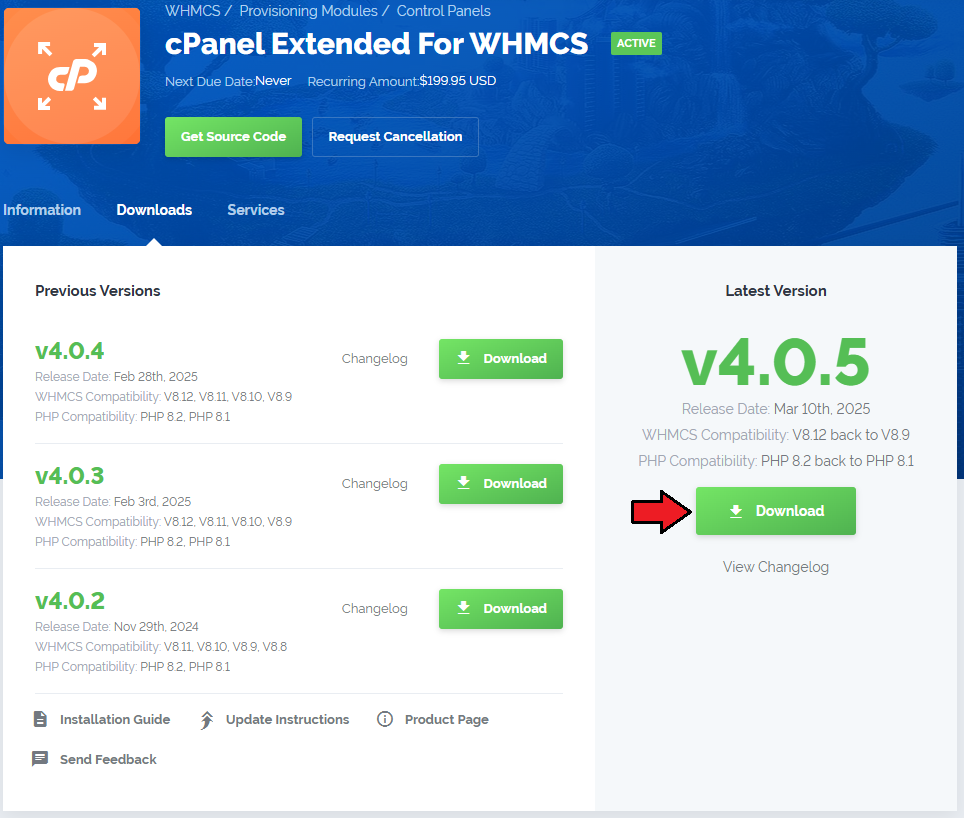
|
| 2. In the downloaded file you might find one or two packages that support different PHP versions. In the most recent versions of the module, you will find only one package that supports PHP 7.1 and later. |
| Previous updates of the module may contain two packages dedicated to various PHP versions. The first one that supports PHP 5.6 up to PHP 7.0, and the second one addressed to PHP 7.1 up to PHP 7.3. |

|
| Important: This situation does not affect the open source version of this module which can be applied to any PHP from version 5.6 and later. Note: You can check the current PHP version in your WHMCS. To do so, proceed to 'Utilities' → 'System' → 'PHP Info'. |
| 3. Once you have chosen the package with the right PHP version, extract it and upload its content into the main WHMCS directory. The content of the chosen PHP version files to upload should look like this. |
| 4. When you install cPanel Extended For WHMCS for the first time, you have to rename the 'license_RENAME.php' file. The file is located in 'modules/servers/cpanelExtended/license_RENAME.php' . Rename it from 'license_RENAME.php' to 'license.php' . |
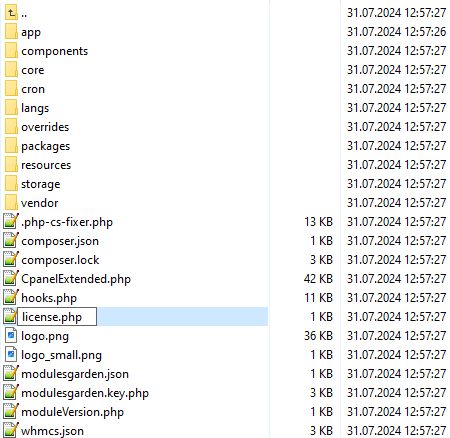
|
| 5. In order to configure your license key, you have to edit the previously renamed 'license.php' file. Enter your license key between the quotation marks as presented on the following screen. You can find your license key in our client area → 'My Products' . |

|
| 6. In the next step, set up the 'storage' folder as recursively writable. This folder is available at two locations:
|
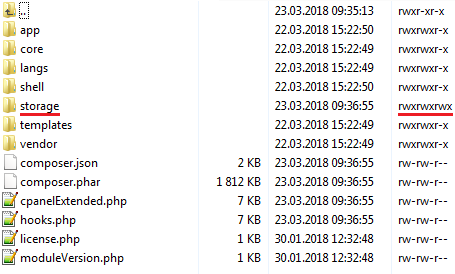
|
Activation of Addon
| 7. Now you have to activate the module in your WHMCS system. Log in to your WHMCS admin area. Click 'Setup' and find 'Addon Modules'. |
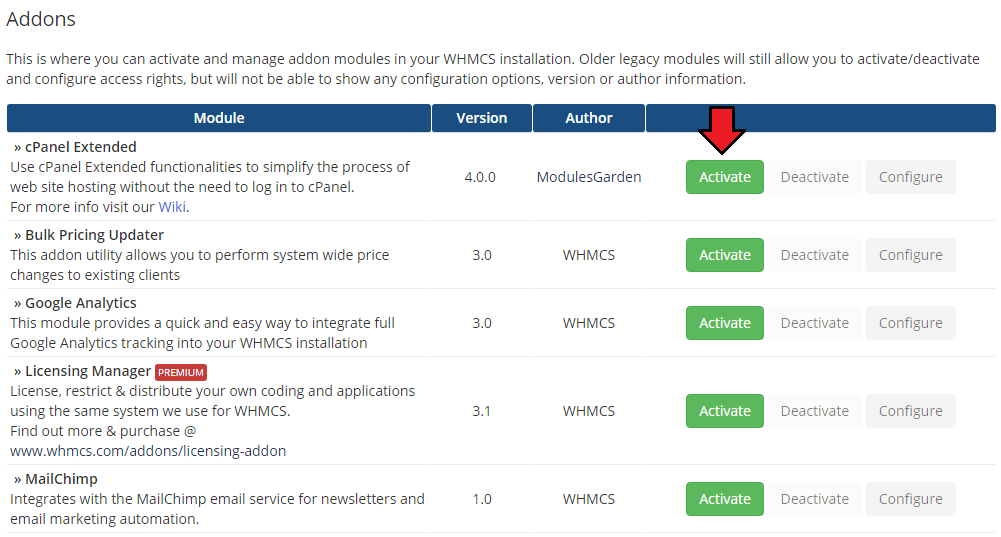
|
| 8. In the next step you need to permit access to this module. To do so, click on the 'Configure' button, tick the desired admin roles and press 'Save Changes'. |
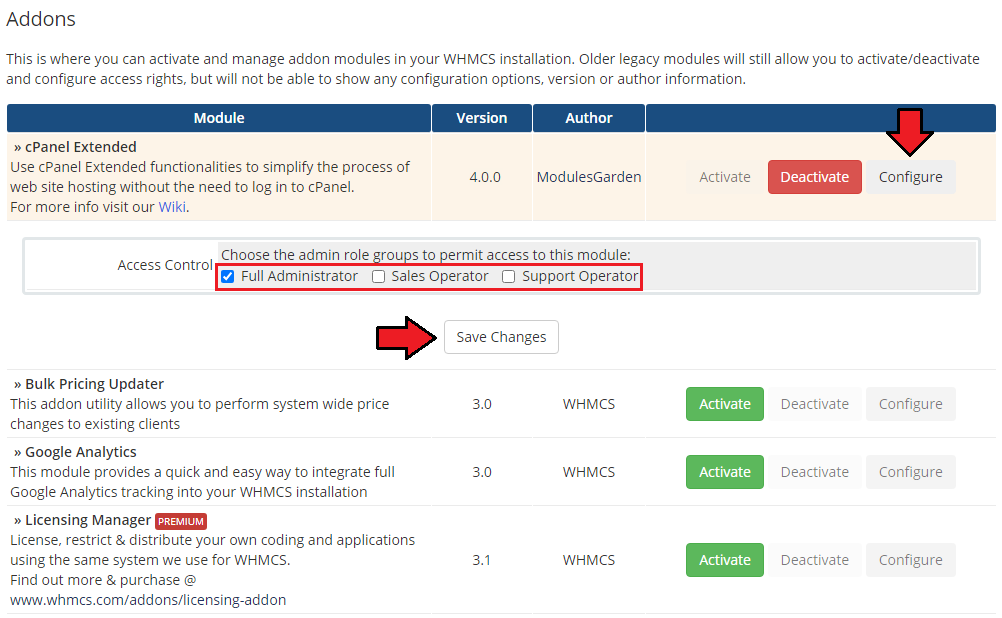
|
| 9. cPanel Extended For WHMCS has been successfully installed! Access the addon under 'Addons' → 'cPanel Extended Center'. |
Configuration of Server
| 10 To begin, you must add a new server. Go to 'Setup' → 'Products/Services' → 'Servers' and press 'Add New Server'. |
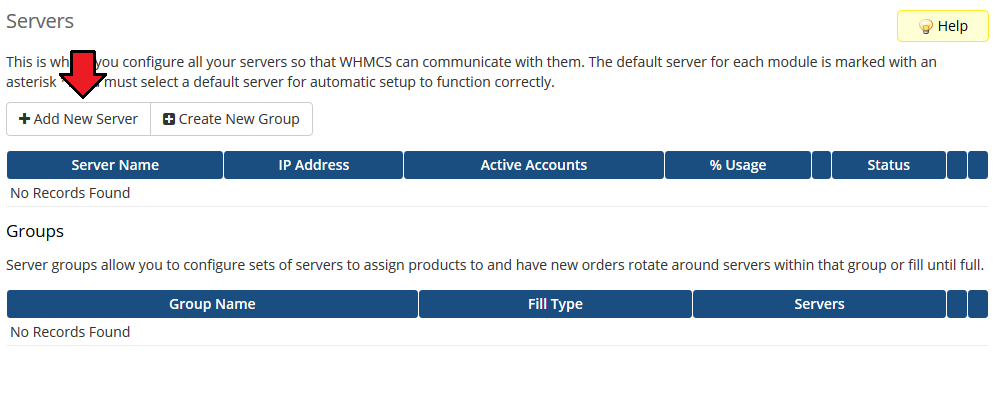
|
| 11. Enter your server name, IP address, username and a password. Choose 'cPanelExtended' from the dropdown menu and press 'Save Changes'. If you connect with your cPanel server via SSL, then make sure that you checked the 'Secure' field located at the bottom of the page. |
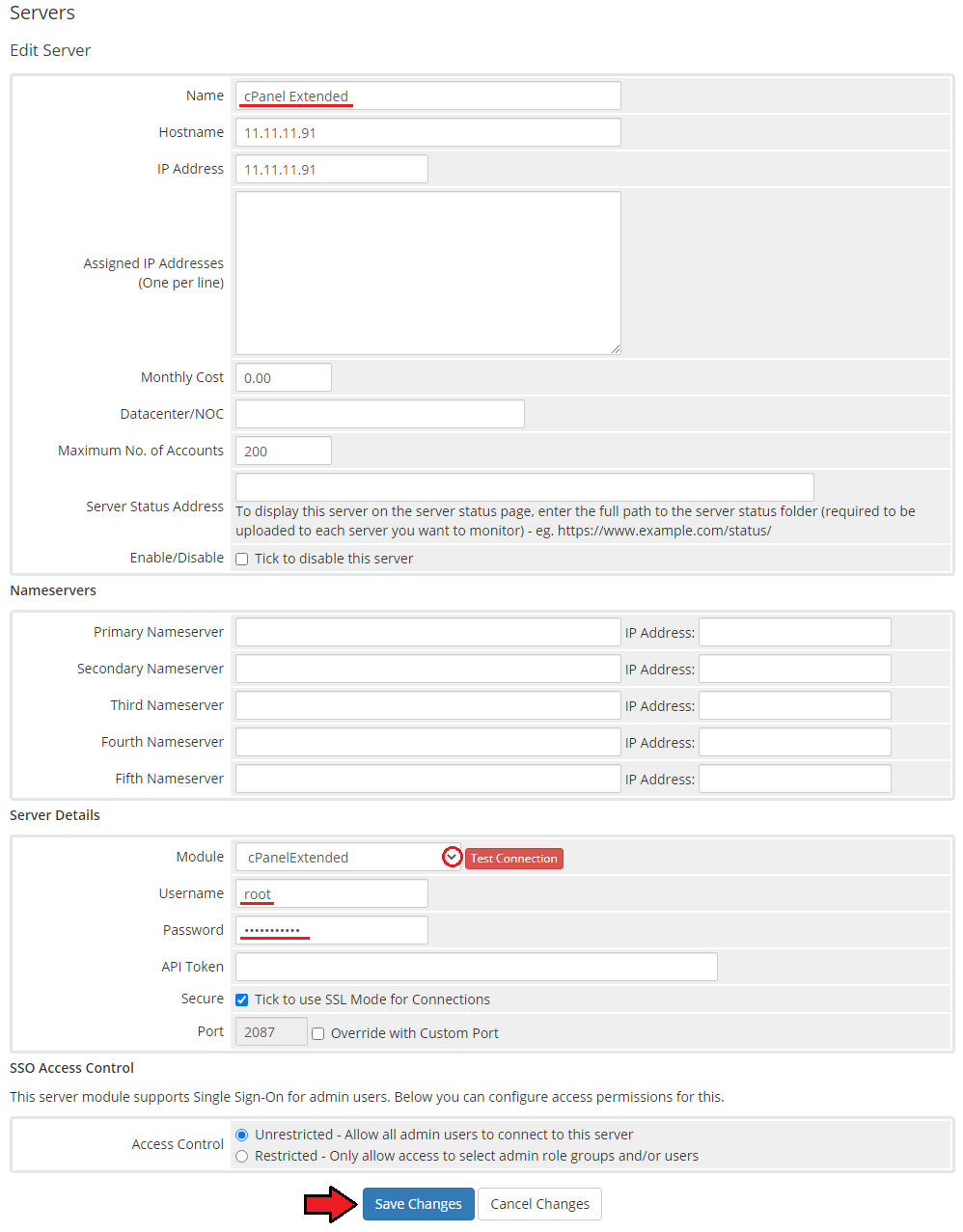
|
| 12. Once your server has been configured correctly, you will see a following screen. Create a new group for your server. Press 'Create New Group' to proceed. |
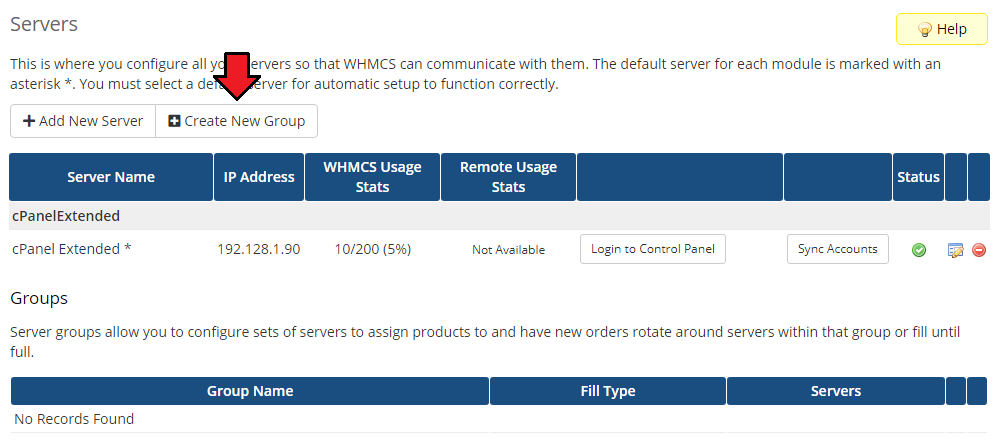
|
| 13. Enter the group name, select your previously created server, press 'Add', and then 'Save Changes'. |
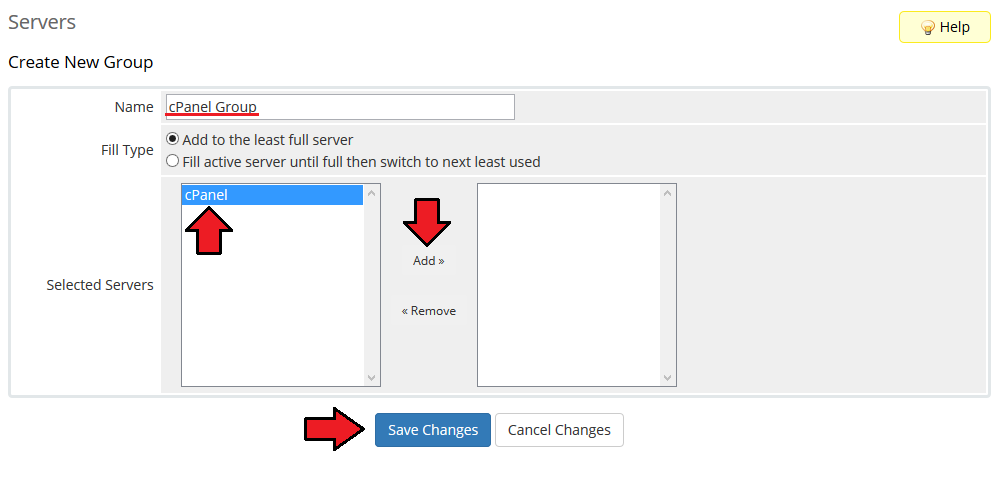
|
Configuration of Product
| 14. In order to create a product, go to 'Setup' → 'Products/Services' → 'Products/Services' . If you do not have a product group, click on 'Create a New Group' . If you do, simply skip step 13. |

|
| 15. Fill in a product group name and press 'Save Changes'. |
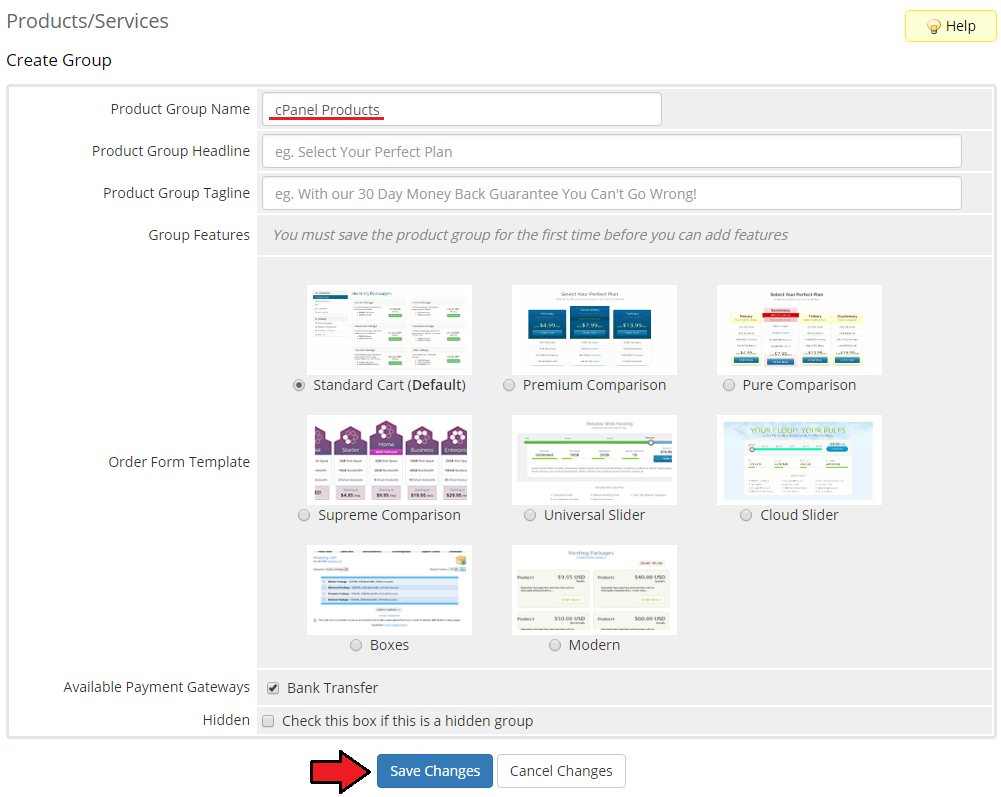
|
| 16. When you have a product group added, you can create your product and assign it to the cPanel Extended module. |

|
| 17. Afterwards, choose your product type and product group from dropdown menus, then enter your product name select the used module: 'cPanel Extended'. Press 'Continue' to continue. |
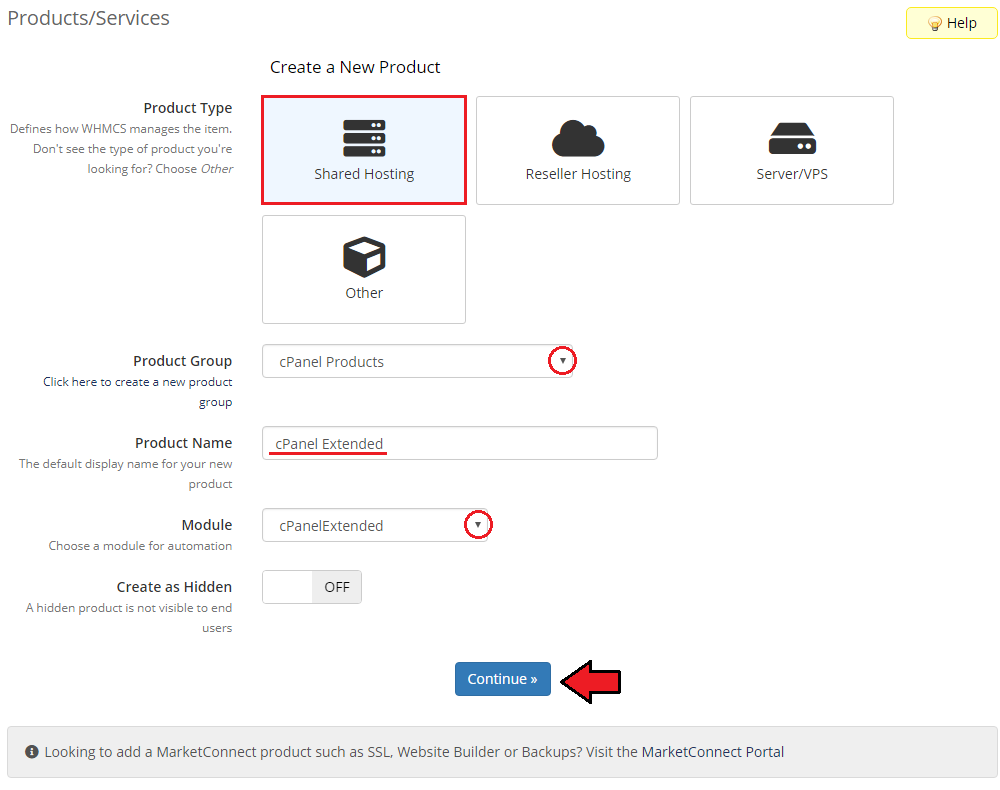
|
| 18. Now, go to the 'Module Settings' section, choose the previously created server group from dropdown menu and press 'Save Changes' . Important: Setting cPanel theme is required for some features to work properly. |
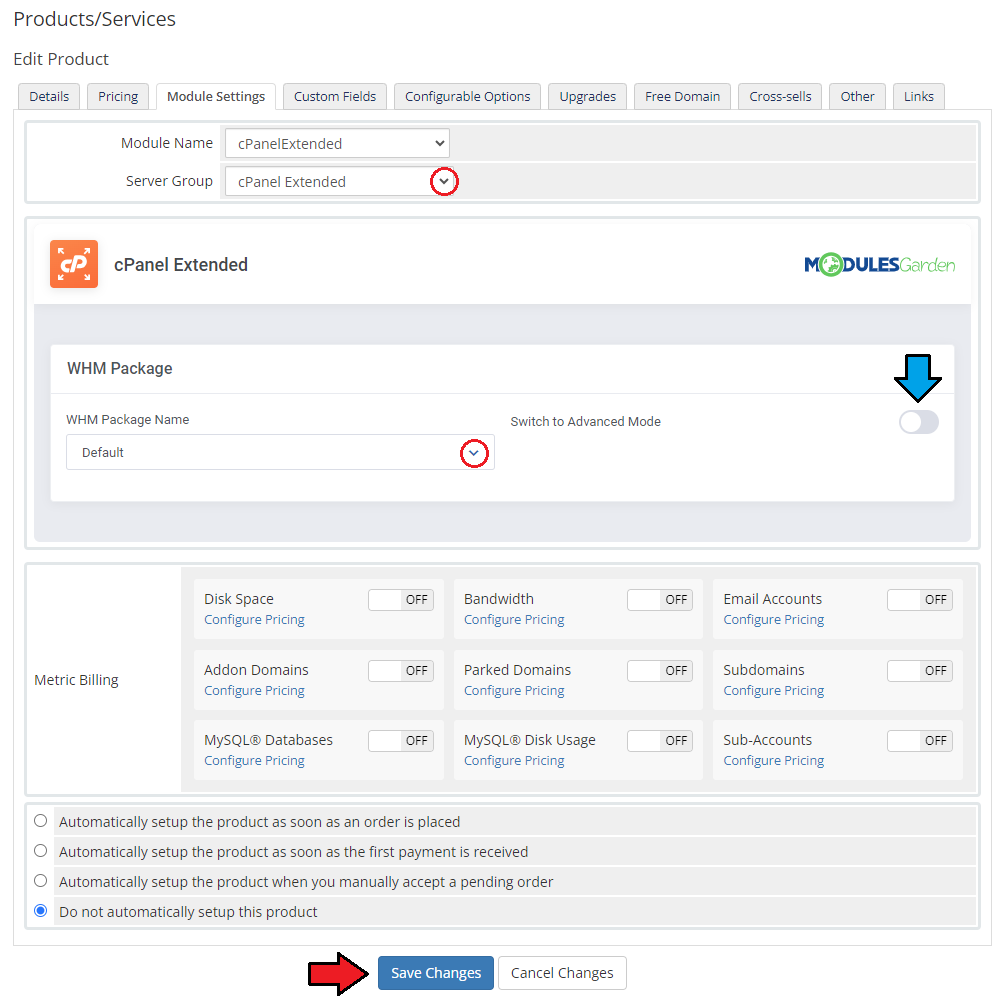
|
| 19. If you want to enable CloudLinux features for your product, simply select this option. Now, you can put limits for your clients' resources regarding:
|
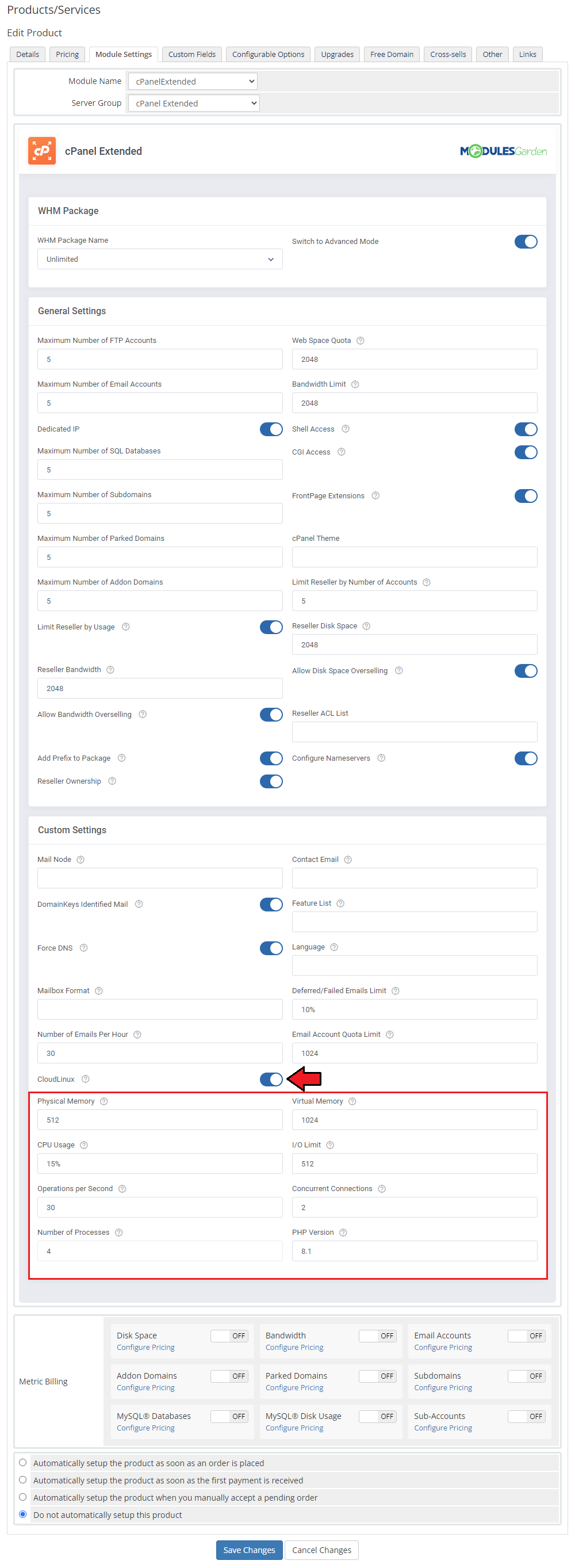
|
| If you want to use the above cPanel entries as configurable options, please follow the guide available at this article. Additionally, you can use the records for CloudLinux from the list below: speed|CPU Speed pmem|Physical Memory io|I/O Limit maxentryprocs|Concurrent Connections nproc|Number of Processes vmem|Virtual Memory iops|Operations Per Second |
Configuration of Addon
| 20. You have just correctly created and customized a new product. Go to 'Addons' → 'cPanel Extended' in your WHMCS. You will find there a dashboard with the possibility to:
|
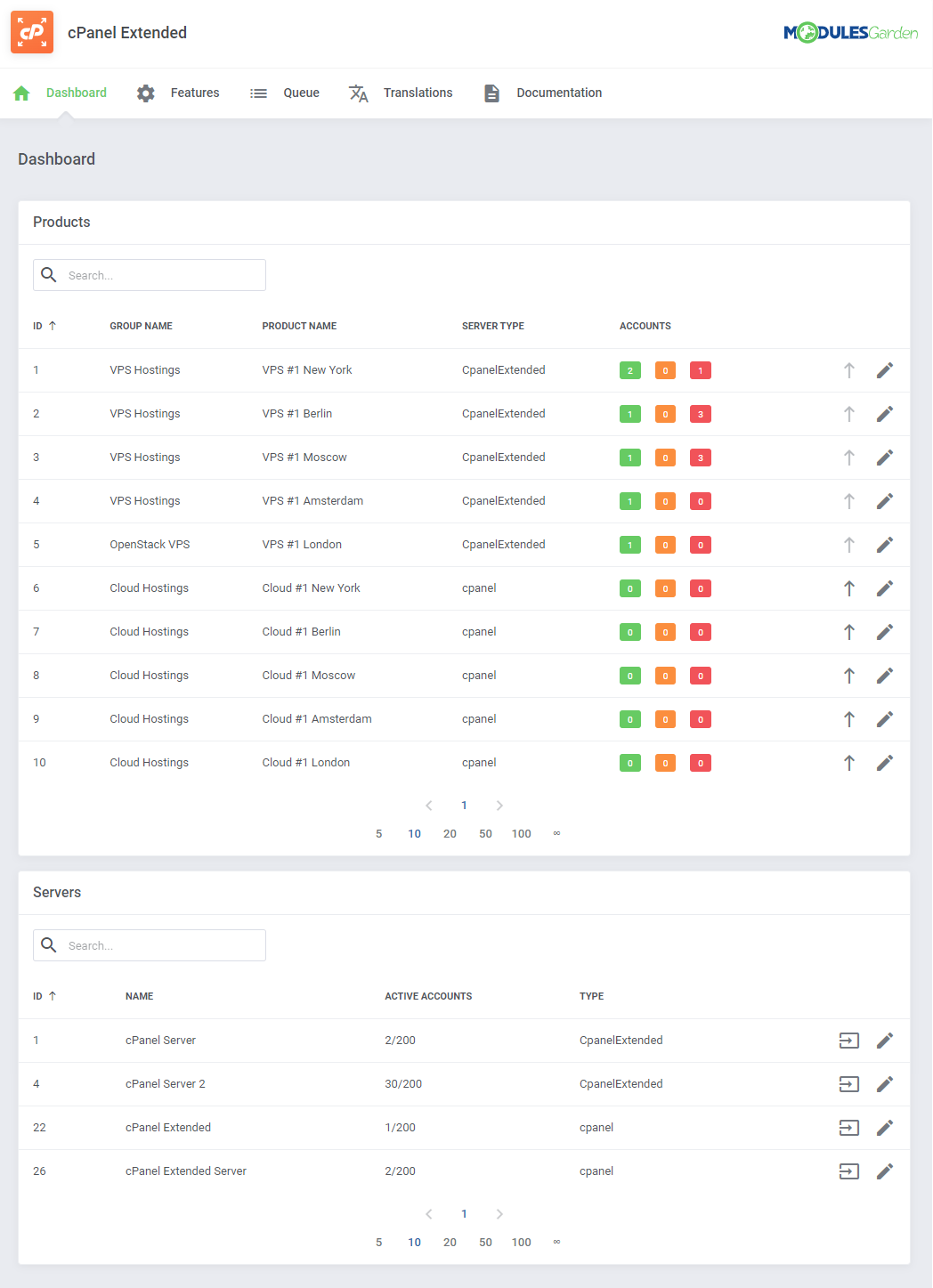
|
| 21. Proceed to the 'Features' section and find the product you are interested in and press the 'Configuration' button next to it. |
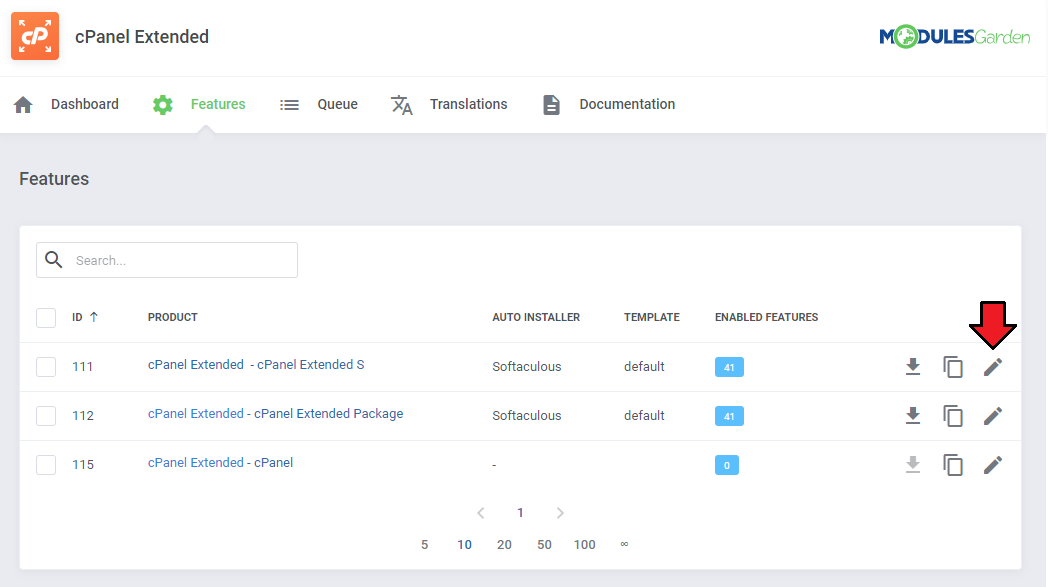
|
| 22. You should find here boxes dedicated to 'Features', 'Applications', 'Client Area Template'. To show you an example, we will set the configuration from the beginning, without using other configuration options of the product. |
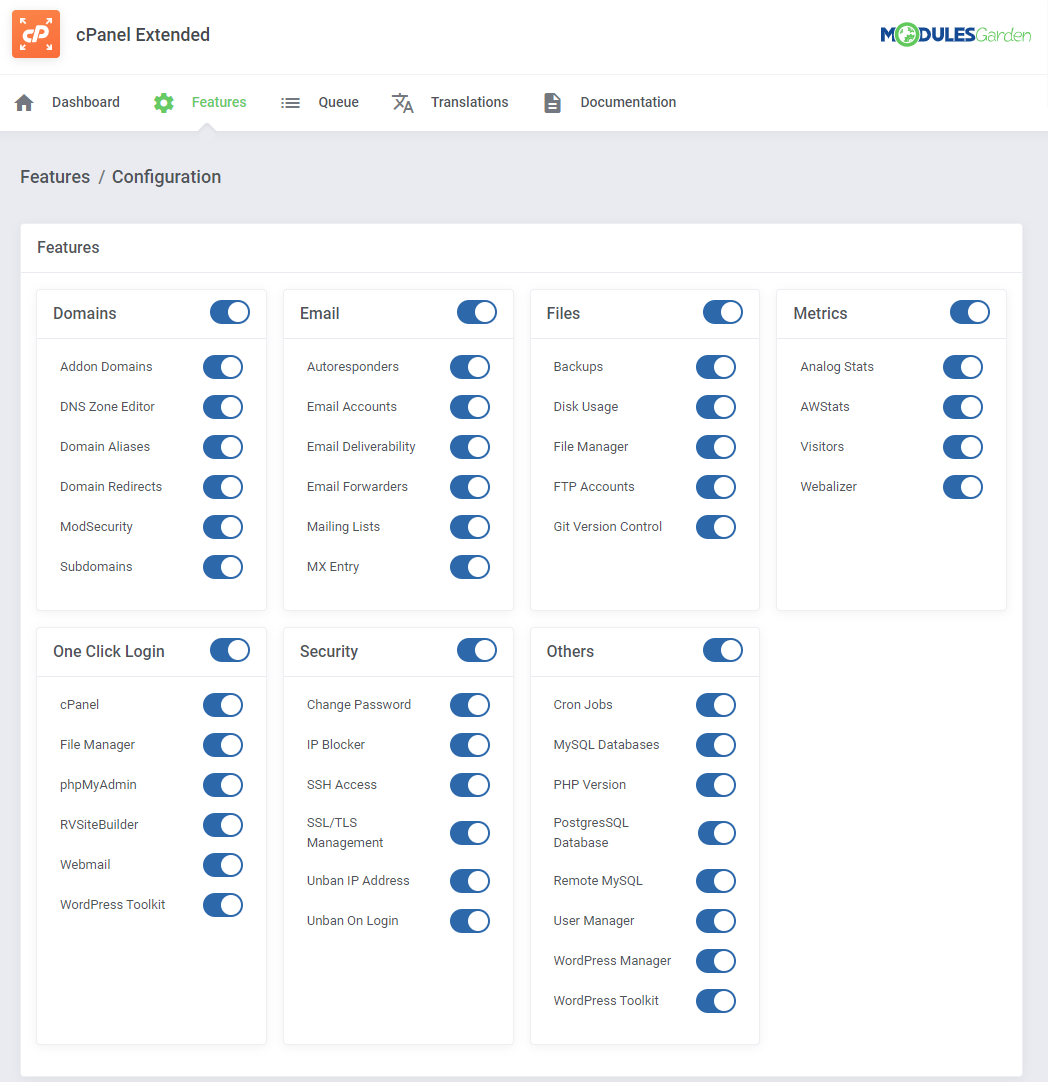
|
| 23. Choose whether to activate the 'Install Applications' option. In case you wish to activate this option, you will have to select 'Auto Installer' from the dropdown menu. Afterwards, enable 'Install Tab' and 'Backup Tab'. |
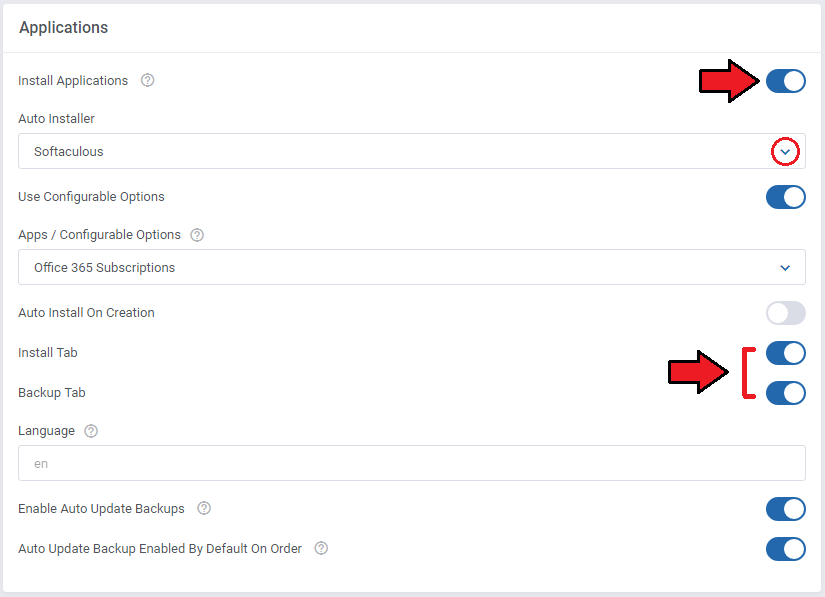
|
| 24. Select from the dropdown menu which client area template shall be used for this product. Note: By default only one template is available. If you have more templates prepared, you will be able to choose one from here. |
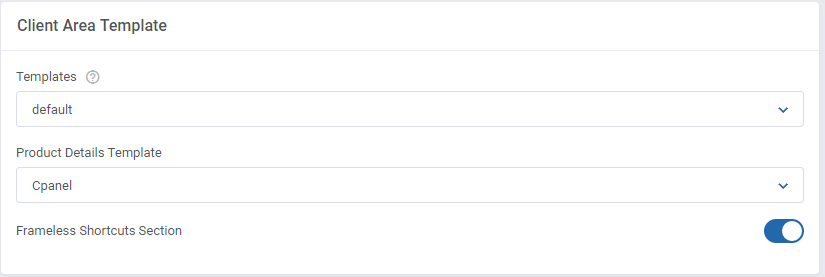
|
| 25. Finally, decide whether to allow your clients to create email accounts with an unlimited quota. If you disable this option here, you may then set the quota limit per created account. |

|
| 26. If you already have another product configured, you may copy its configuration. Find the 'Copy' button on the list with products or select multiple item at once. |
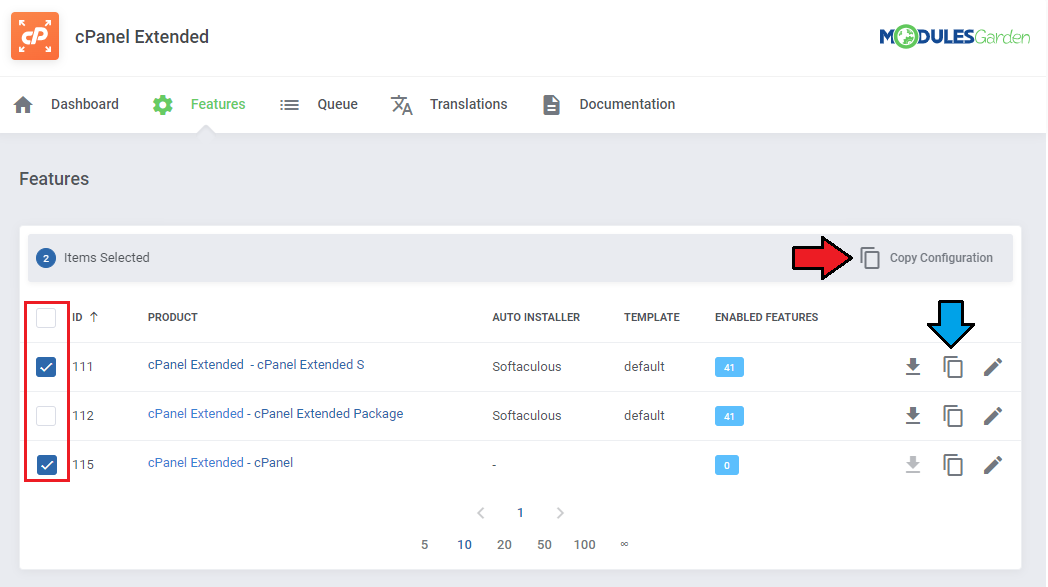
|
| 27. From now on, all your clients who ordered a previously created product will be able to manage their cPanel accounts via your WHMCS system. The screen below presents a summary view of the ordered product in admin area. Among the available actions you will find:
|
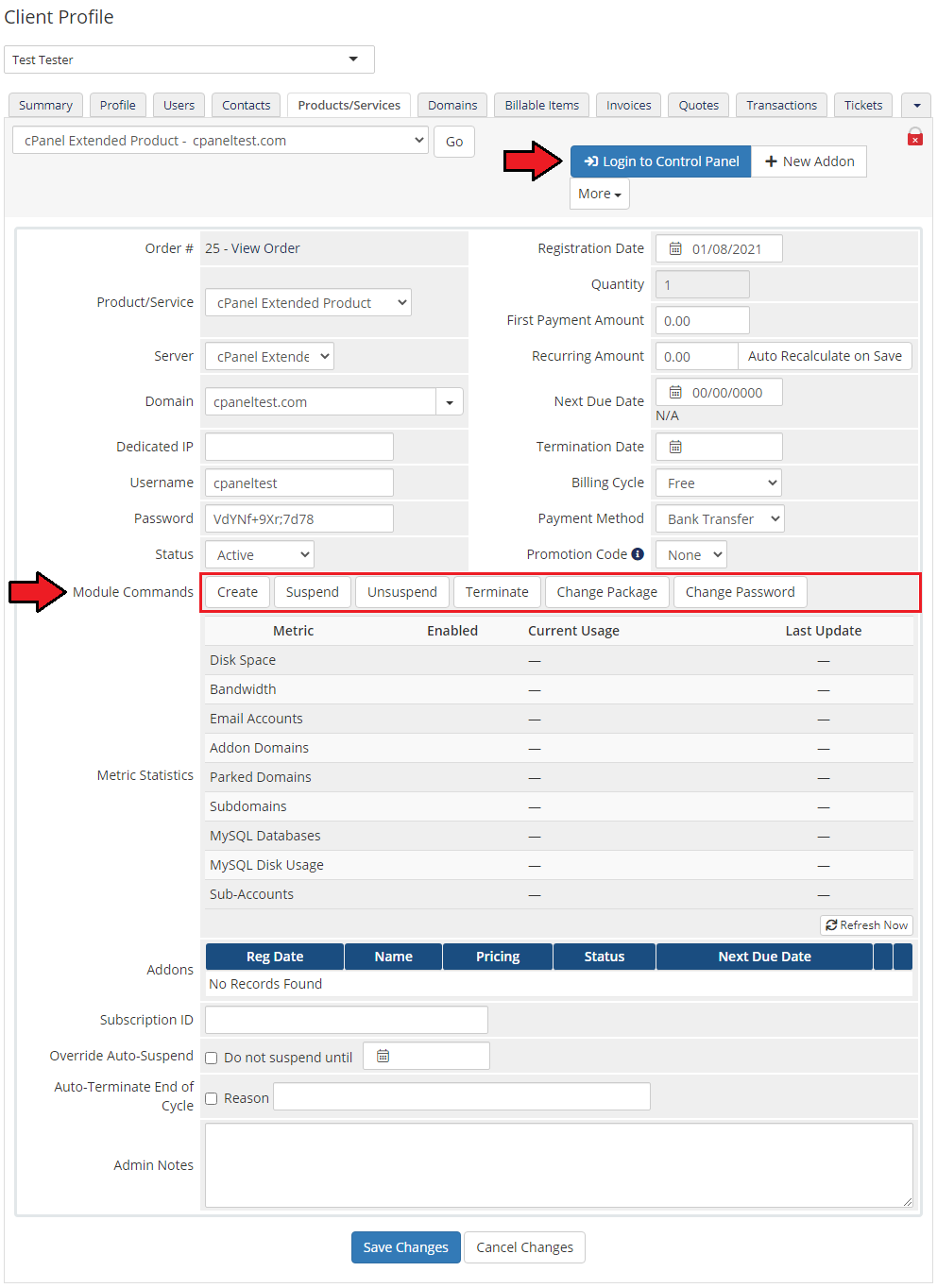
|
| This is what your customers should see in their client area: |
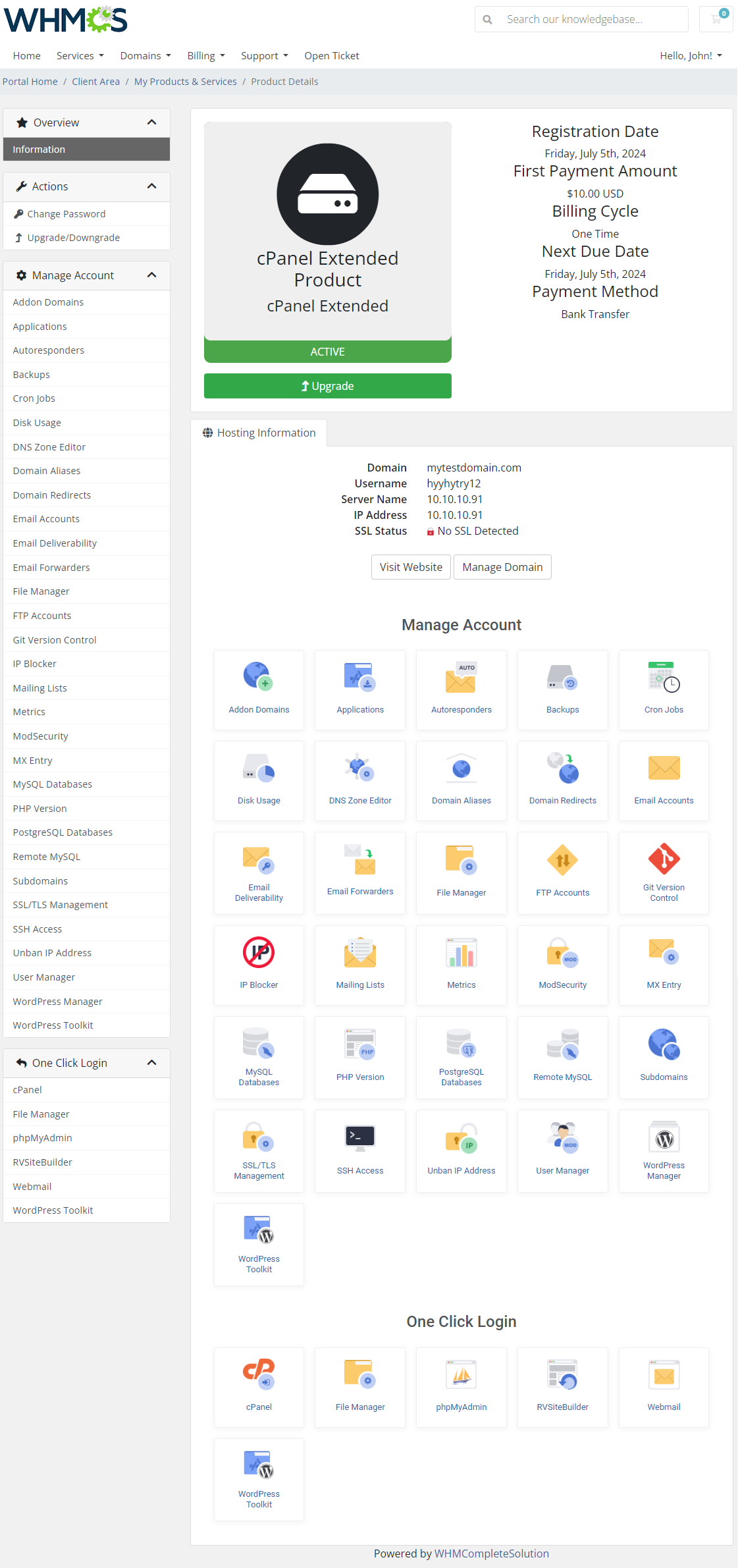
|
| Please note that the 'WordPress Manager' icon only appears if you have WordPress Manager For WHMCS module installed. |
Upgrade cPanel to cPanel Extended Product
| Once you have already configured the standard cPanel products, you can easily upgrade them to the cPanel Extended products. Note: Before you start, make sure that you have already configured the cPanel Extended server. |
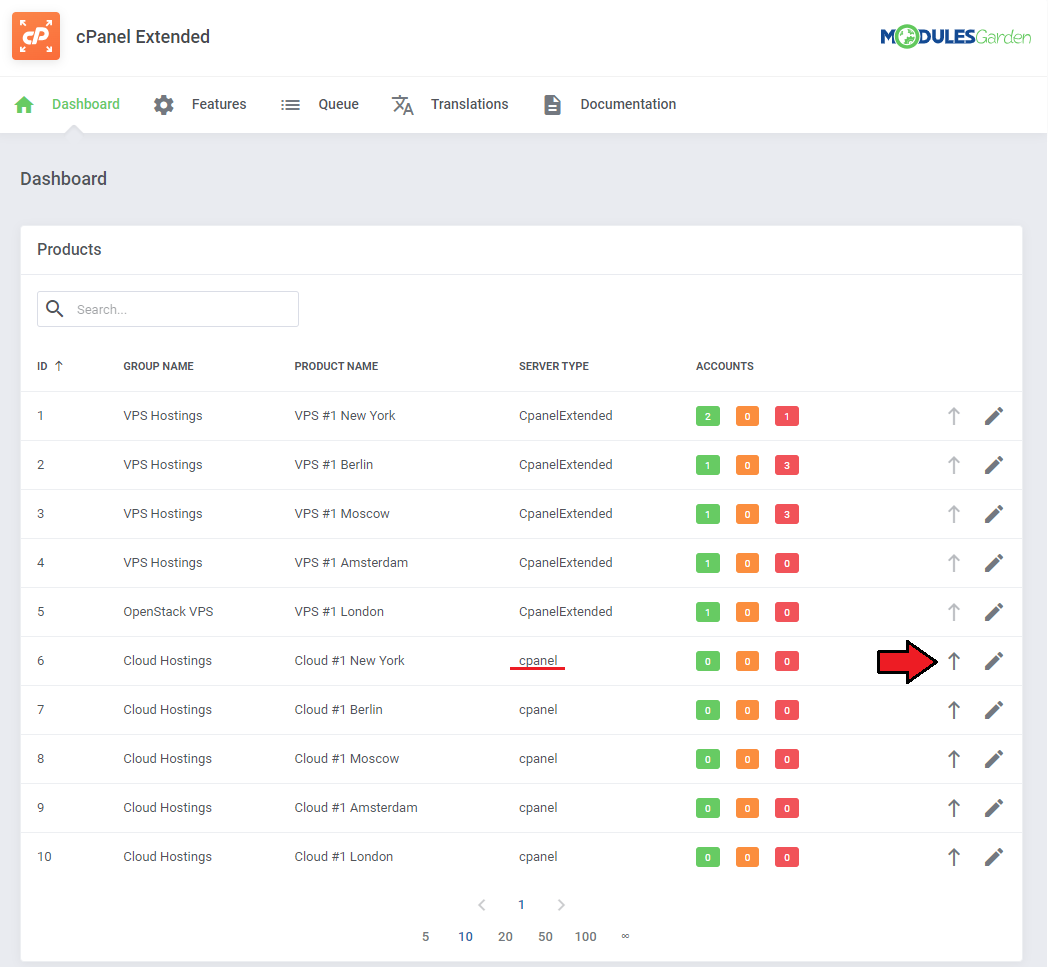
|
| Now, select the new server group configured for the cPanel Extended module.
Note: Make sure that this server configuration is exactly the same as the standard cPanel server configuration. |
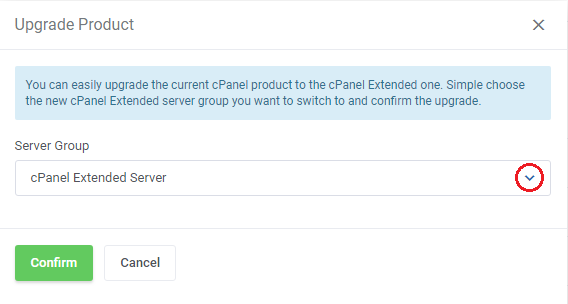
|
Management
| cPanel Extended For WHMCS allows your customers to manage their cPanel accounts without being logged into the cPanel server. Read the below descriptions to get familiar with all of the cPanel Extended For WHMCS functionalities. |
Configurable Options For Application Auto Install
| Let your clients decide which application they would like to install on their new cPanel account. While placing an order, your customer can choose an application which will be installed upon account creation. |
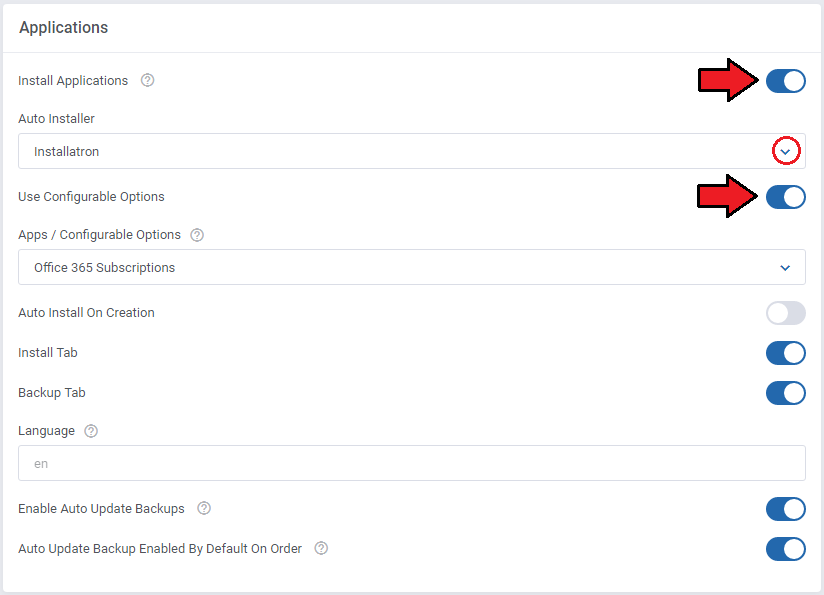
|
| Go back to the list of products and click on a download icon to view the applications list. |
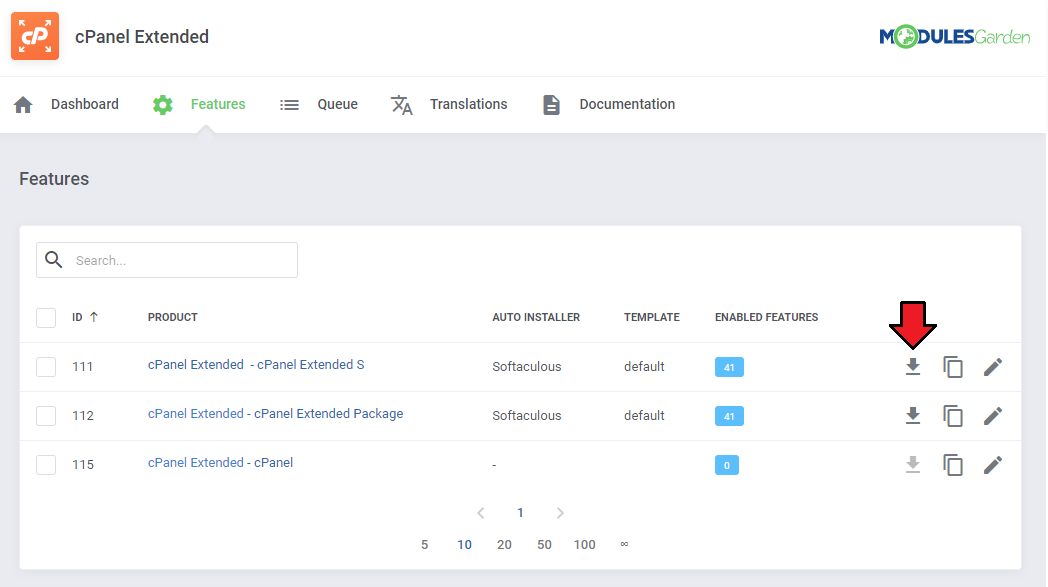
|
| These are the names of values that you can enter in the fields of configurable options. We will configure them in the next step. For example, if you would like to set up 'Drupal' in your applications list, you will need to enter the 'Drupal 8.6.2' or 'Drupal' value. |
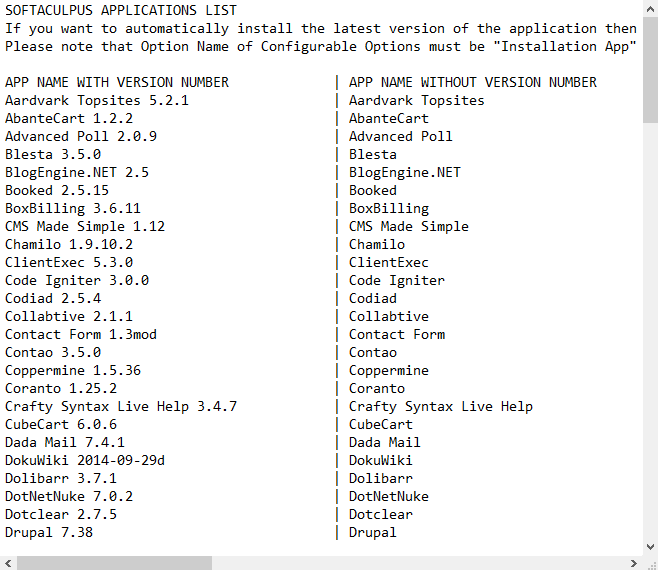
|
| Go to your 'WHMCS' → 'Setup' → 'Products/Services' → 'Configurable Options' and press 'Create a New Group' . |

|
| Enter the group name of your choice, select the product to which you want to assign configurable, then press 'Save Changes' . |
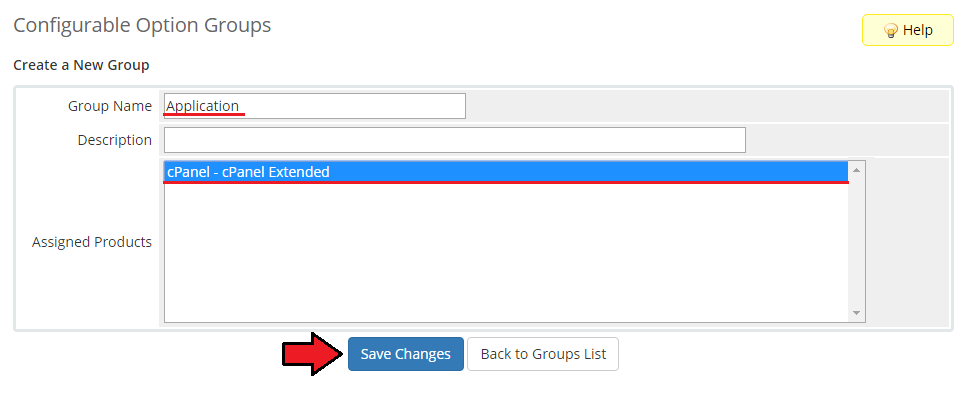
|
| Now click on 'Add New Configurable Option' . |
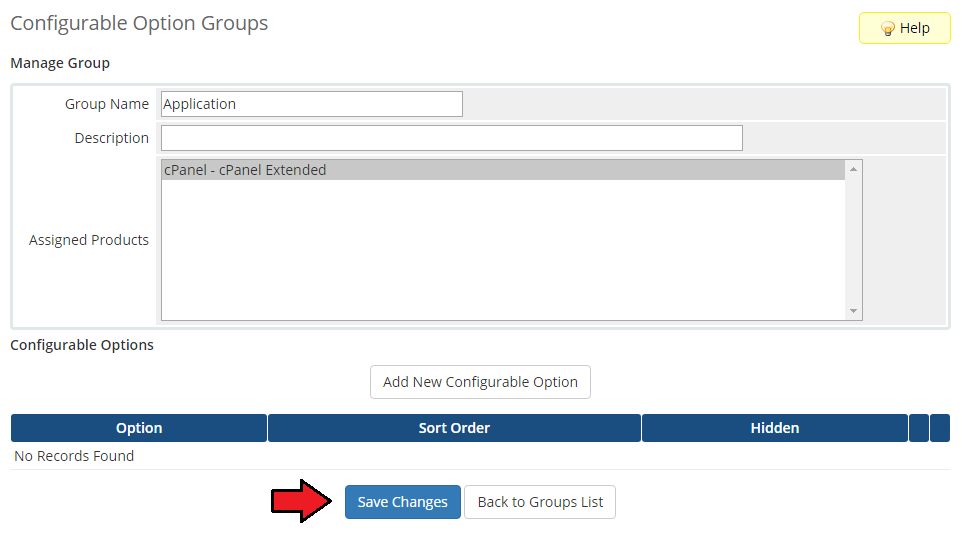
|
| This moment is very important. As 'Option Name' , you have to enter 'Installation App' . Otherwise the entire functionality will not work. Here you can set up as many applications as you want. To do so, enter a value name, e.g. 'WordPress 3.7.1' and press 'Save Changes' . |

|
| As you can see on the following screen, we decided to offer our customers five applications. When you finish adding applications, press 'Save Changes' and 'Close Window'. |
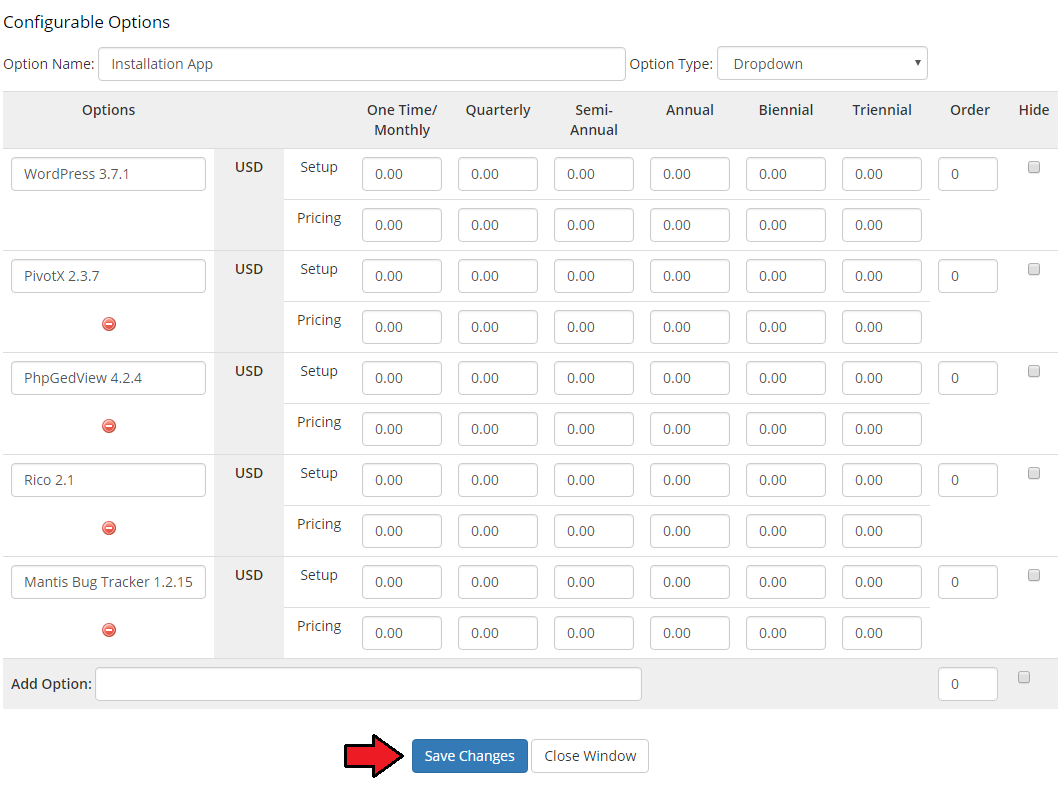
|
| Using the module's version above 3.1.0, you can also create a new configurable option - Auto Backup On Update with the 'Yes/No' type. This option is used to enable the creation of auto update backups for the first chosen application after the initial order in WHMCS. |

|
| Afterwards, come back to 'cPanel Extended Features' → 'Configuration' → 'Applications' , activate 'Use Configurable Options' and choose 'Apps/Configurable Options' from a dropdown menu. Please note that you can have more configurable options groups at your disposal. Press 'Save' . You have just successfully assigned configurable options to the application autoinstall. |
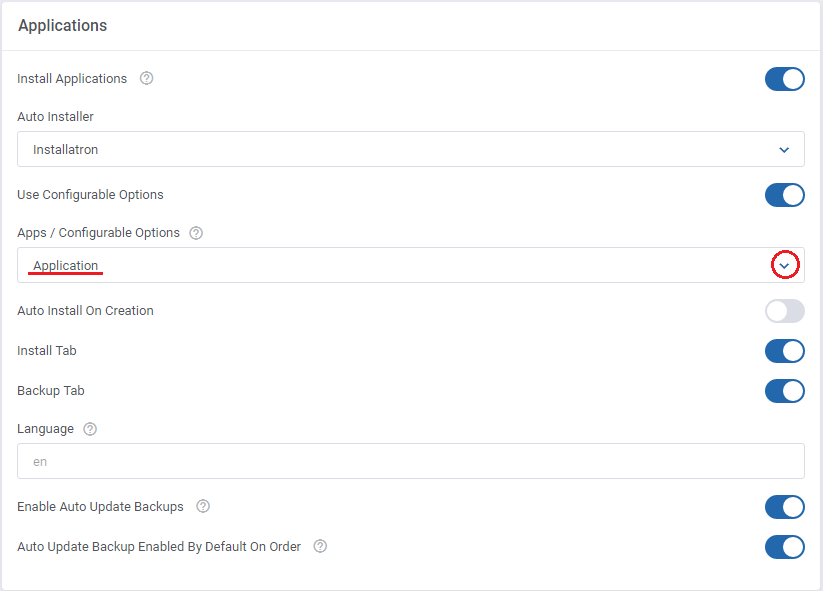
|
| Let us find out what your customers are going to see in your client area while placing an order. As you can see, a dropdown menu with the previously configured applications has shown up. |
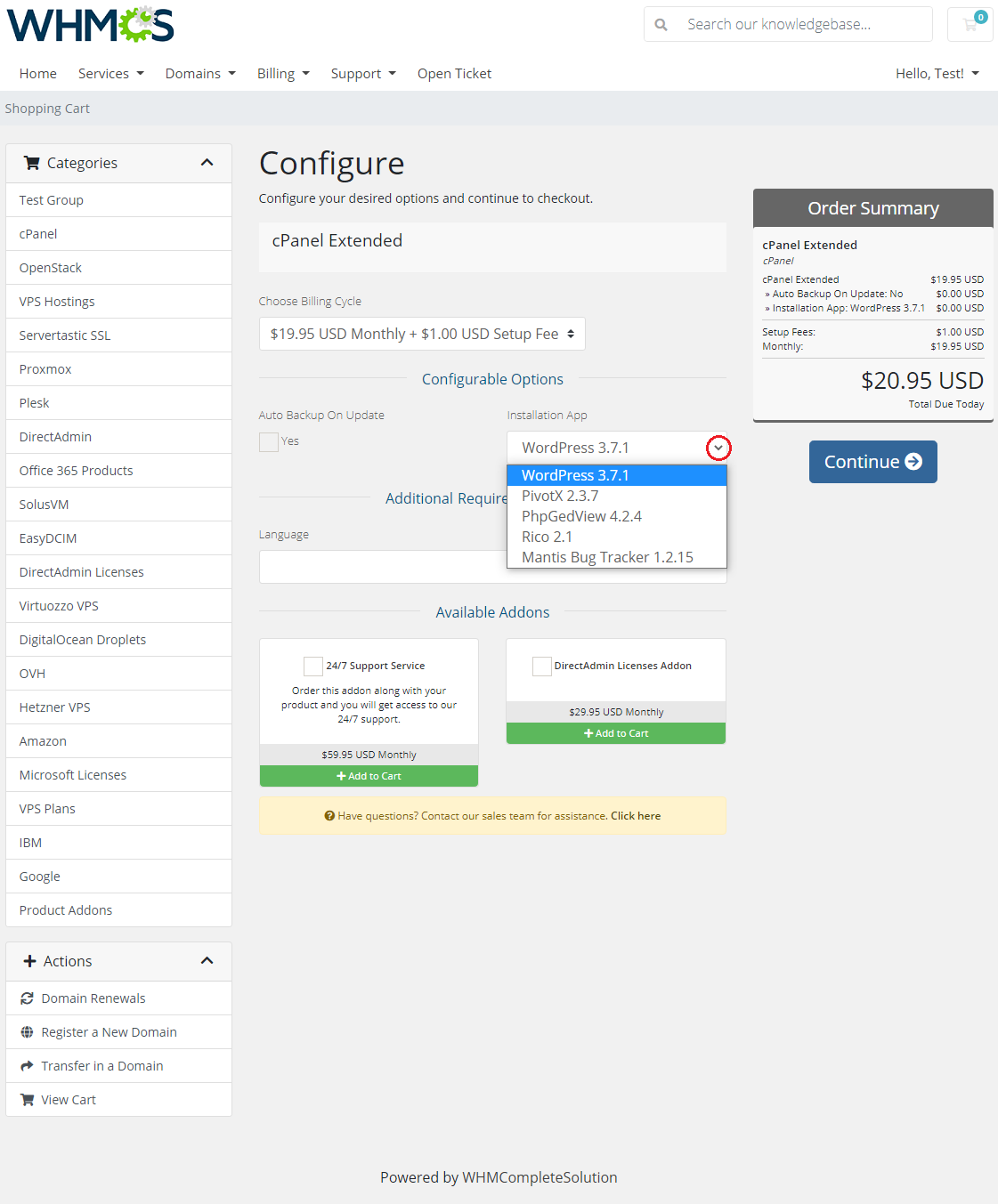
|
Assignment of Custom Fields To Application Autoinstall
| Now that you know how to allow your customers to choose which application they would like to install on their account, we can proceed one step further. Until now all applications have been installed with the use of default details like e.g. directory names or a database name.
Remember to set each field type as 'Text Box', tick 'Required Field ' and 'Show on Order Form'. |
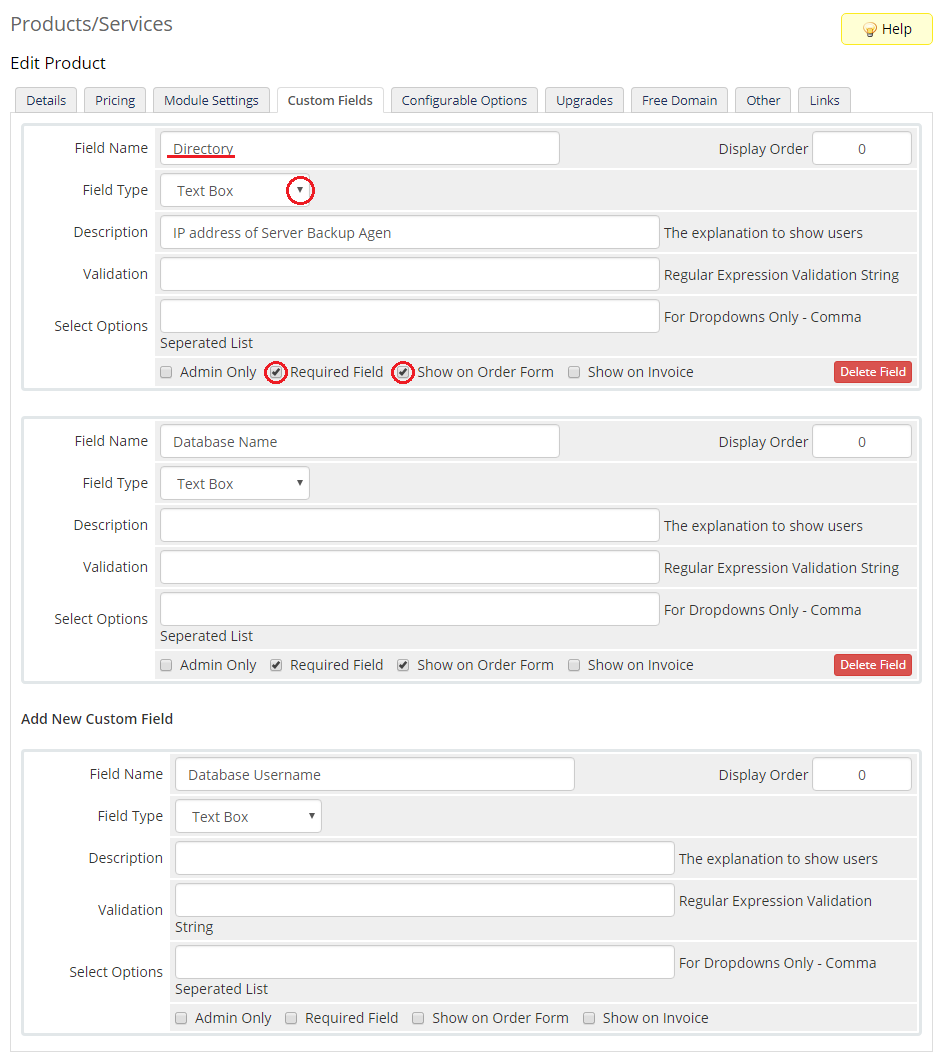
|
The next 3 fields are:
Set them as 'Text Box' and tick 'Show on Order Form'. |
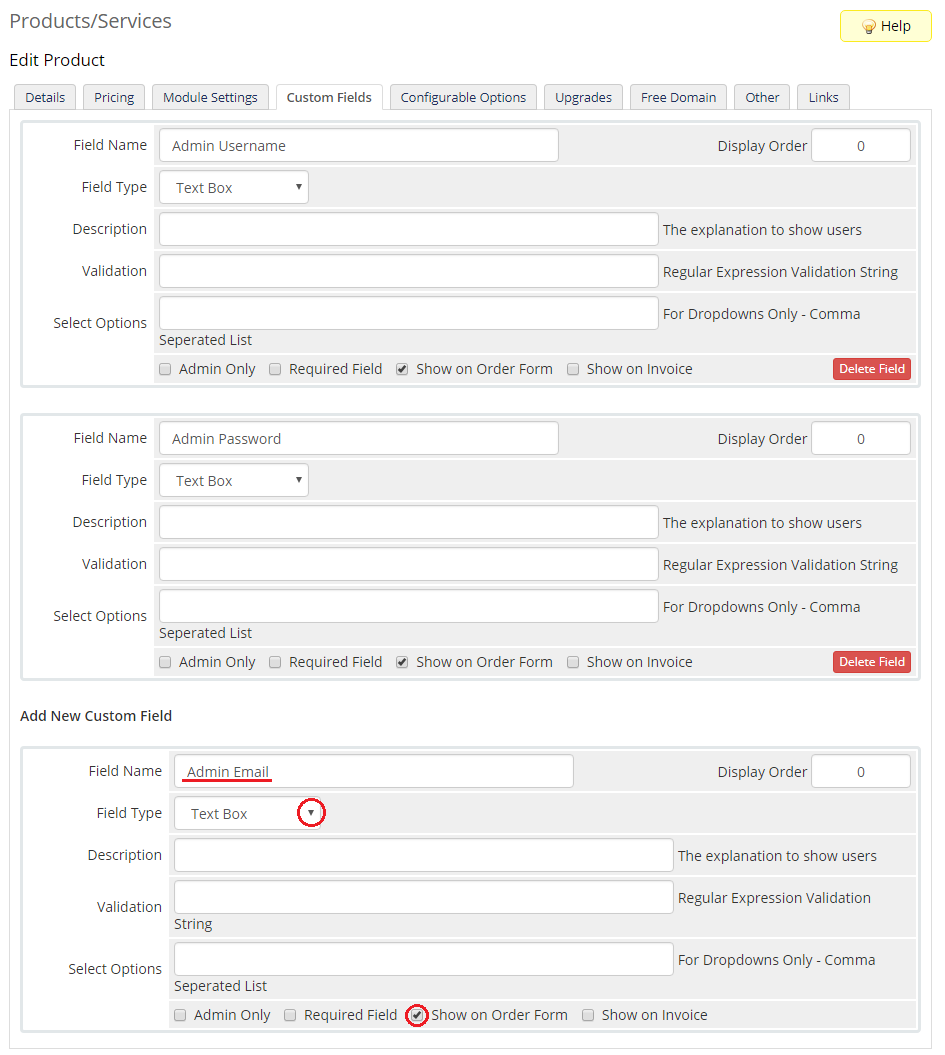
|
The last field is:
Set it as 'Drop Down', enter 'Yes, No' into 'Select Options', tick 'Required Field ' and 'Show on Order Form'. |
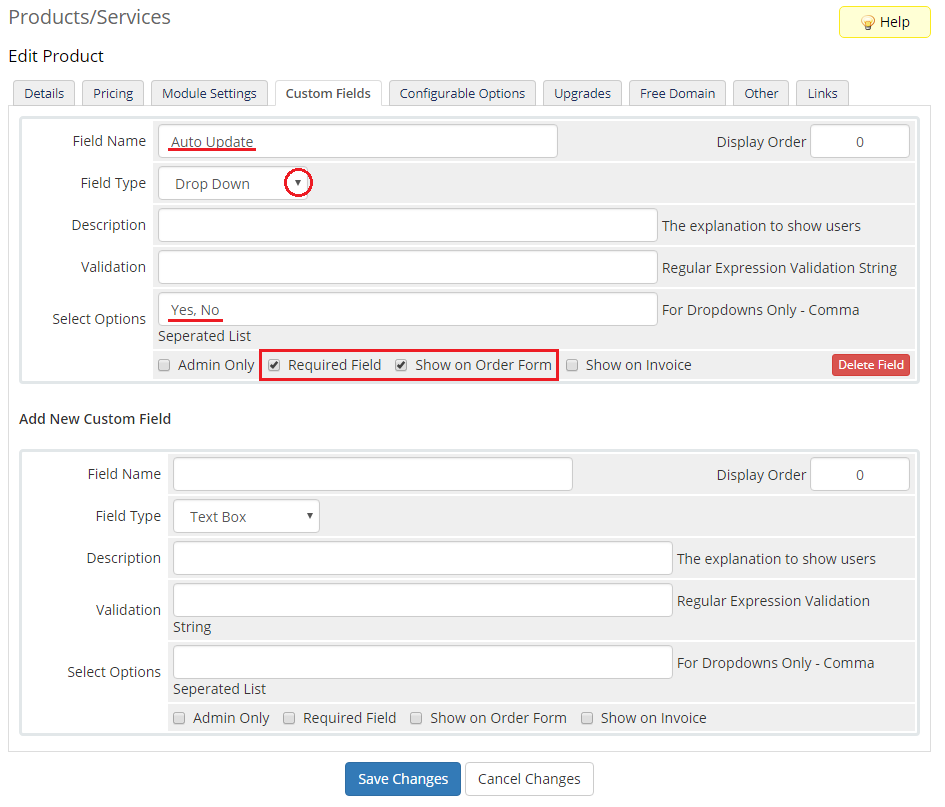
|
| Once you add all custom fields, they will appear while placing an order. Voila! Now your customers can personalize each application without the necessity of installing it later. |
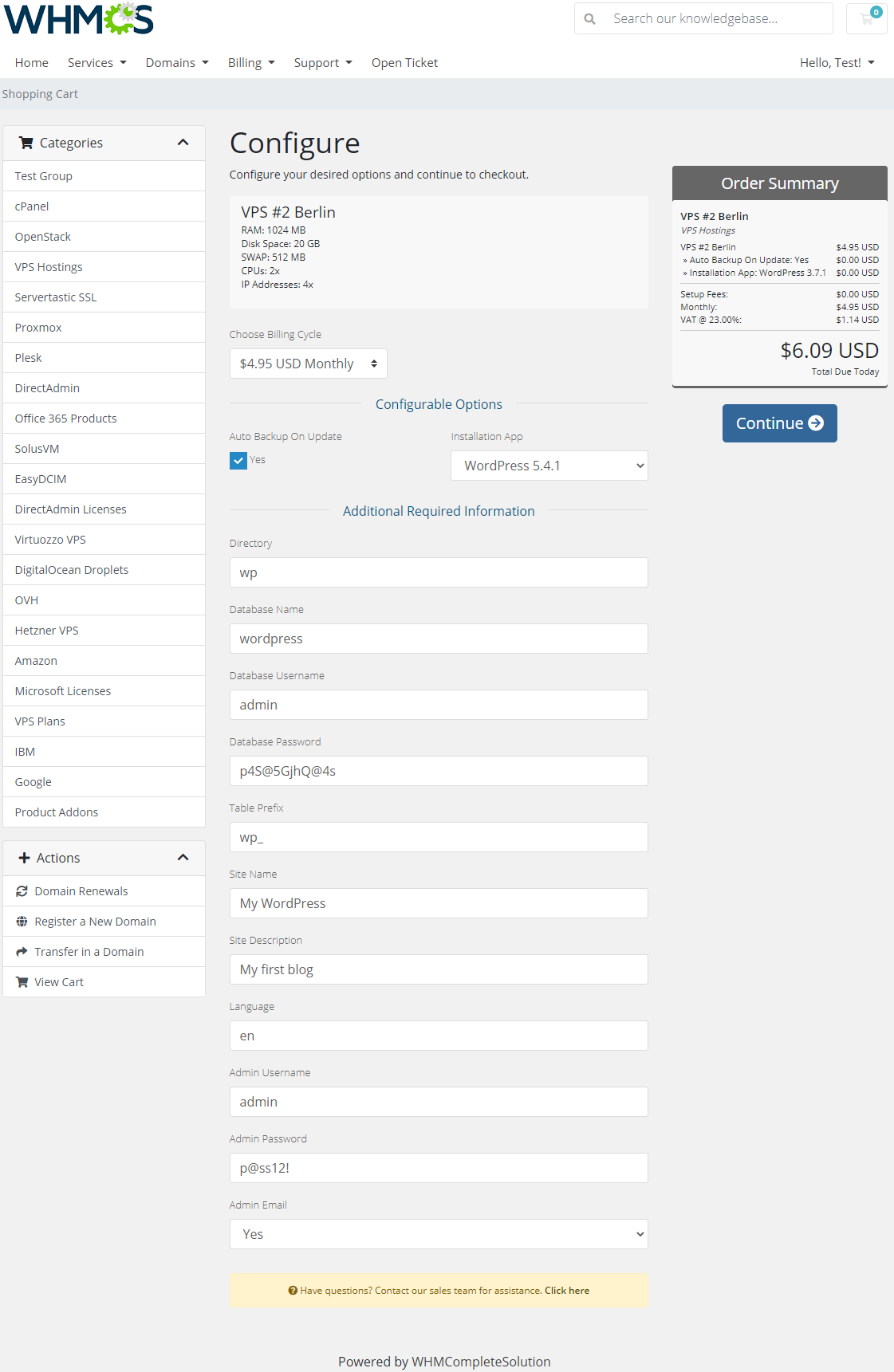
|
Custom Softaculous Application Language
| We will show you how to quickly set custom language for Softaculous web applications. For this purpose you need to add a new custom field for your product. The field should be called 'Language' . |
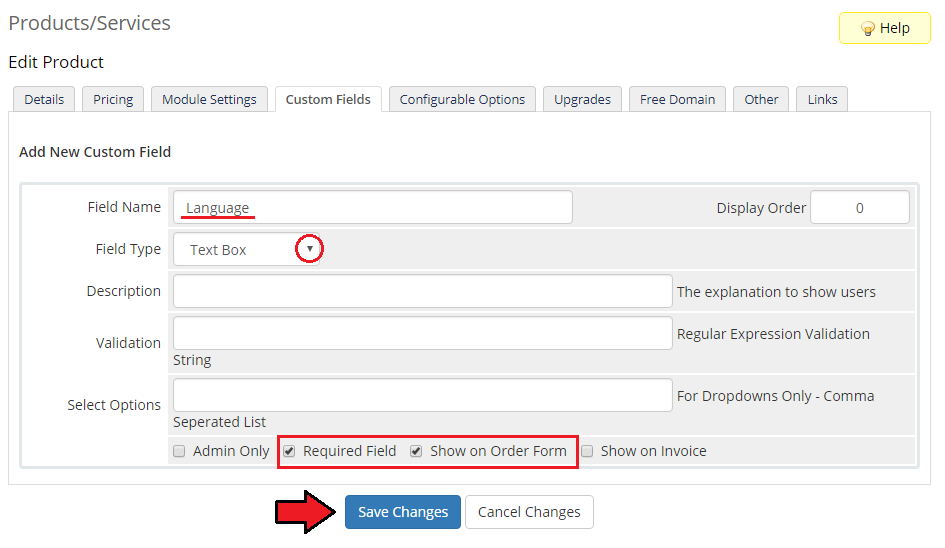
|
| Afterwards, go to your 'Products/Services' and check whether the 'Language' field has appeared. In order to change the default language of the application for an account, enter here an appropriate value. |
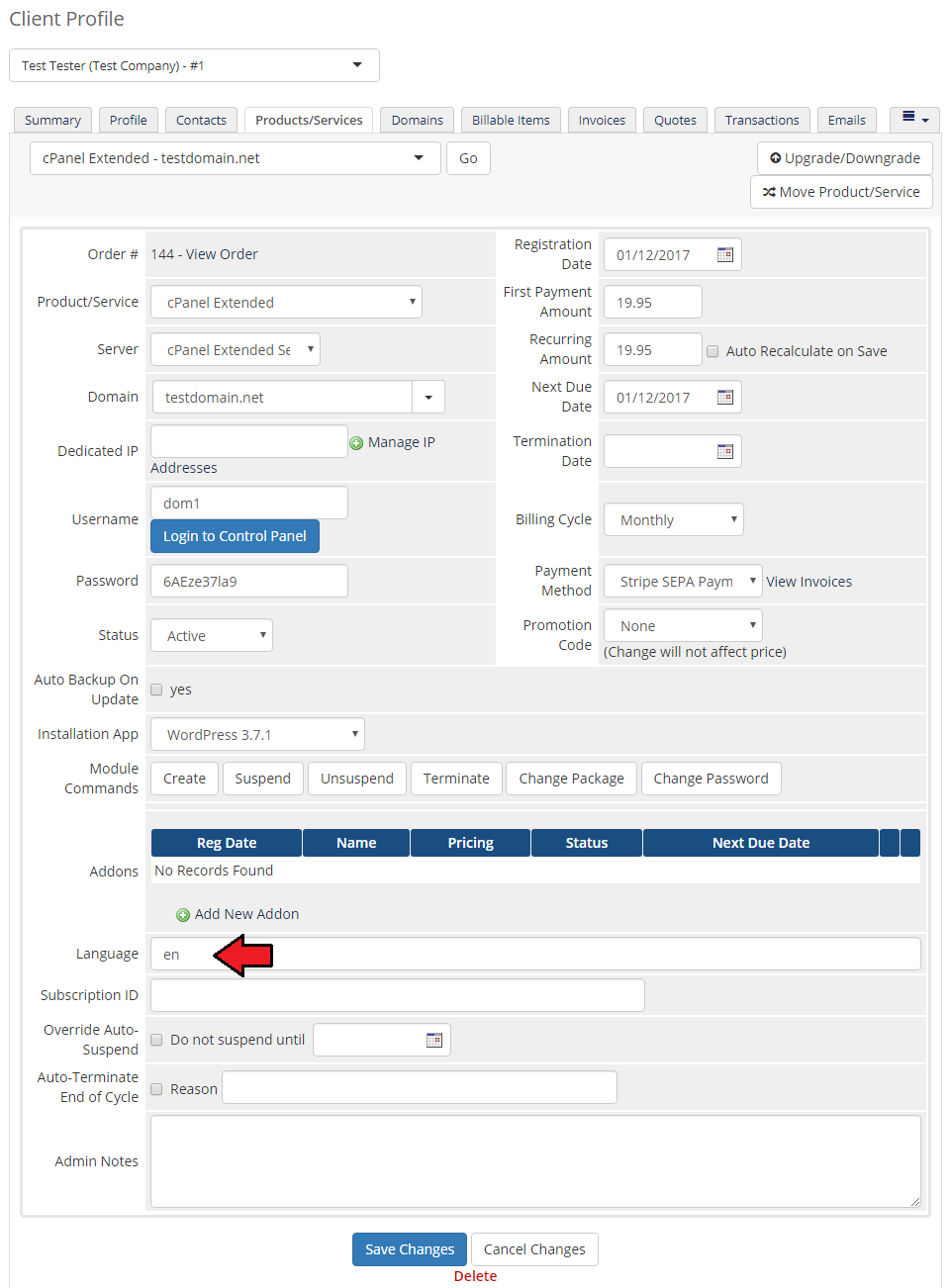
|
| From now on the just added language field will be visible to your customers as well. While installing a new application, they will be enabled to set a desired language by entering the appropriate value into the field. Here you will find a complete list of all language codes. |
Client Area
| In the following section features available in the client area will be thoroughly discussed. |
Addon Domains
| Addon domains allow you to link the domain to a subdirectory of your account. You can view and manage addon domains, edit document root and make redirections. |
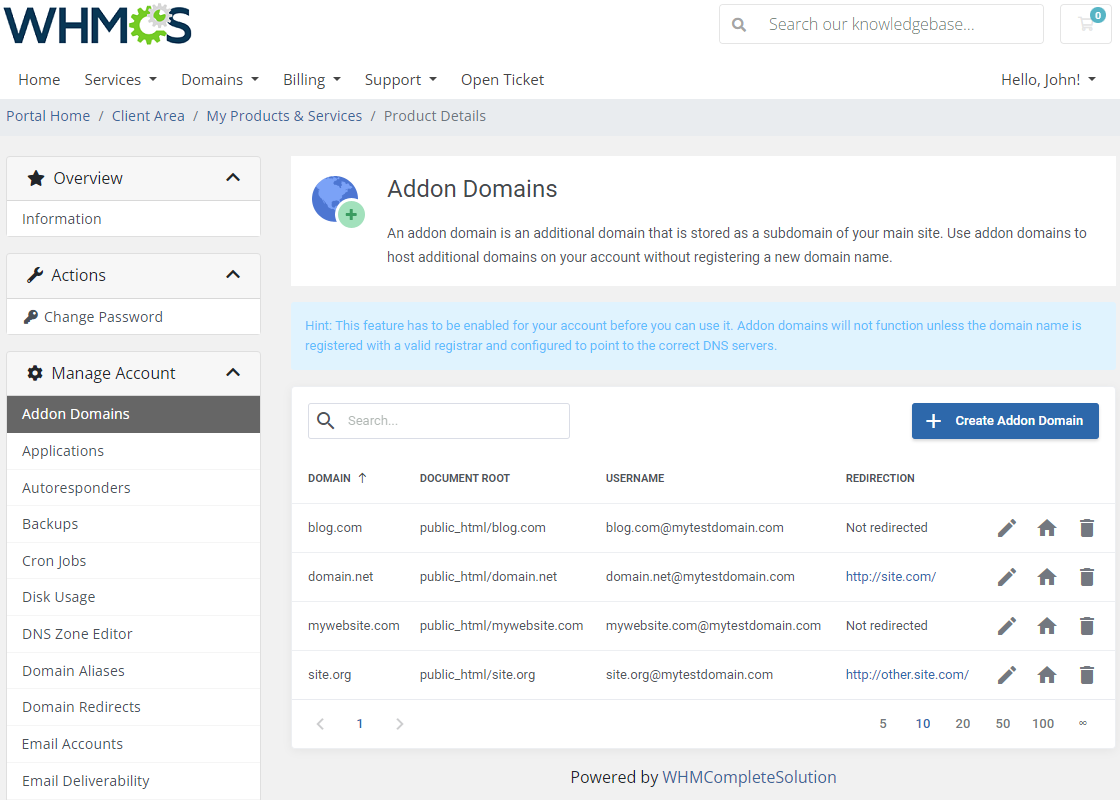
|
| Press the 'Create Addon Domain' button and enter the desired details. Please note that an FTP account will not be automatically created with the domain. |
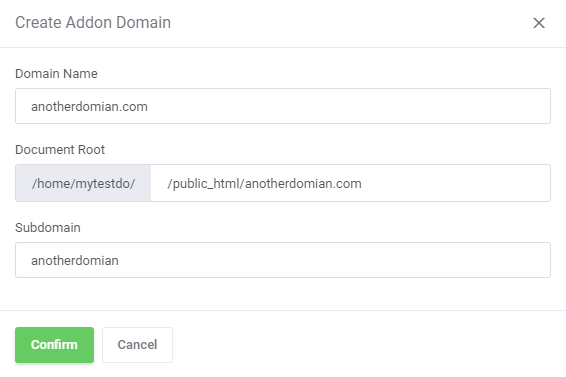
|
Applications Configuration
Applications
| Install your favorite applications in a few seconds without even accessing cPanel. Use cPanel Extended For WHMCS to:
To start, simply proceed to 'Applications' , and then find the 'Install New' section. |
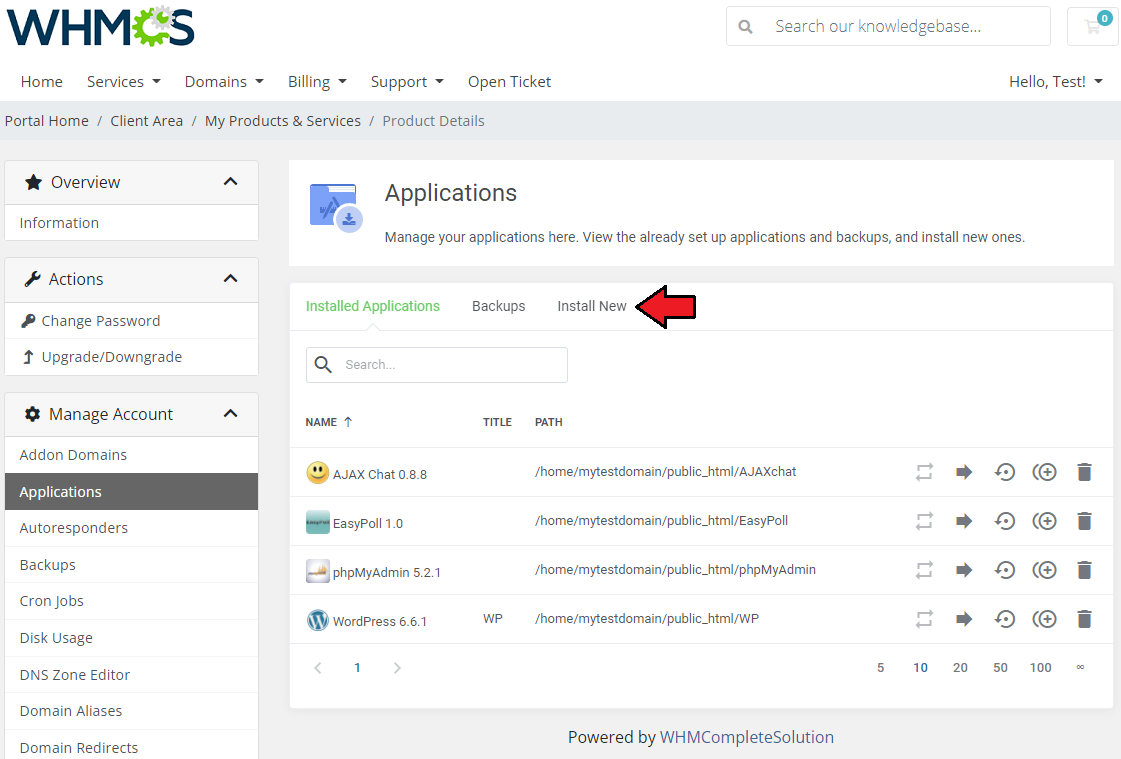
|
| Afterwards, you will see an extensive menu with application categories. |
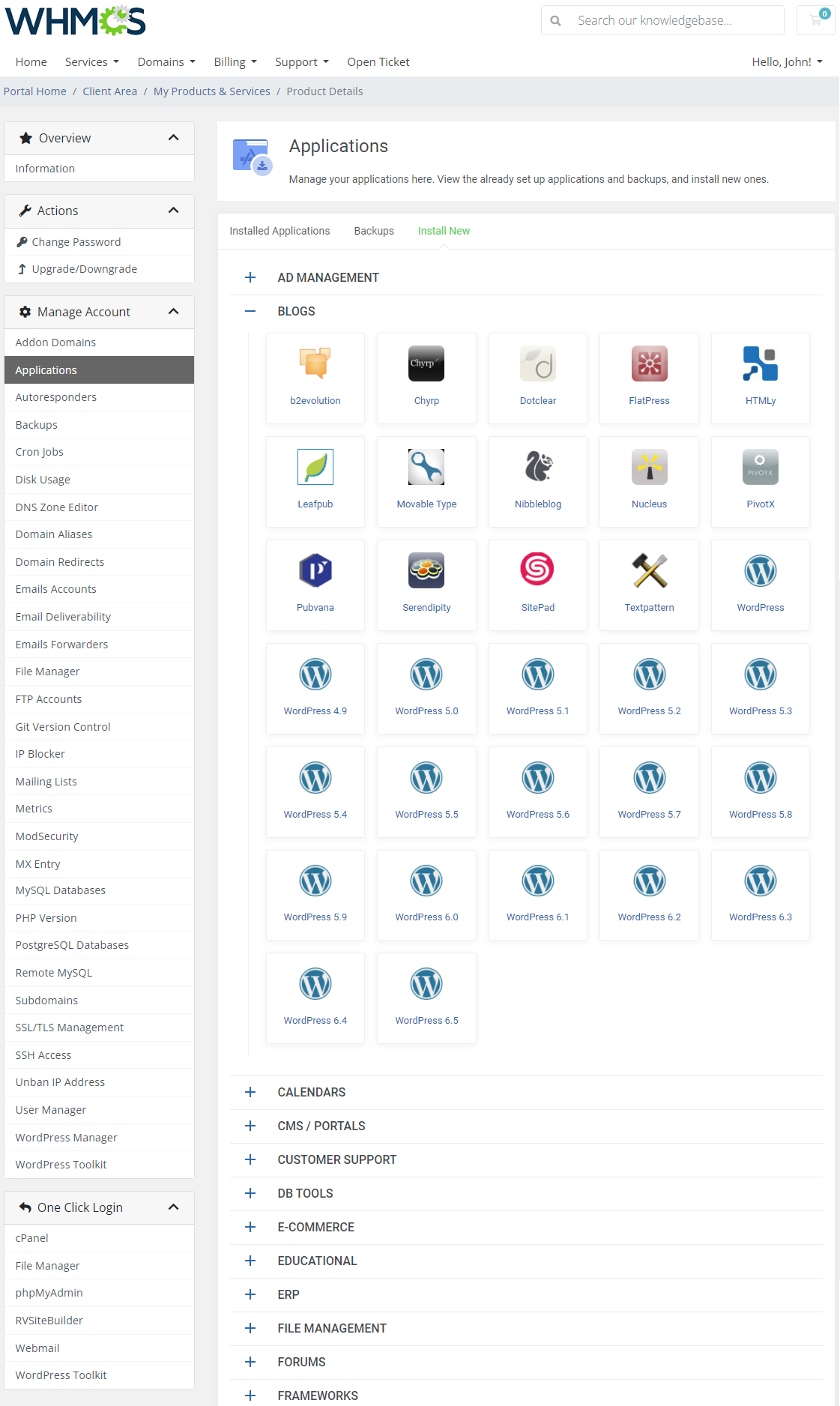
|
| Use the 'Search' box to find the application you need and install it. For presentation purposes we will install 'PrestaShop' located in the 'eCommerce' category. |
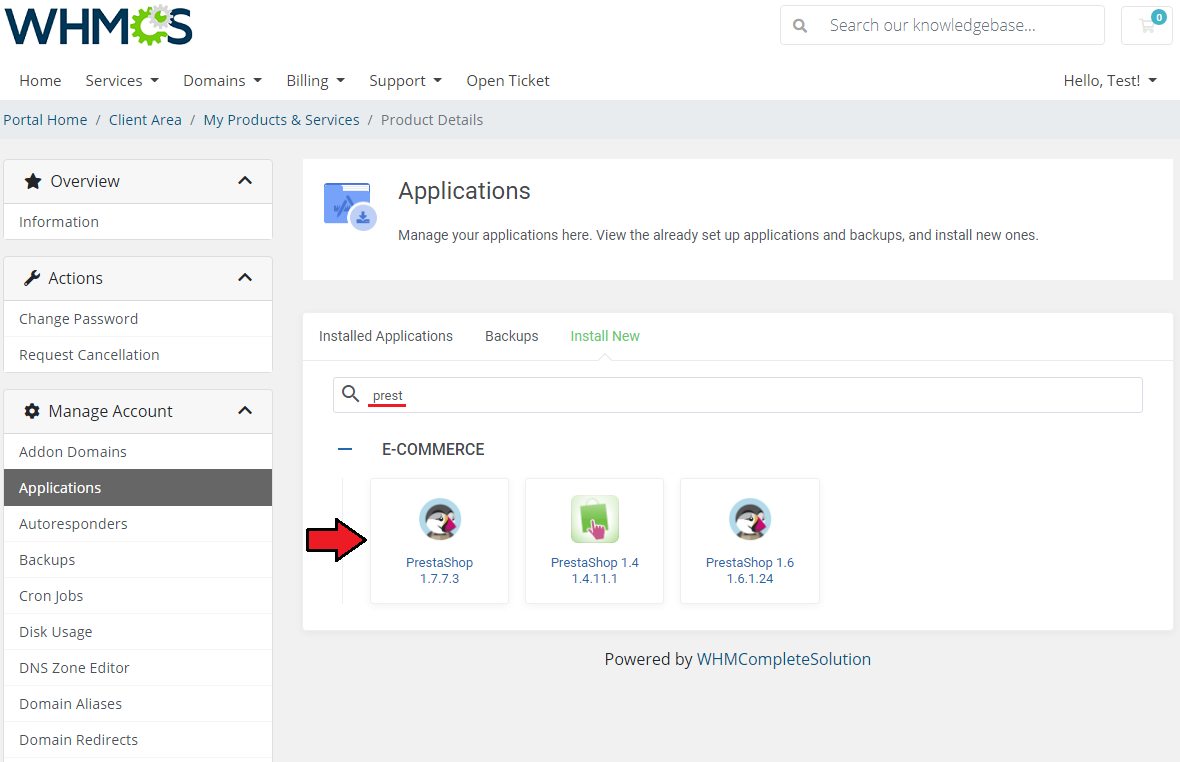
|
| Now, you have to enter necessary installation details, login details and other required data. Then press 'Create' button to follow. Wait for the 'Success' notification. |
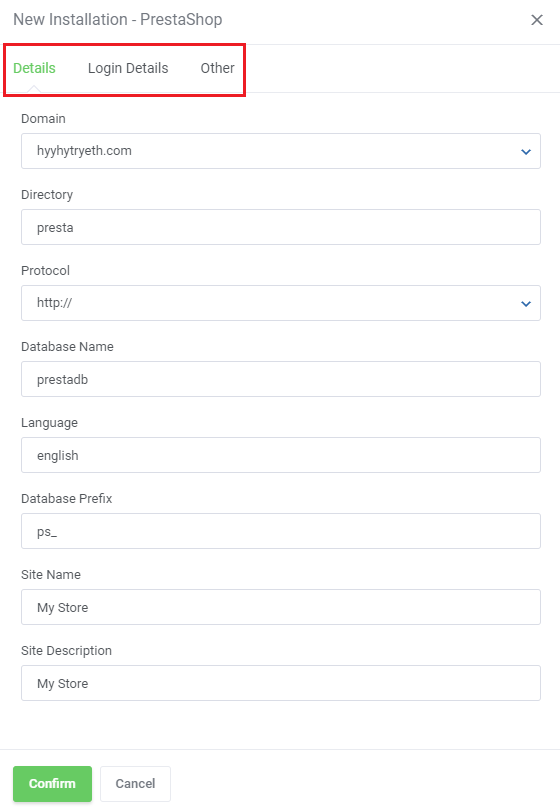
|
| View the list of your installed applications by clicking on the 'Installed Applications' tab and manage the application. Here you will the name of the application, its path, size and available actions:
Note 1: Please be aware that creating staging applications, generating backups and cloning may take even up to a few minutes and the results are not visible instantly. Note 2: There are few applications available in Softaculous, which cannot be cloned nor staging instances created. These two options are not available on the list in case of such apps. |
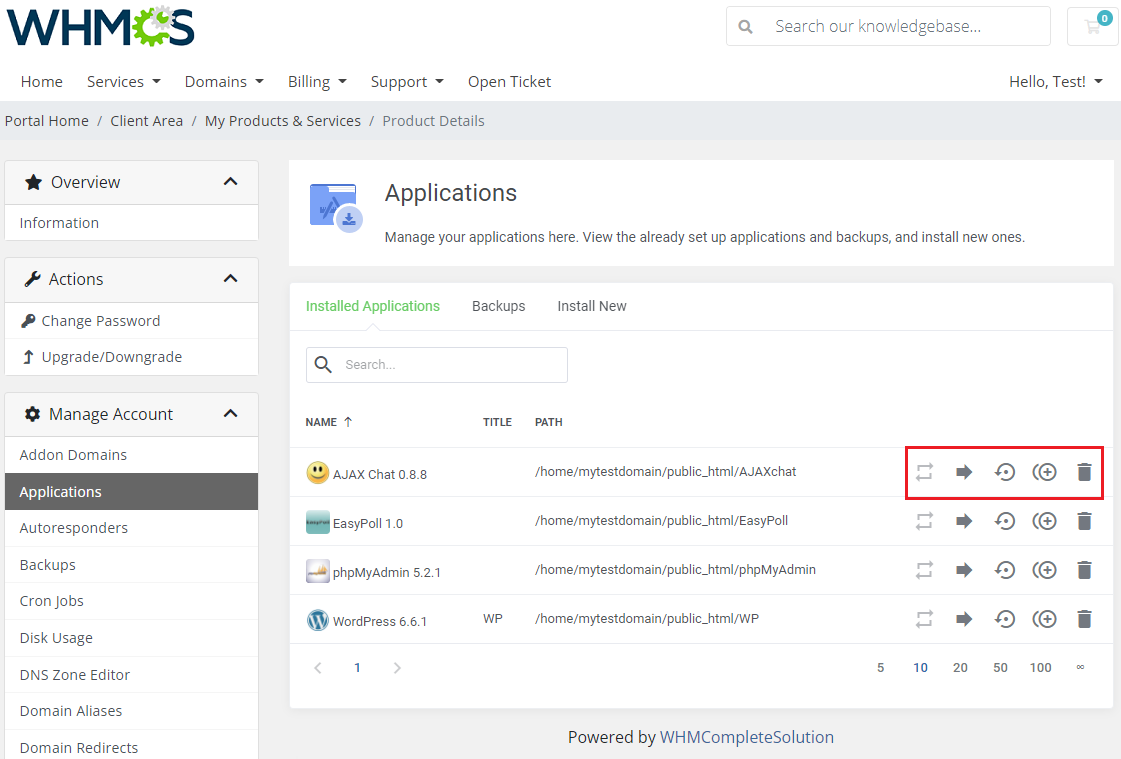
|
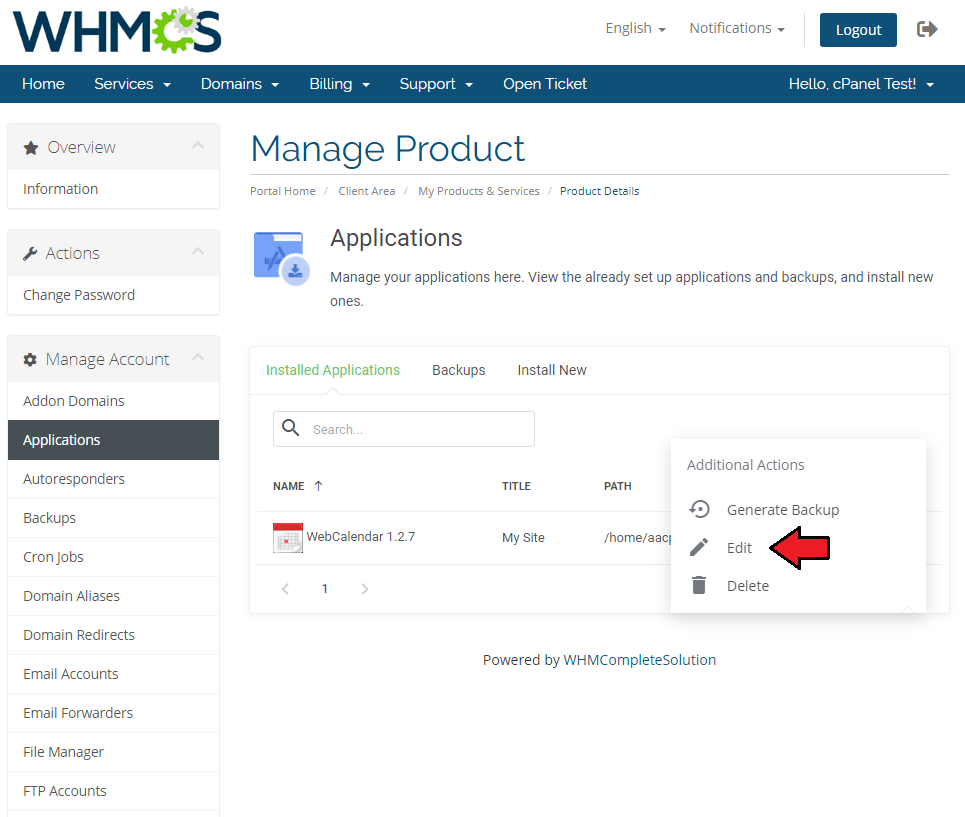
|
| For staging applications, there is an extra option available to push such application instance to the live environment. Simply press the marked button. Please keep in mind that it might last a short while before the application appears on the list. |
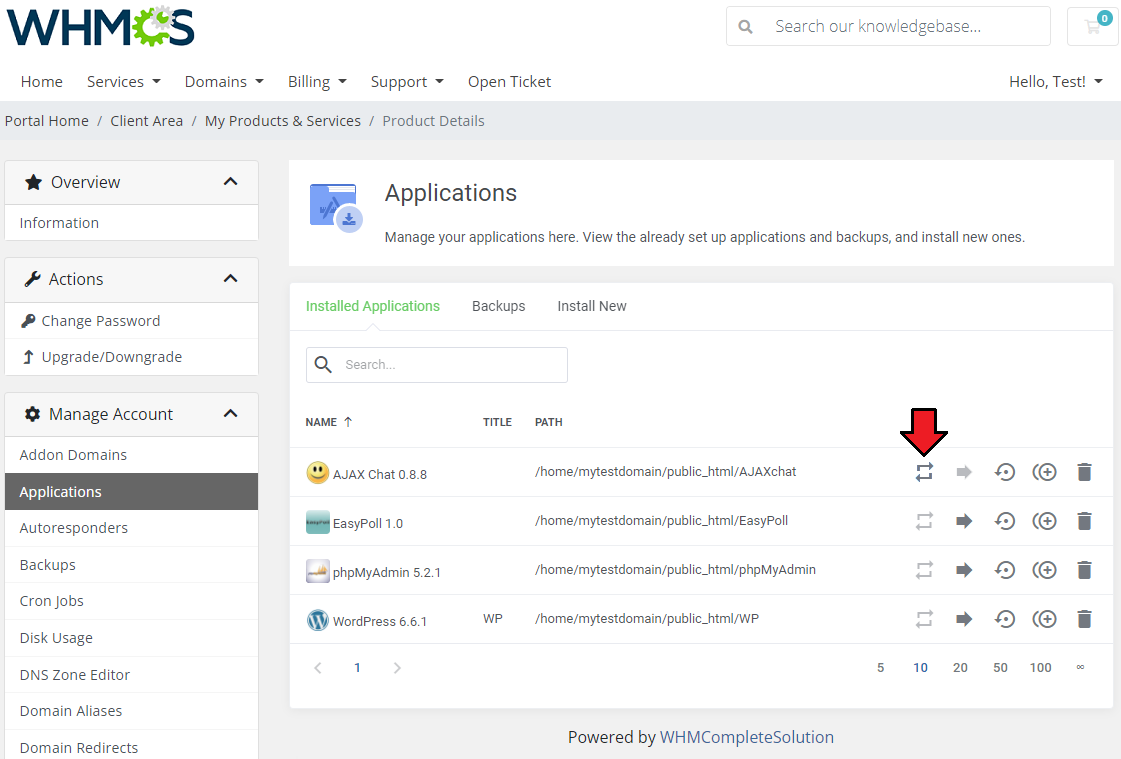
|
Application Backups
| You can also create a backup of your installation. To do so, simply press the 'Create Backup' button next to the installed application. |
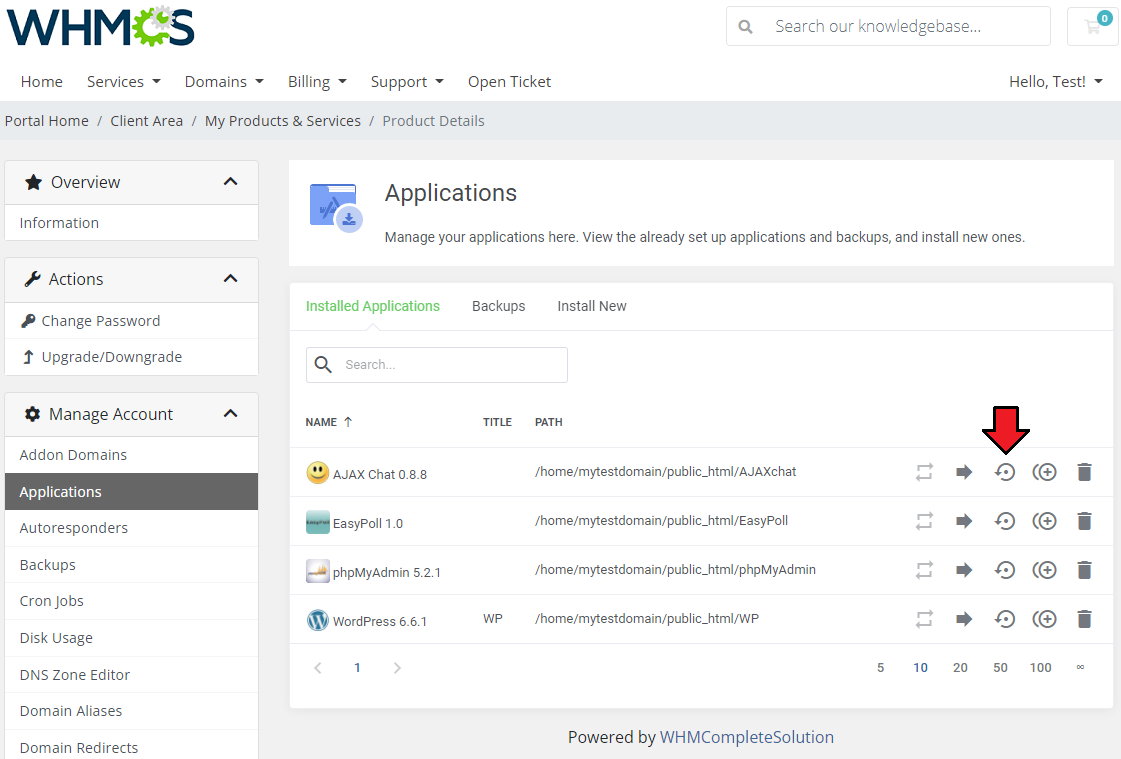
|
| Confirm the action and backup generation will start immediately. |

|
| After a moment you should receive a message confirming that the operation has just started and will be completed in a short while. Once you have created a backup of your application, proceed to the 'Backups' tab. |
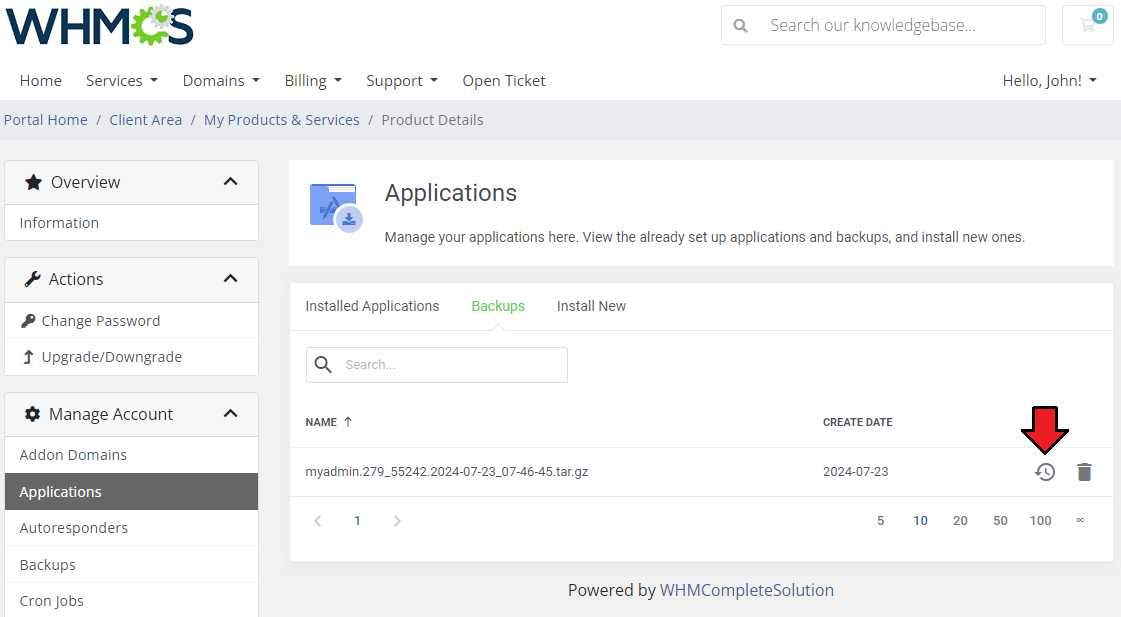
|
| You can also let your customers create automatic backups for application updates. To do this, go to 'Addons' → 'cPanel Extended Center' → 'Features' → 'Configuration' and enable Auto Update Backups. |
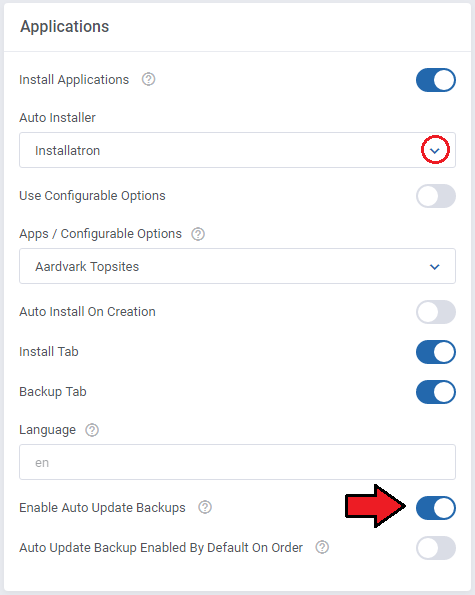
|
| Then, when a client installs a new application, it will be possible to toggle the option for automatic update backups and restore them if the application update fails. |
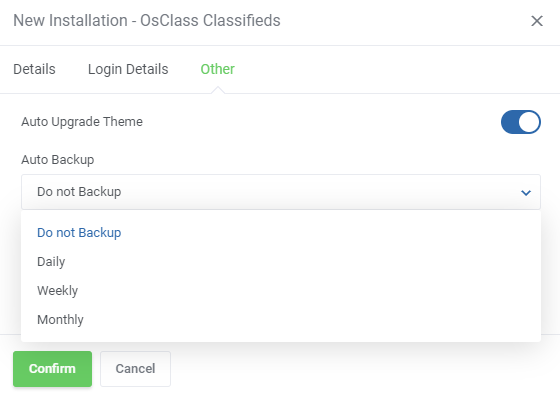
|
Autoresponders
| In this section you may compose and add extremely useful default messages. They will be automatically sent as a response message when you have no access to your mailbox. |
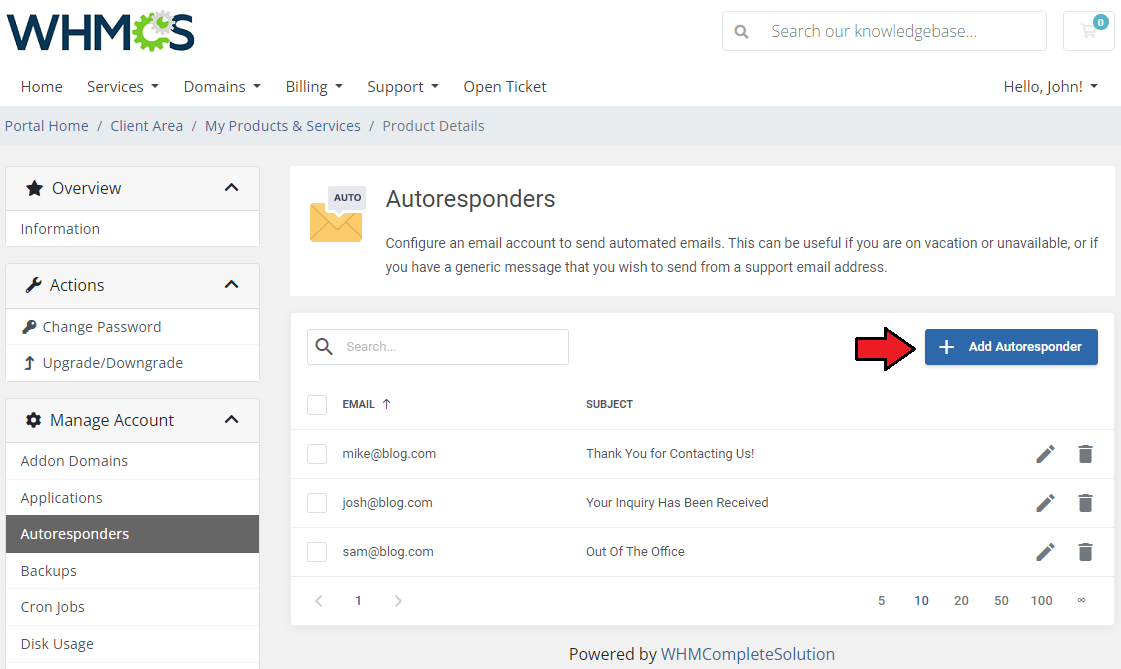
|
| Press 'Add Autoresponder' to create one. |
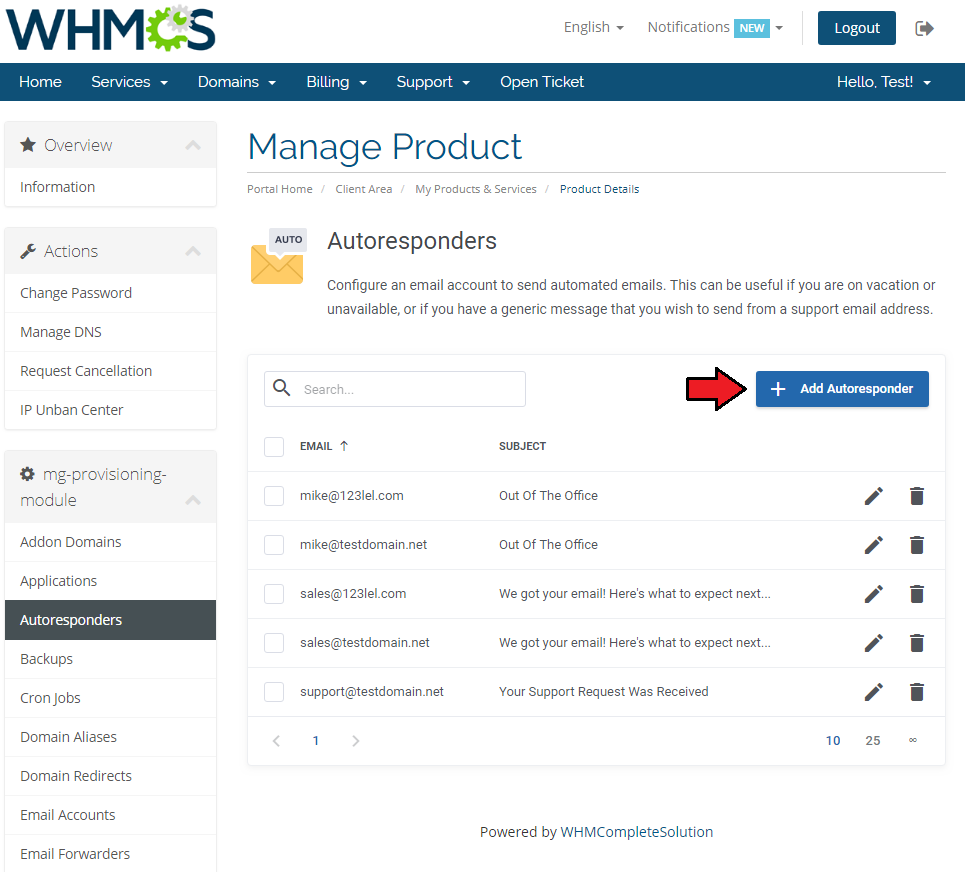
|
| Fill out general information first. Define the time interval of sending the message to the same address, type in the email address and compose the whole message here. |
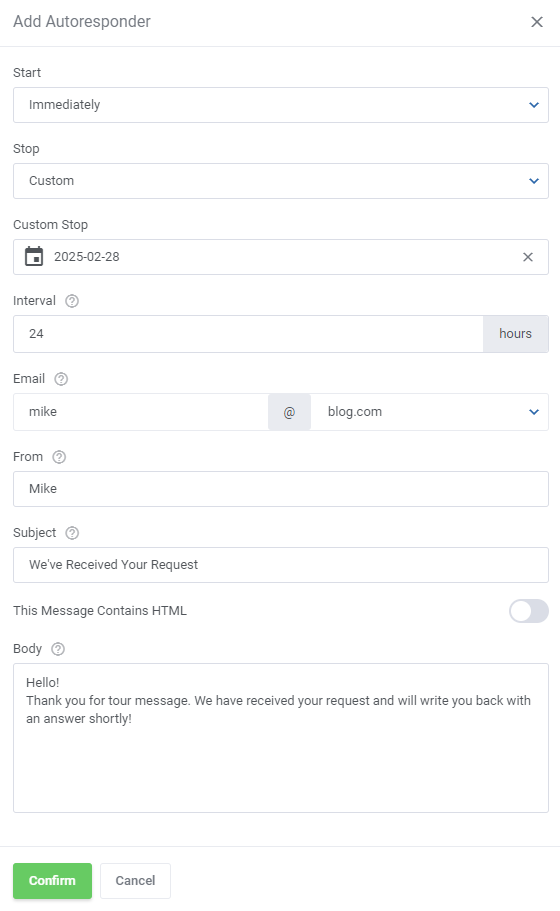
|
| In 'Other' section you will have to define whether to start the autoresponder immediately or introduce custom starting time. In the same way define when to stop using this particular autoresponder. |
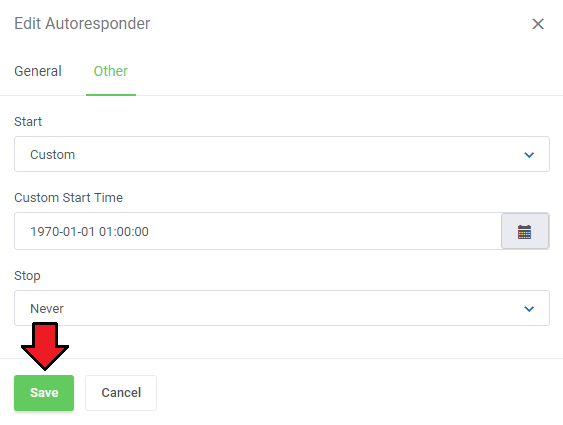
|
Backups
| All backups generated automatically are displayed in the page under 'Restore Points' and 'History' tabs. To restore a backup, choose the desired elements and press 'Restore' . |
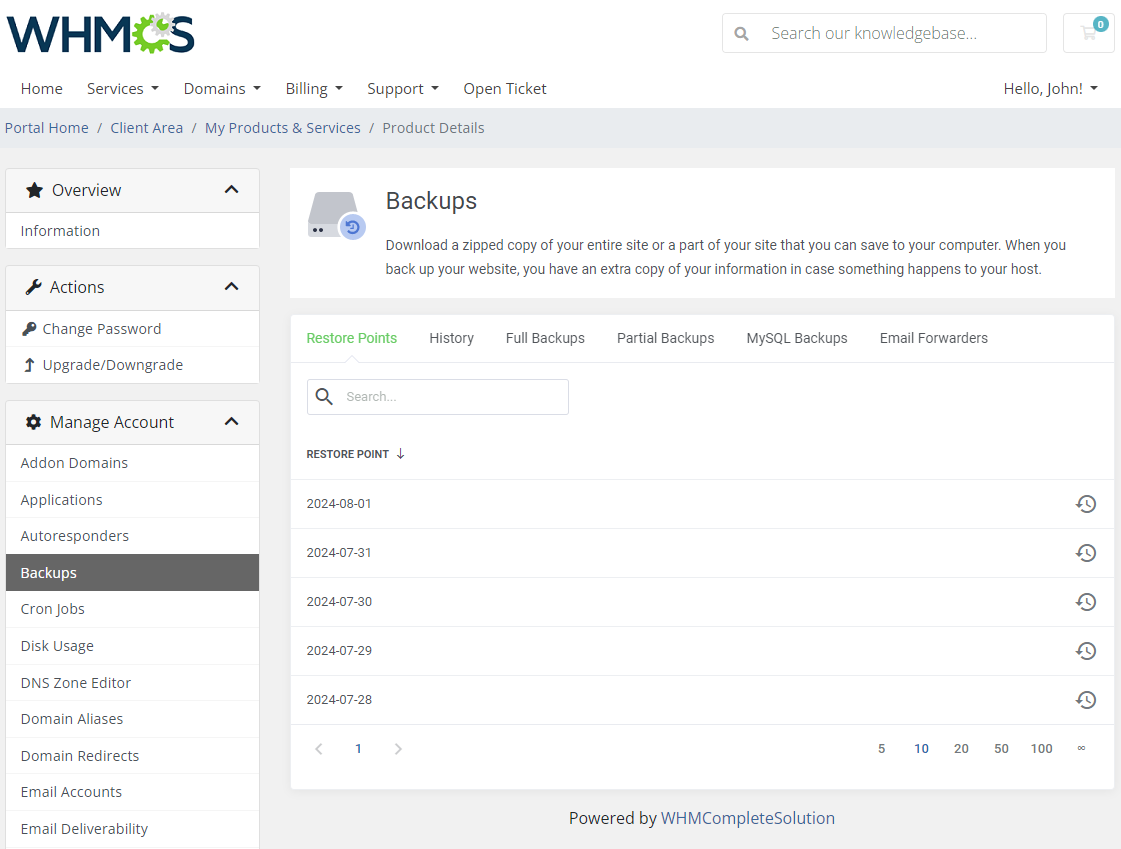
|
| You can make backups and download your entire cPanel settings or only a part of them. To generate a full backup, press 'Generate Full Backup' . |
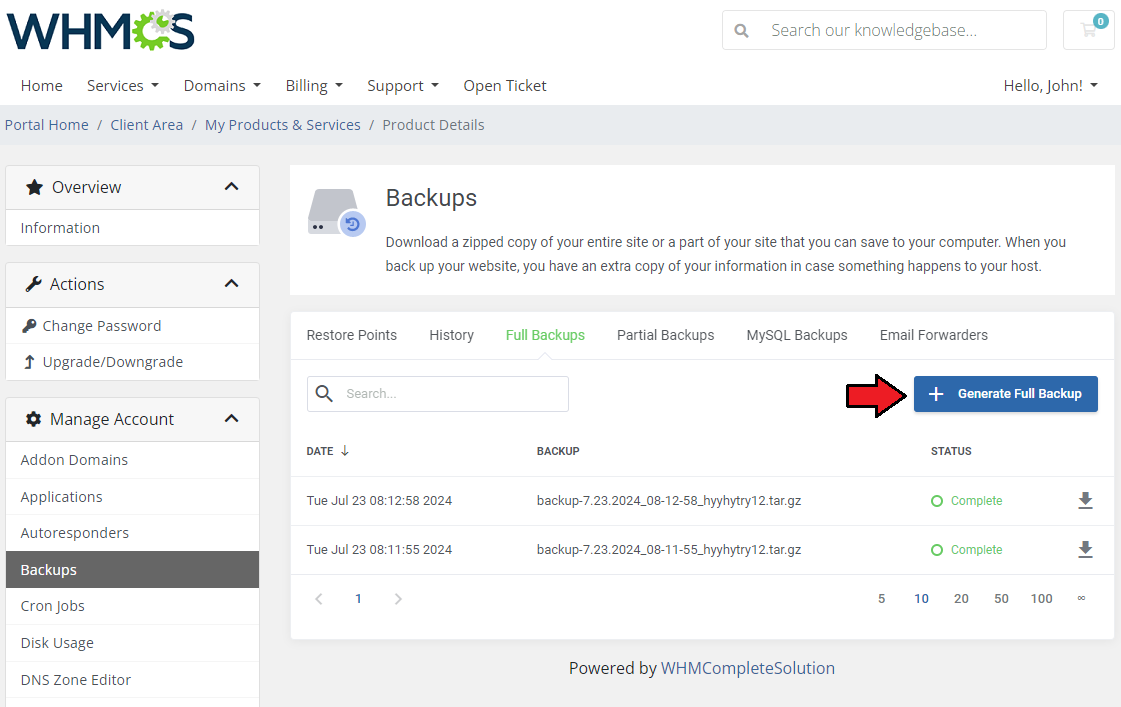
|
| Afterwards, choose 'Backup Destination' from a dropdown menu. Optionally, you can also fill in an email address to which a notification about the backup will be sent. |
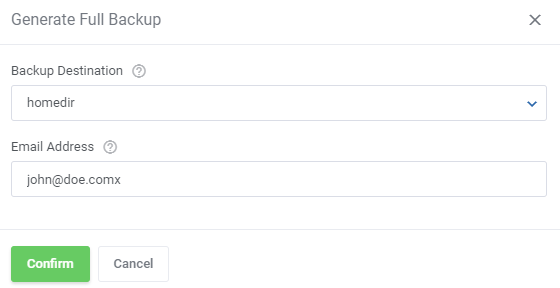
|
| To download a backup, simply press the 'Download' button. The process should start immediately. Partial backups are generated during the download process. |
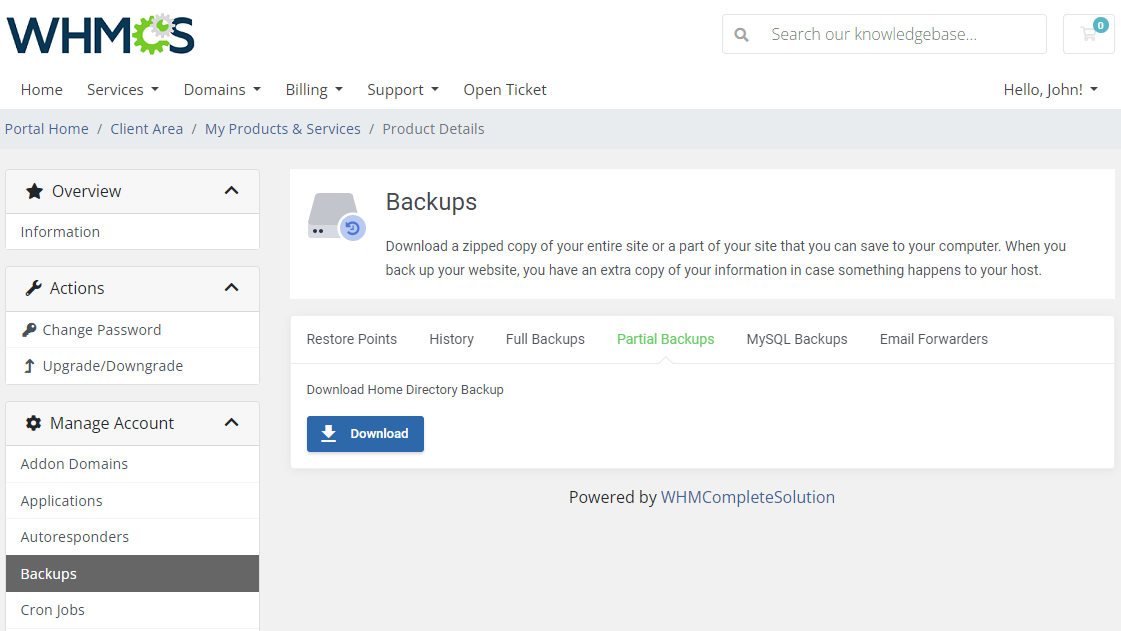
|
| Note that if you have created any MySQL databases or email forwarders, you can also download their backups from the corresponding tabs. |
Cron Jobs
| Select cron job settings to fully automate commands and scripts on your site. |
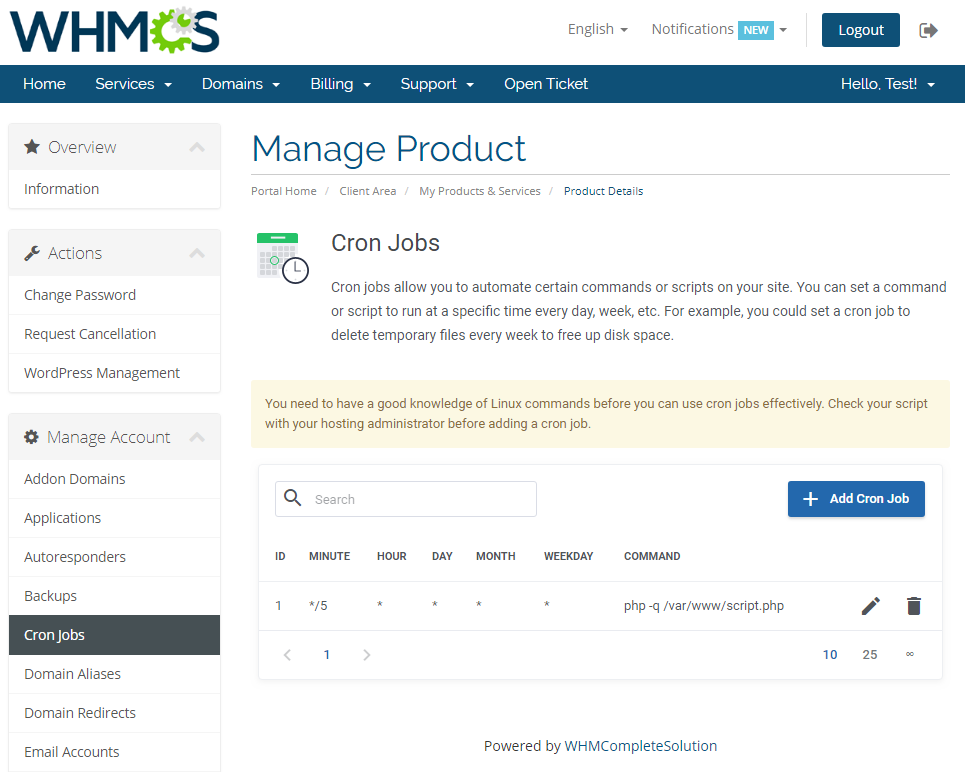
|
| Press 'Add Cron Job' and choose the specific timing as well as command type to be executed. |
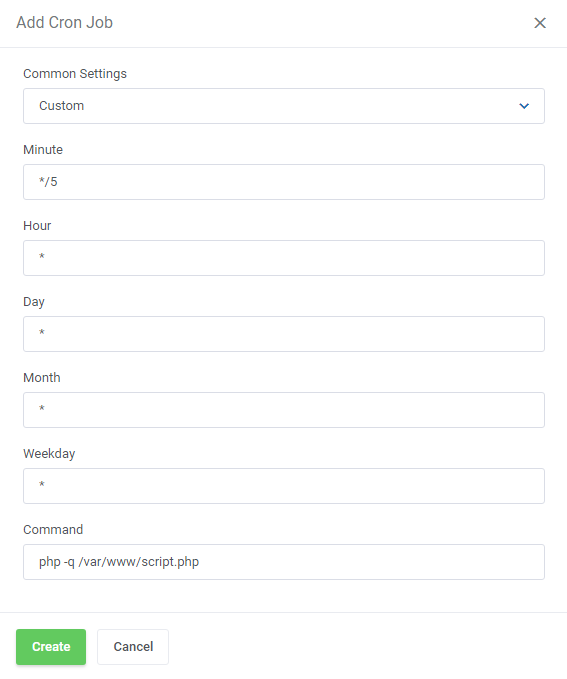
|
Domain Aliases
| You can add and manage your domain aliases. This option allows you to read content of one domain from another domain name. |
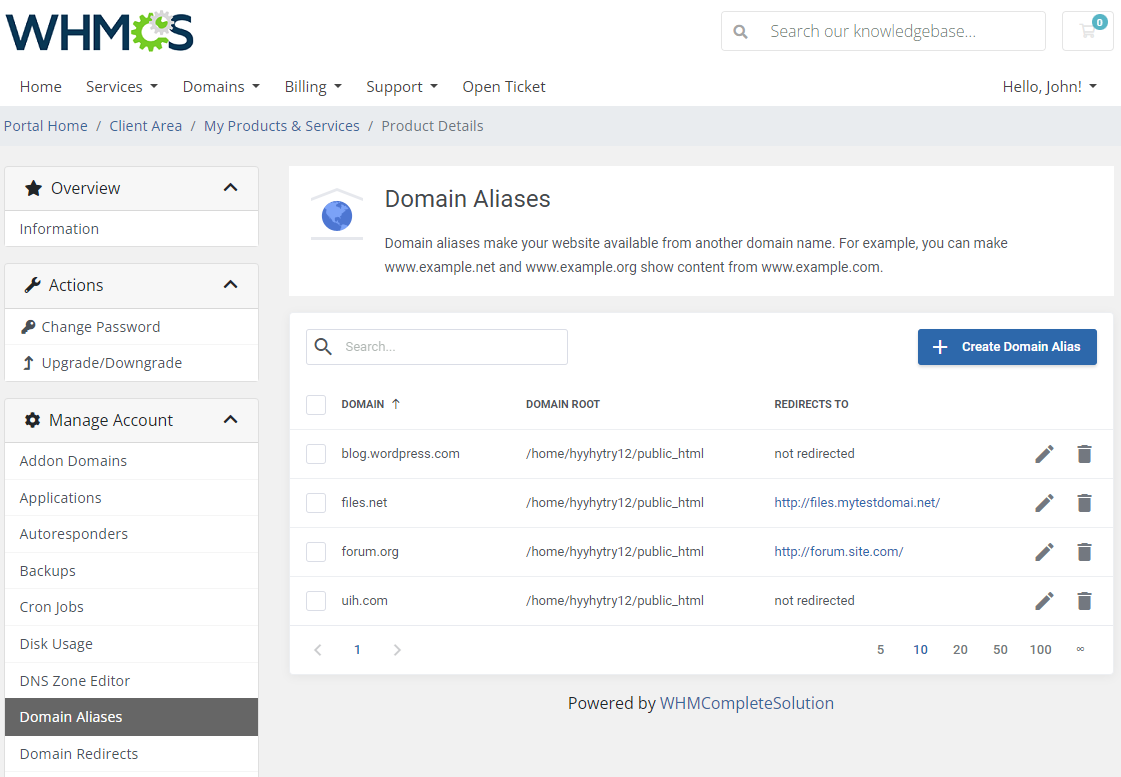
|
| After alias creation, you can edit it to enable and add redirection. |
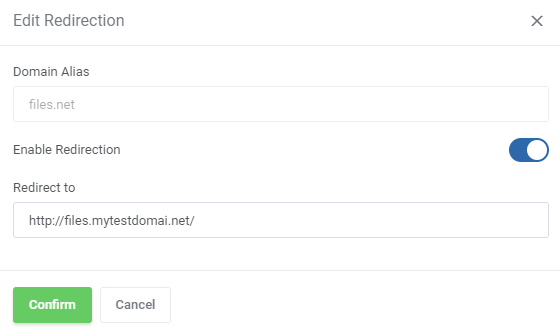
|
Domain Redirects
| Easy access to domain redirection options is very useful. This option allows you to redirect a specific web page to another one and display the contents of that page. |
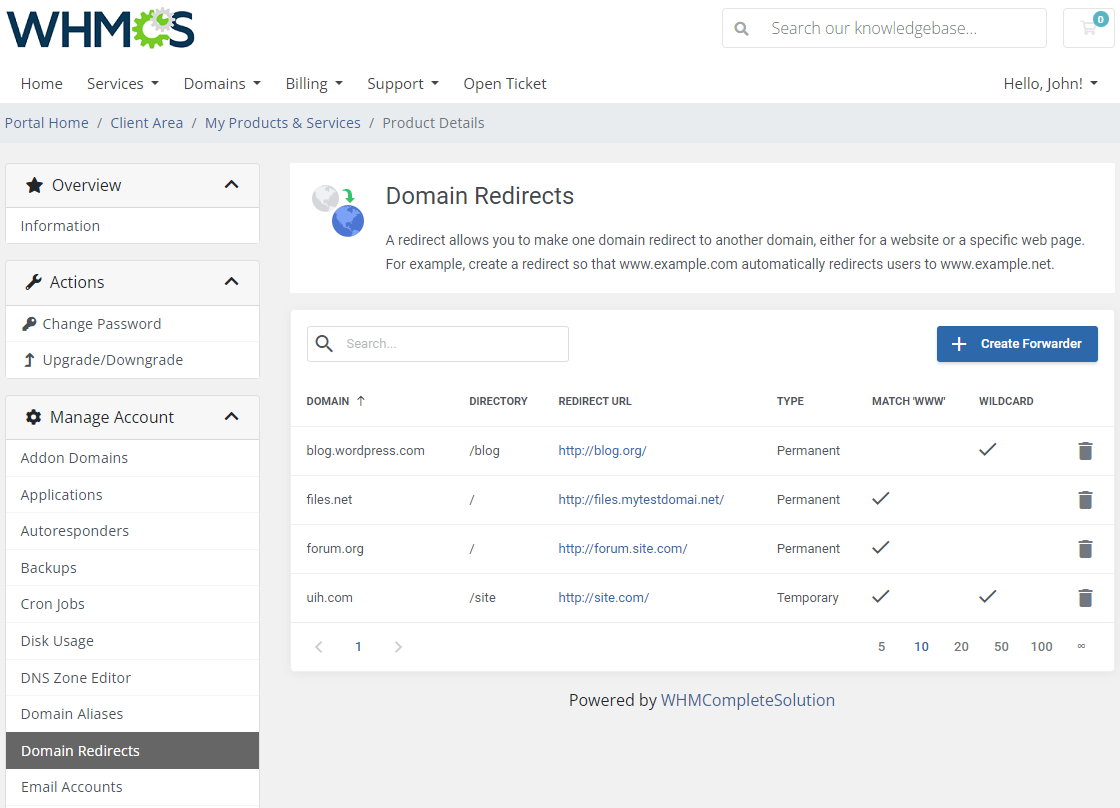
|
| For example, if your main domain is mytestdomain.com, you can make such the following forward: mytestdomain.com/redirect → adomainwithlongname-averylongname.com Choose the type: Permanent or Temporary; decide whether to use 'www' redirection or not; select 'Wild Card Redirect' if you need. |

|
Email Accounts
| View and edit email accounts that are associated with your domains. Use filter to find required email addresses, preview its selected quota and manage the account. |
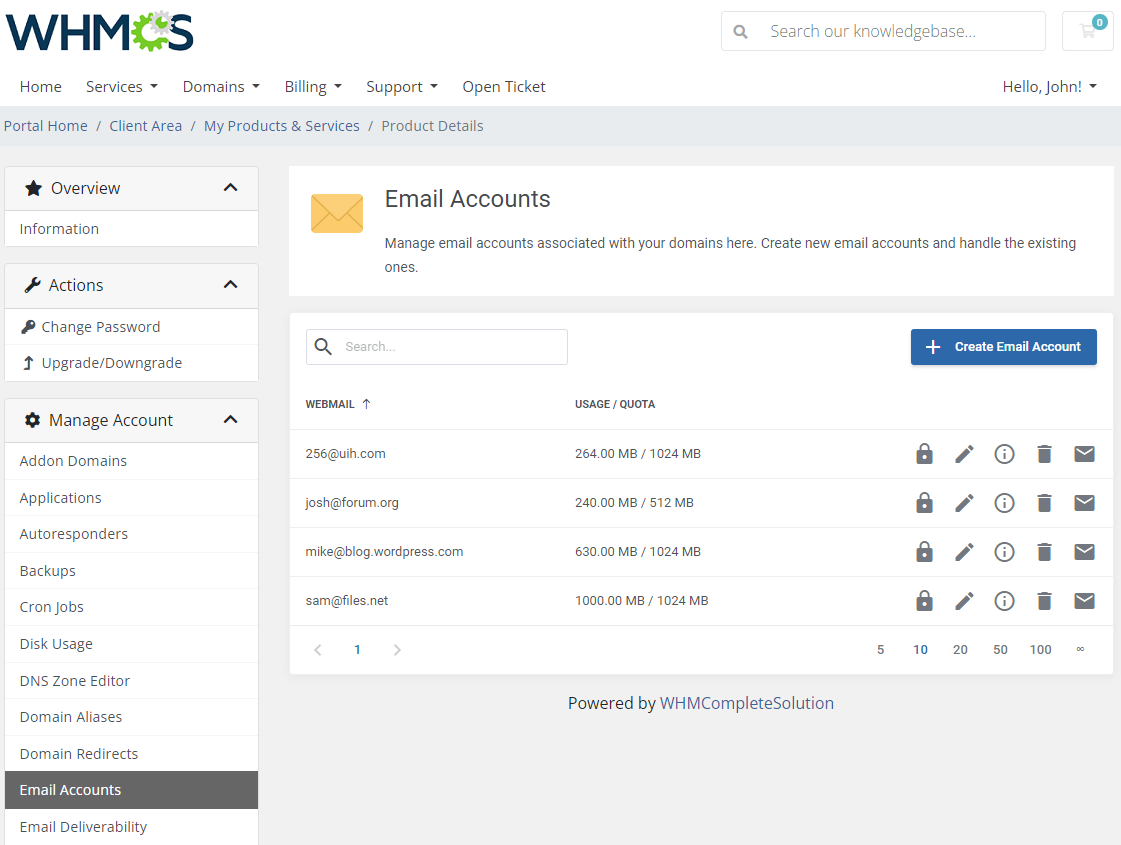
|
| Press 'Create Email Account' and select to which domain it shall be added, type or generate password and define limited or unlimited quota. In case 'Unlimited Quota' has been disabled for the product by the administrator the visible on the screen below option will not be available here. |
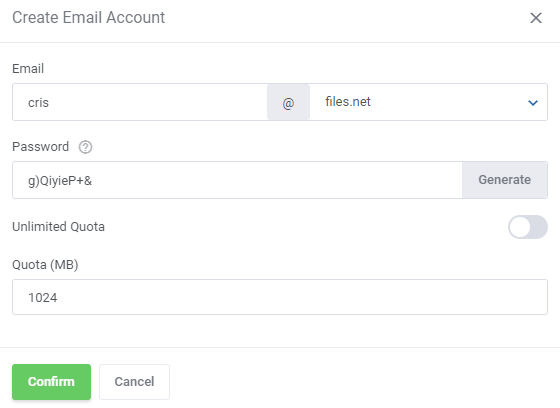
|
| You may also preview the email account settings on pressing the information icon. Any details on the email account, necessary to configure an external email client, are included in that place. |
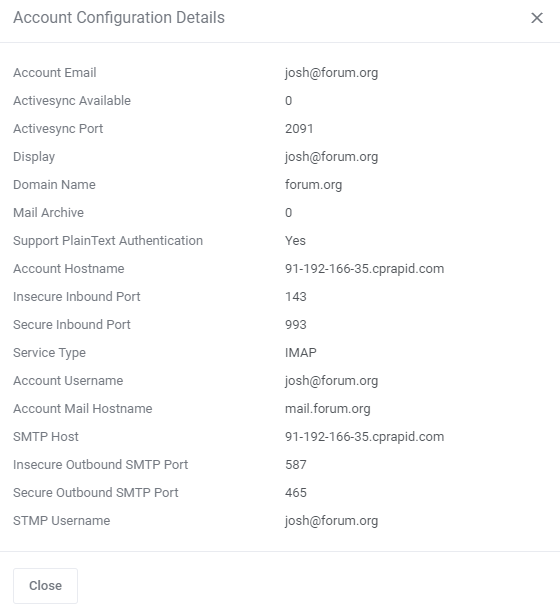
|
Email Forwarders
| In this section you can set up email forwarders and choose from several destination options to adjust mail forwarding perfectly to your needs. |
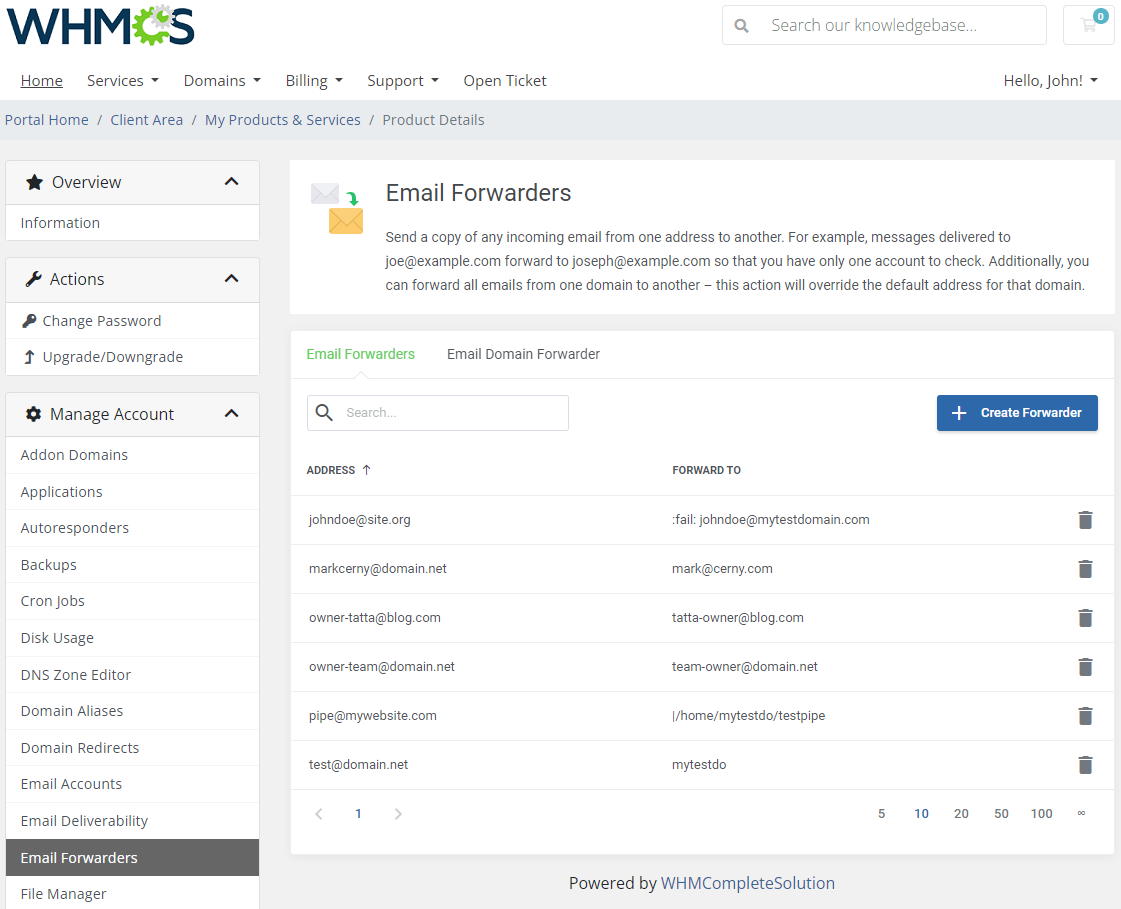
|
| Press the 'Create Forwarder' button, specify the forwarded email, select forward option type and define the destination |
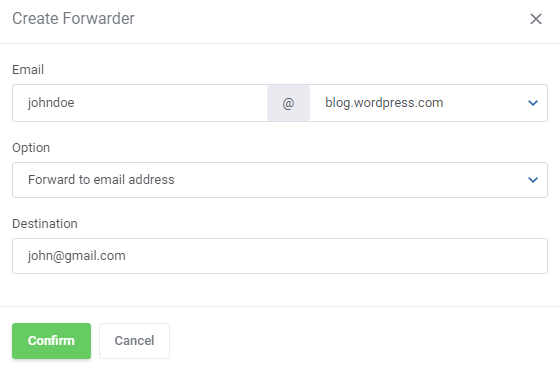
|
| In the next tab you can also add email domain forwarders to forward email from one domain to another. Note: Forwarding a domain's email will override the default address for that domain! |
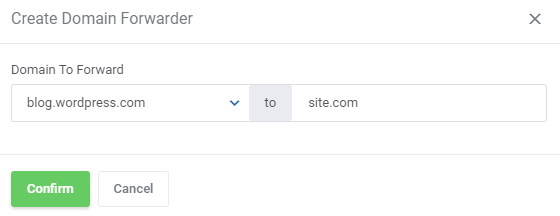
|
File Manager
| File manager allows you to manage files and folders on your cPanel account. View the list of files with their specific data: name, size, date of last modification and established permissions. |
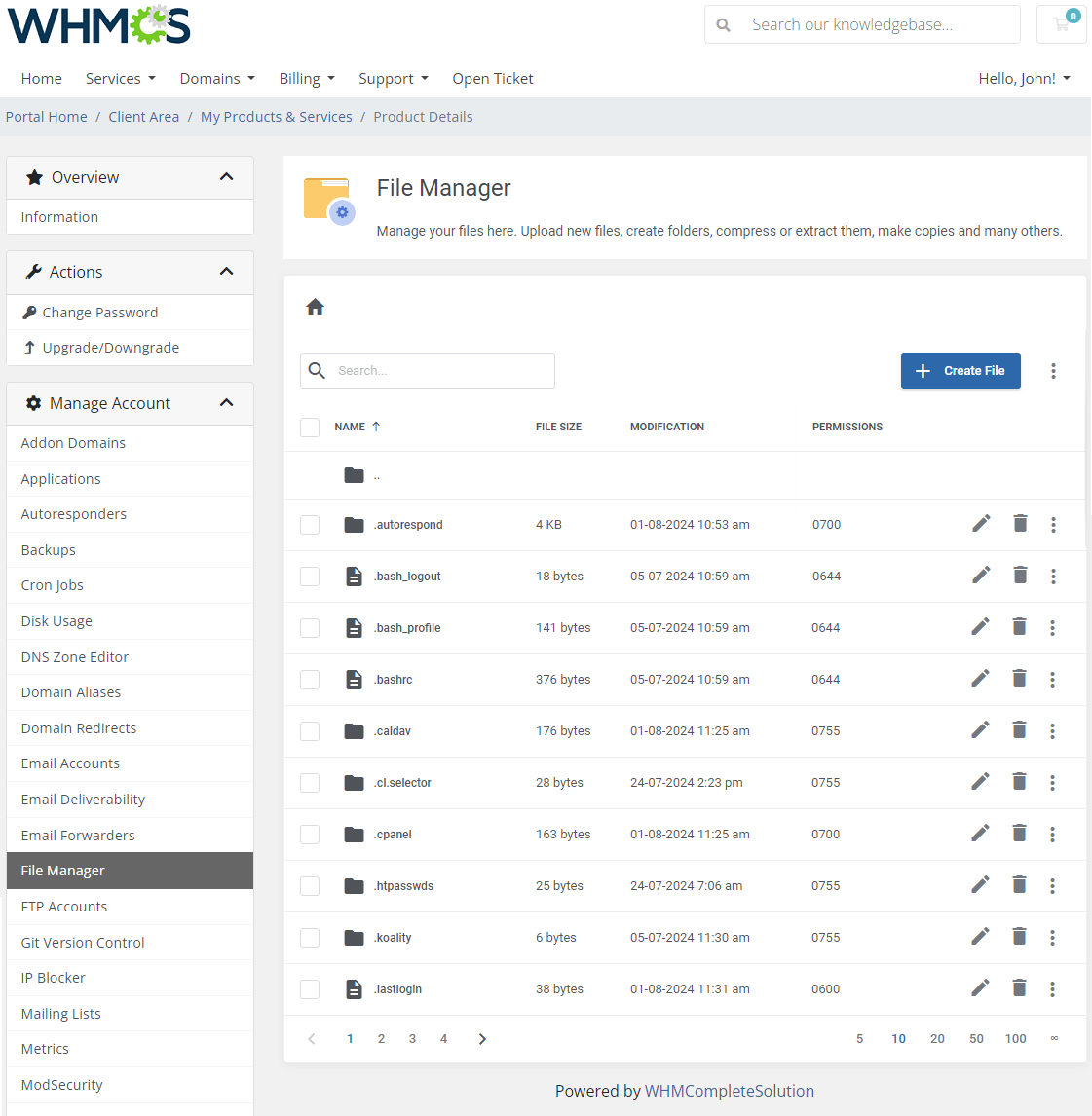
|
| You can create a new file by pressing a corresponding button as well as upload new files and create directory by pressing additional actions. |
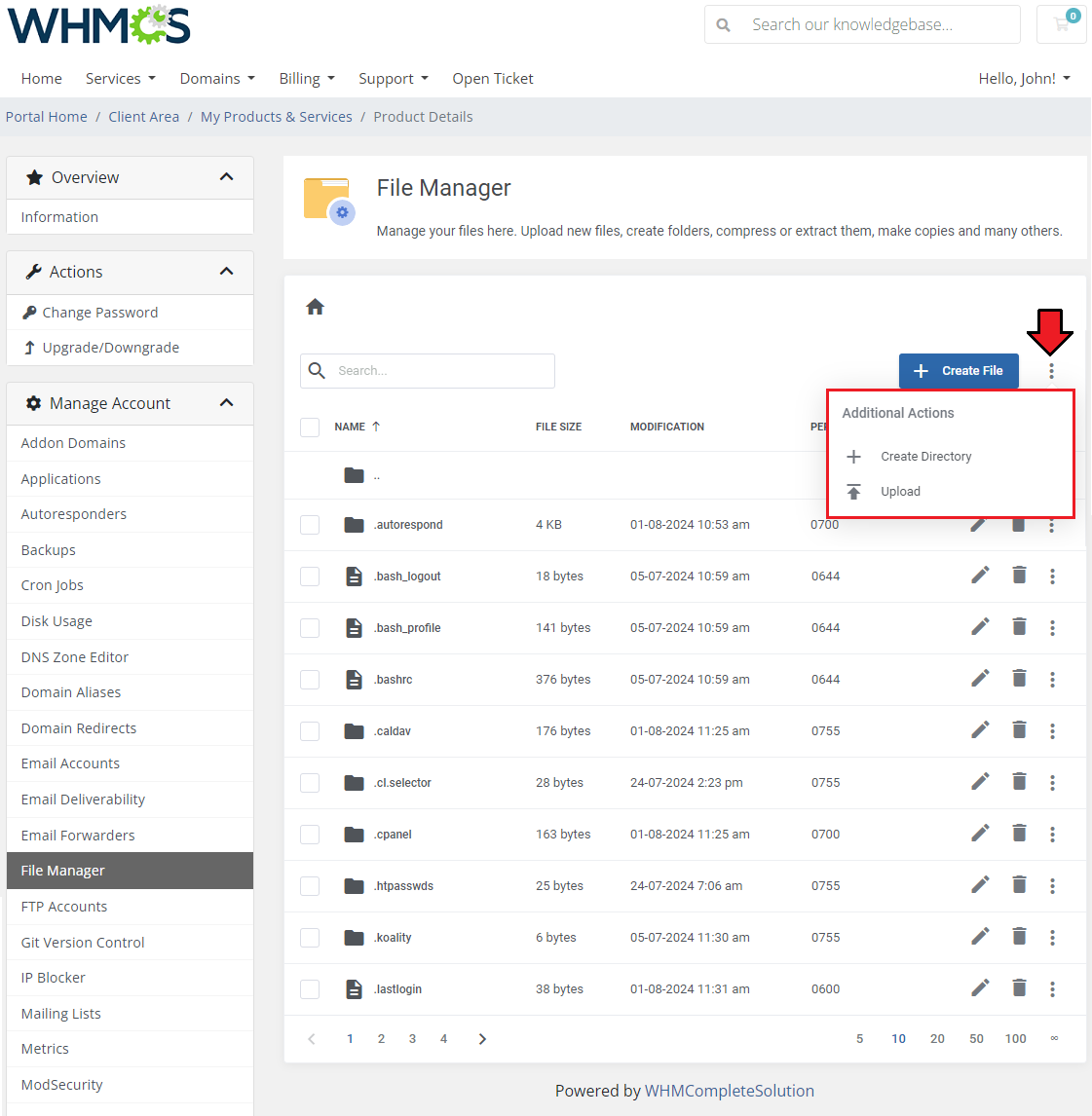
|
| You can also perform such actions as compression, extraction, moving or coping to other location, permission change and removal on single or multiple files or directories. |
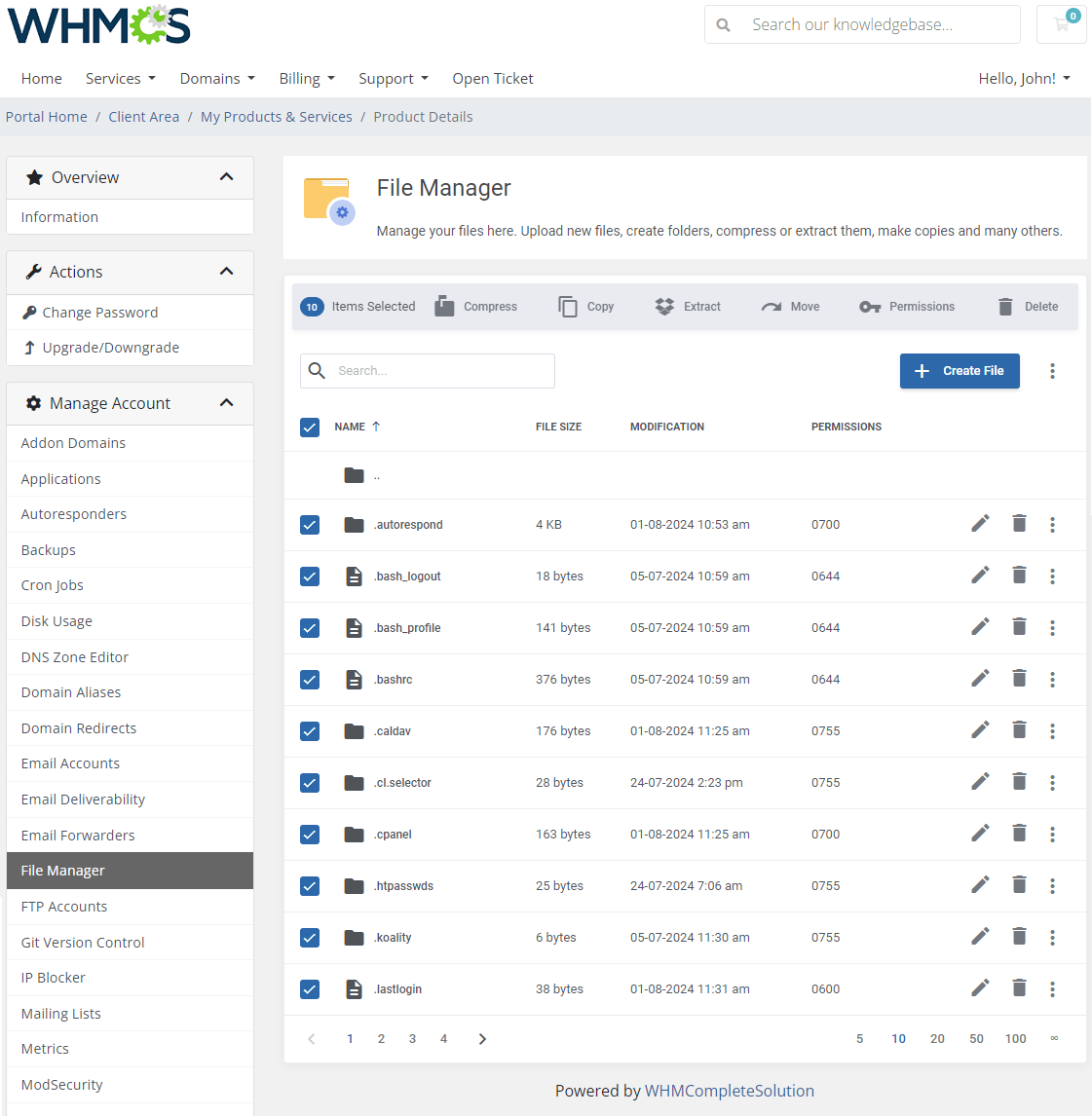
|
FTP Accounts
| Manage the accounts to be able to access your website files through an FTP protocol. |
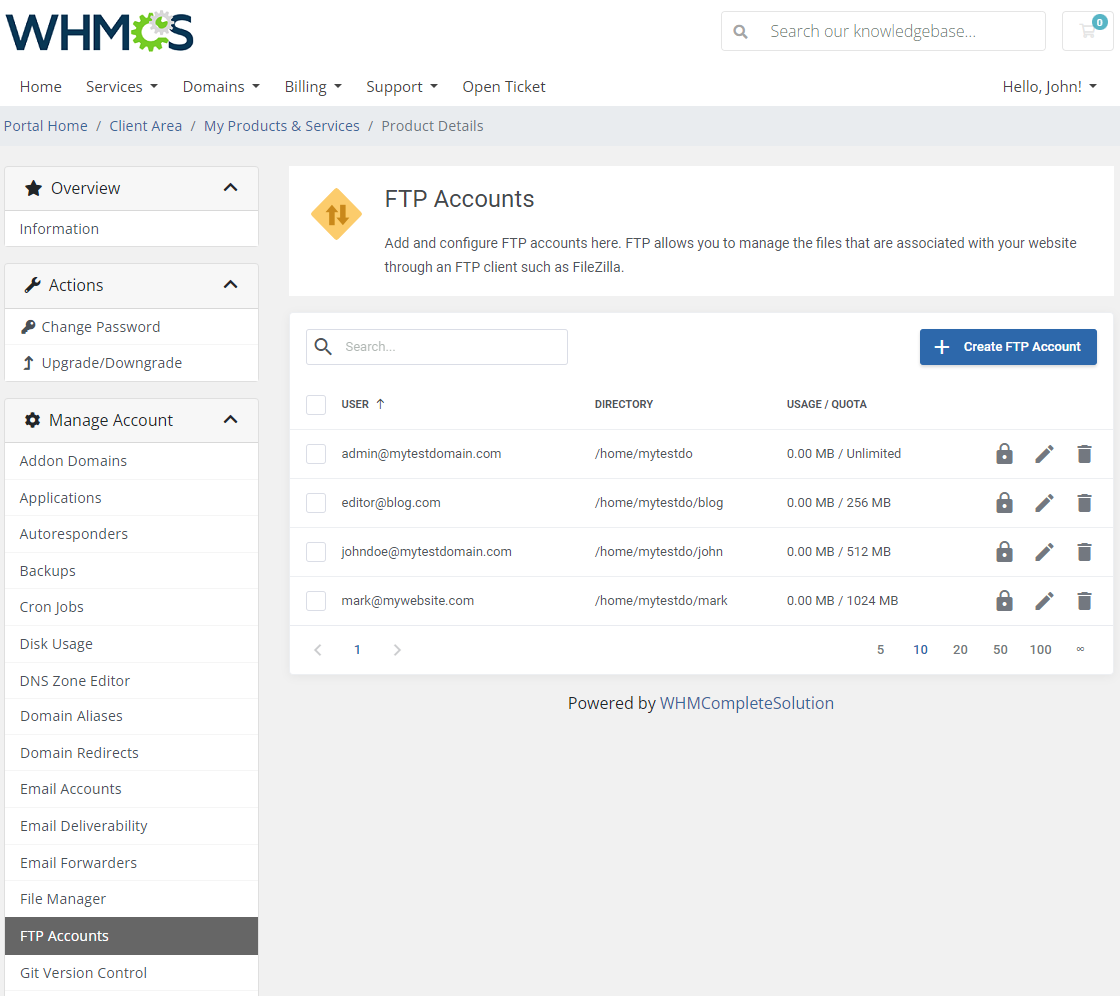
|
| Add and configure FTP Accounts in the easiest way possible. Just type in your login on a selected domain, provide or generate a secure password, define directory and declare available quota. |
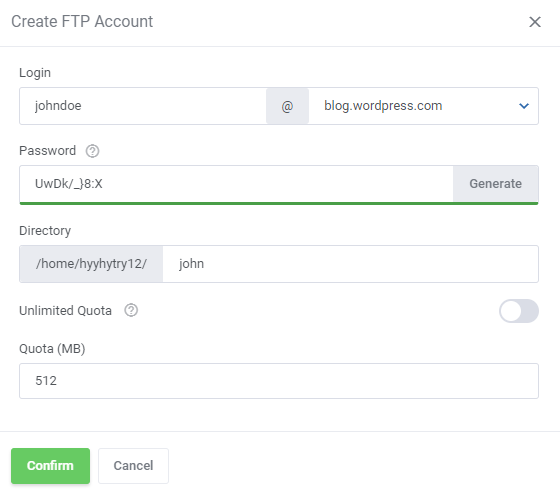
|
Mailing Lists
| Mailing lists allow you to use a single address to send message to multiple email addresses. This feature is very useful when you need to send a newsletter or another update to a group of people. Allowed actions on a mailing list:
|
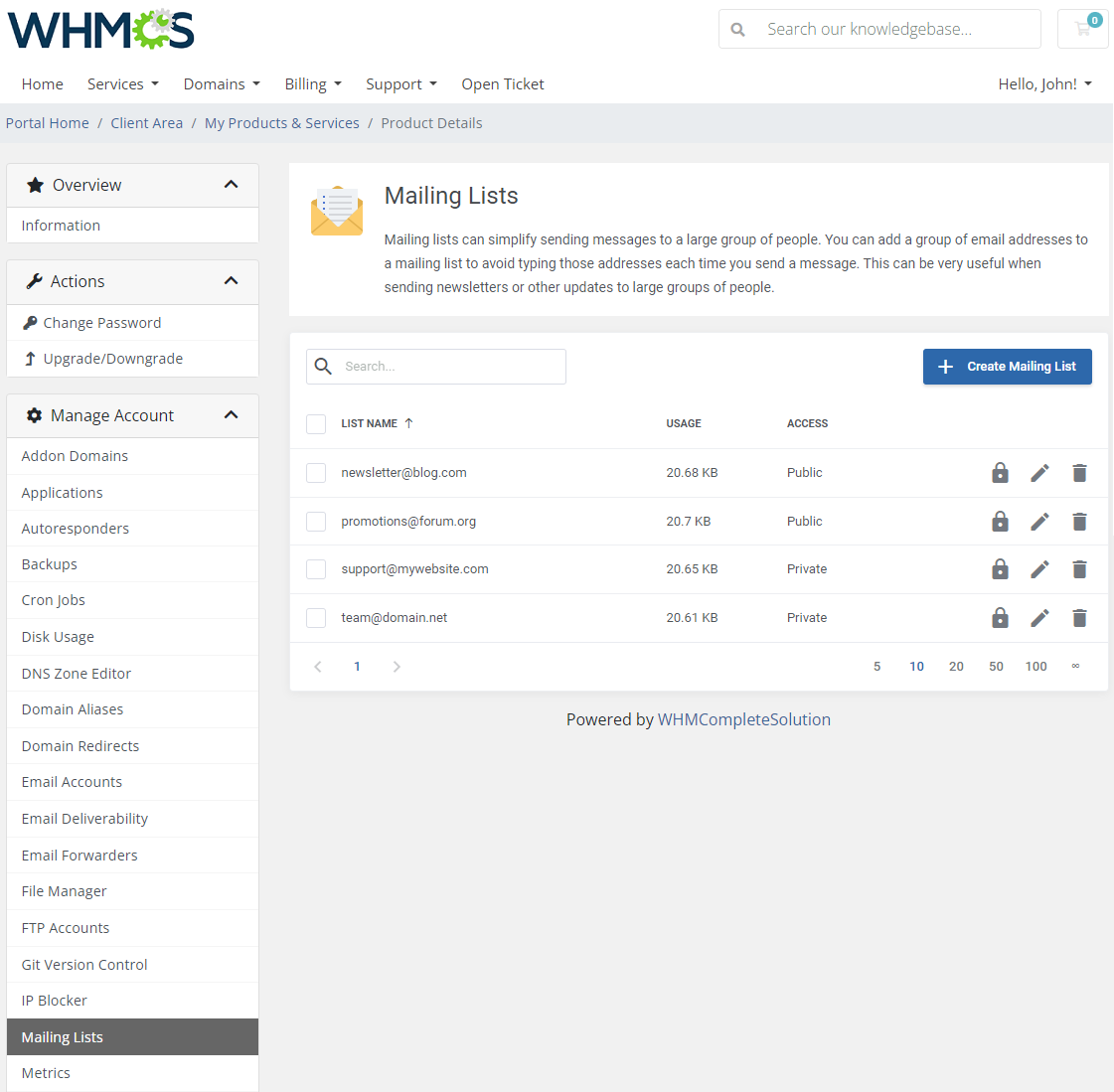
|
Press 'Create Mailing List' button and then define a name, password, and a domain name. Next, choose the access type:
|
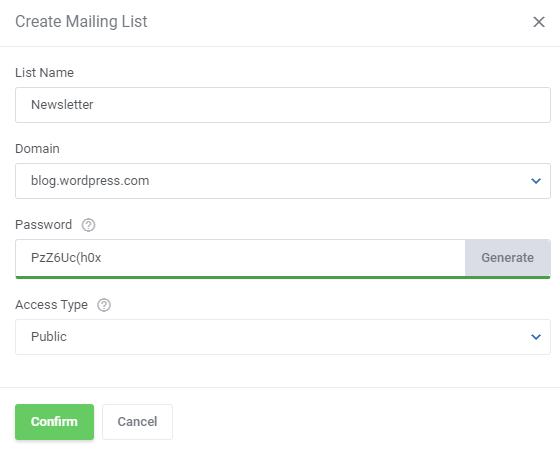
|
| After creating a list, you can delegate its administrative privileges to the users of your choice. Press the 'Edit' button and 'Create Delegate' in the next section. |
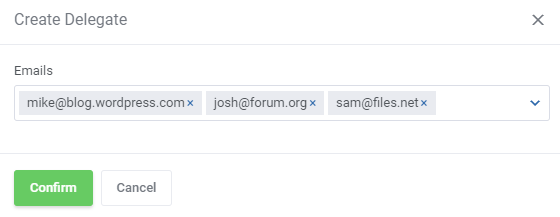
|
| Once you have delegated administrative privileges to an email user from a list, this user will be able to log in to administrative console of the list from webmail. |
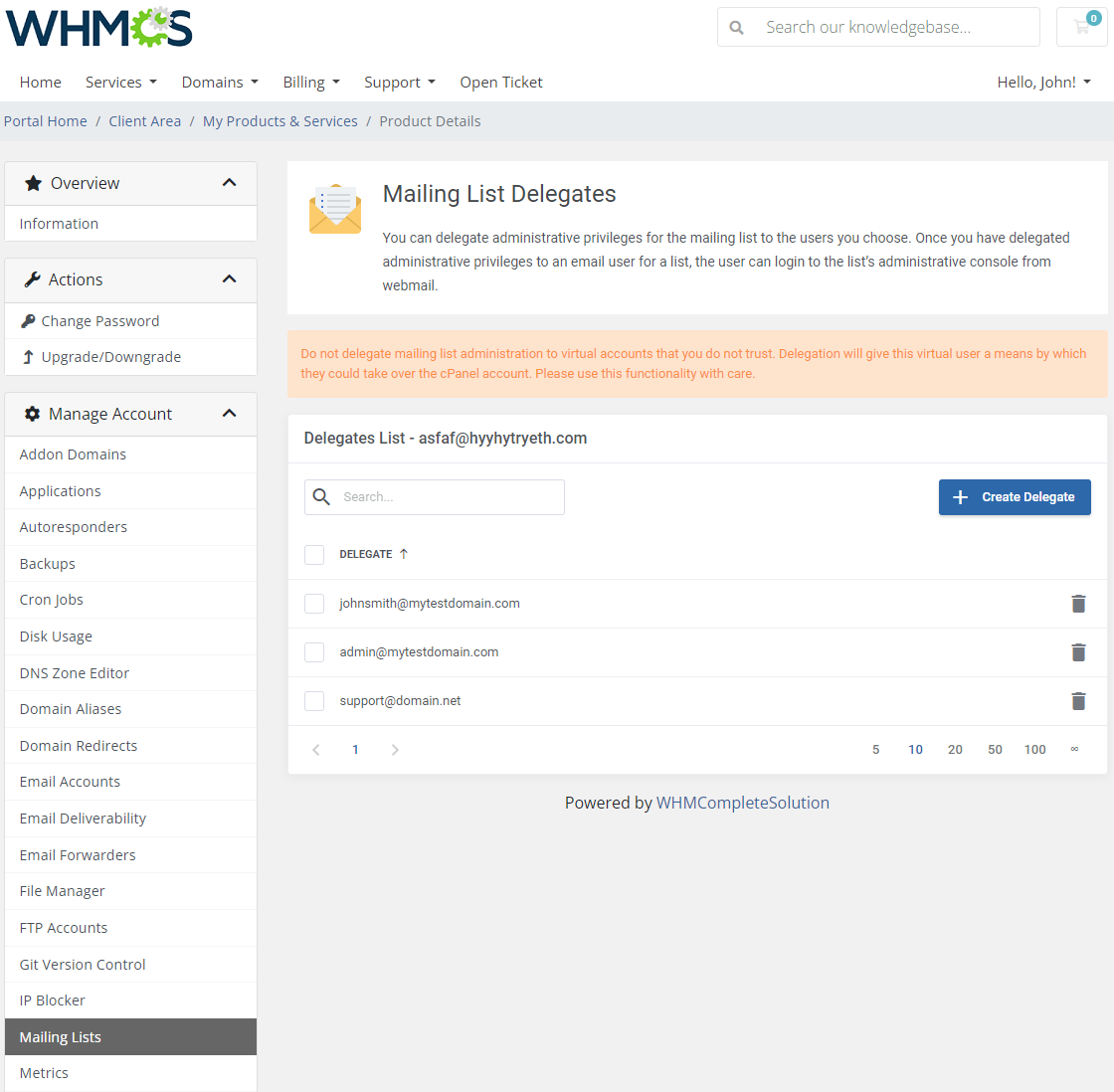
|
Metrics
| Be always up to date with information about your websites. Use 'Webalizer', 'AWstats', 'Analog Stats' and 'Visitors' to analyze and interpret the presented data on each domain. |
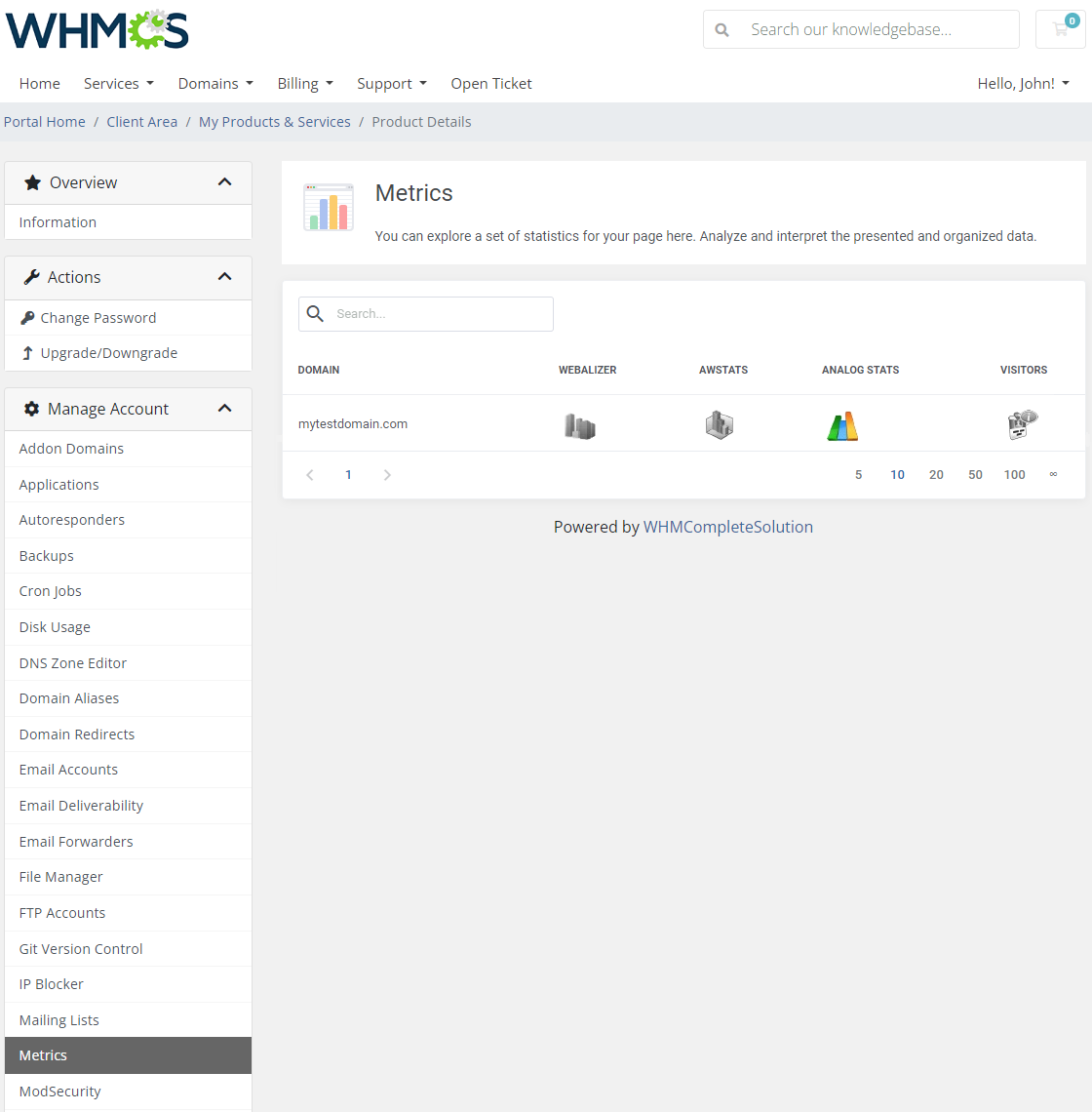
|
MySQL Databases
| MySQL databases are required to run web-based applications such us CMS systems, bulletin boards, online stores etc. Here you can create databases, add new users, connect them with particular databases and manage their permissions. |
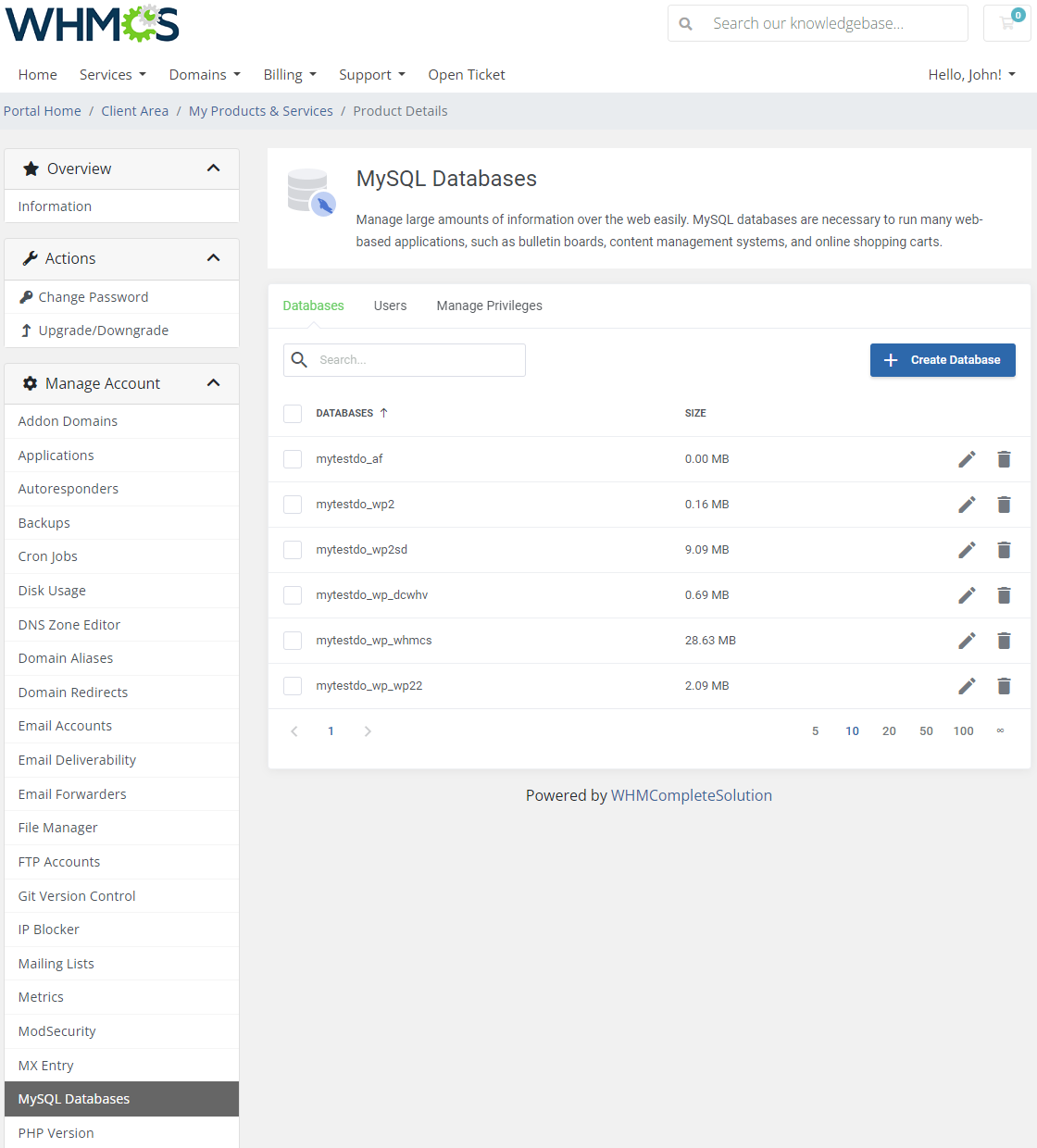
|
MX Entry
| This page enables you to manage your MX records for each of your domains. First, you need to choose the desired domain. |
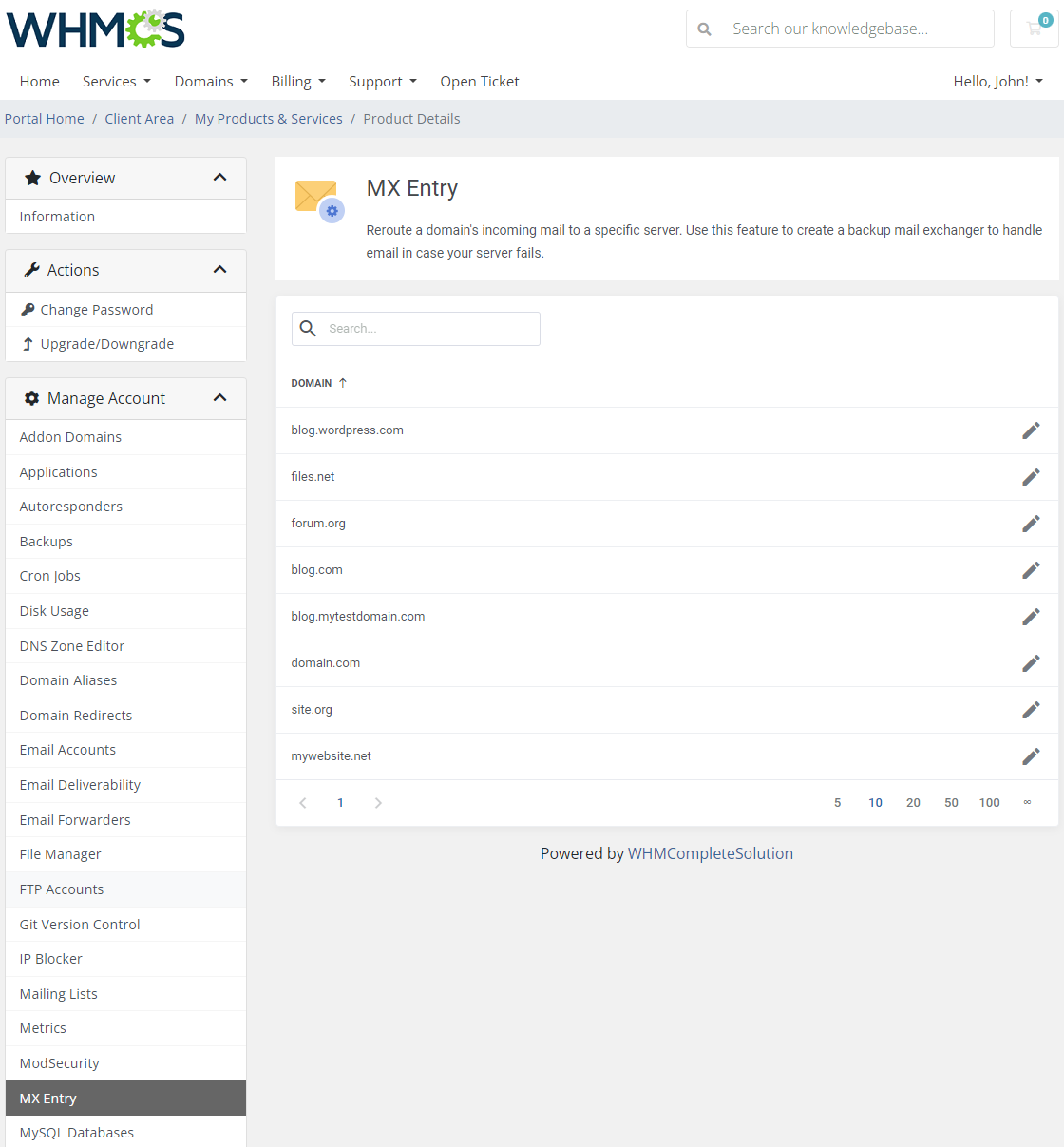
|
| Then, press 'Create MX Record' and define its priority and destination. After creating an MX record, you can add more records or edit and remove the existing ones. |
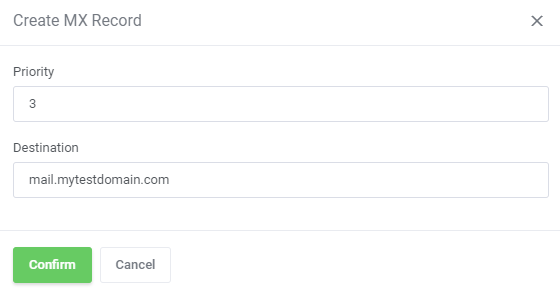
|
PHP Version
| In this section your clients can manage PHP versions of their domains. They are allowed to view a current PHP version of each domain as well as select a new one by clicking the 'Edit' button. Please note that EasyApache 4 is required to permit your clients to handle PHP versions. |
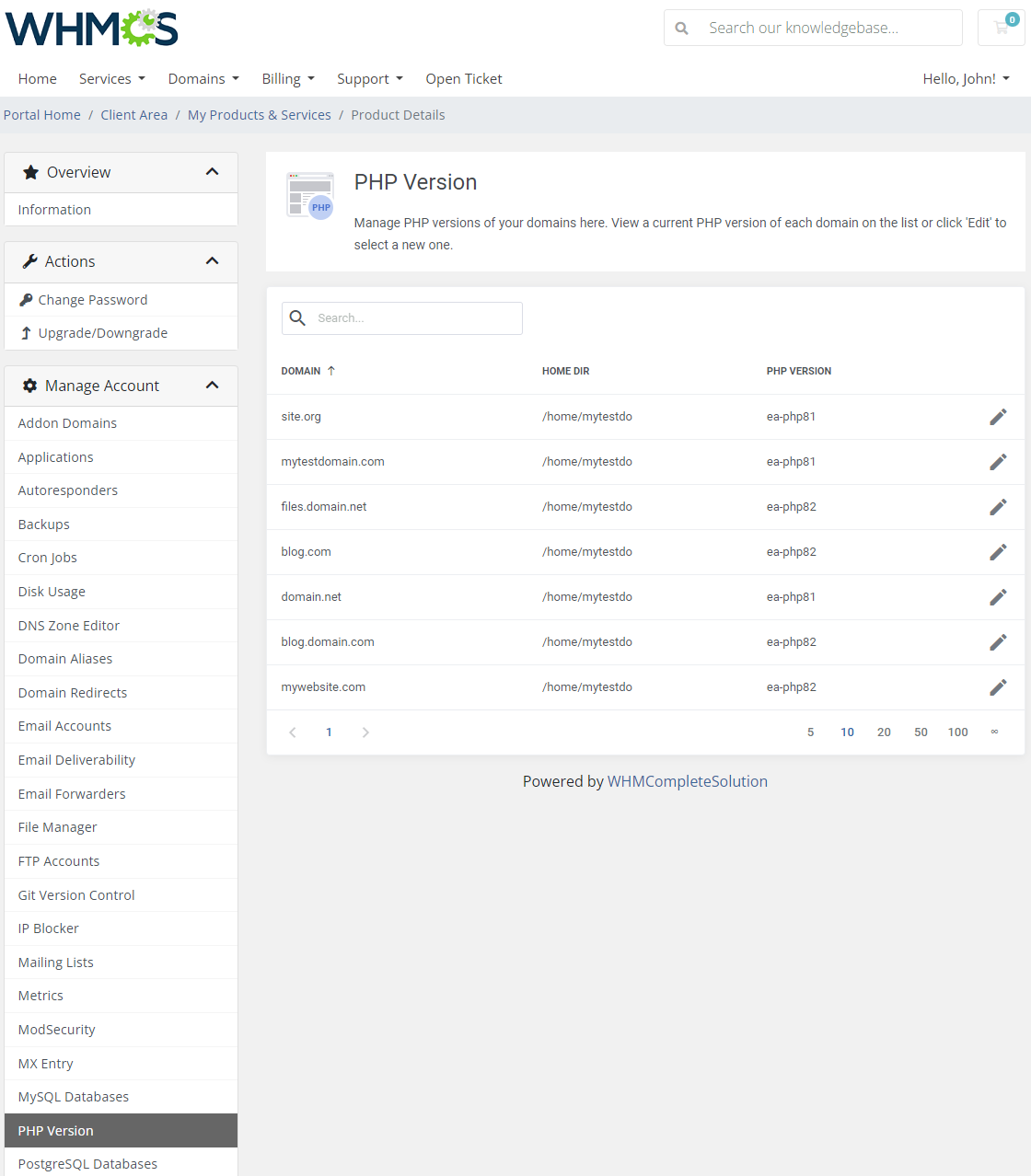
|
If you would like to change the display of the default PHP names in the system to a more user-friendly variant, please locate the language file in:
{yourWHMCS}/modules/servers/cpanelExtended/lang/english.php
An add records according to the system names of PHP versions you want to change. E.g.: $_LANG['phpVersion']['ea-php54'] = 'PHP 5.4'; $_LANG['phpVersion']['ea-php55'] = 'PHP 5.5'; $_LANG['phpVersion']['ea-php56'] = 'PHP 5.6'; $_LANG['phpVersion']['ea-php70'] = 'PHP 7.0'; $_LANG['phpVersion']['ea-php71'] = 'PHP 7.1'; $_LANG['phpVersion']['ea-php72'] = 'PHP 7.2'; |
| The result of those changes will be as following: |
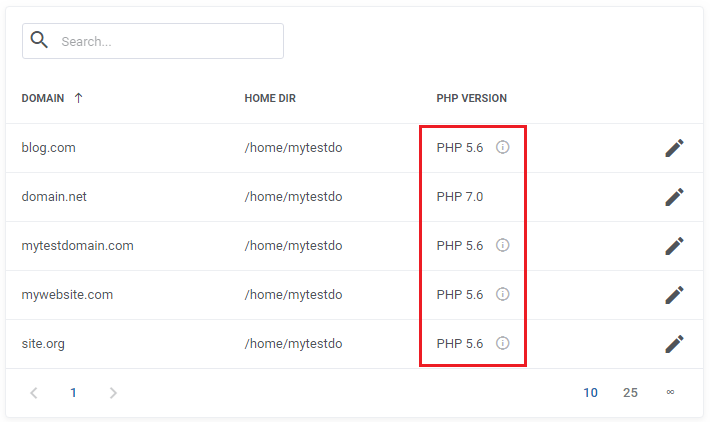
|
PostgreSQL Databases
| PostgreSQL databases are required to run web-based applications such as CMS systems, bulletin boards, online stores etc. Here you can create databases, add new users and connect them with particular databases. |
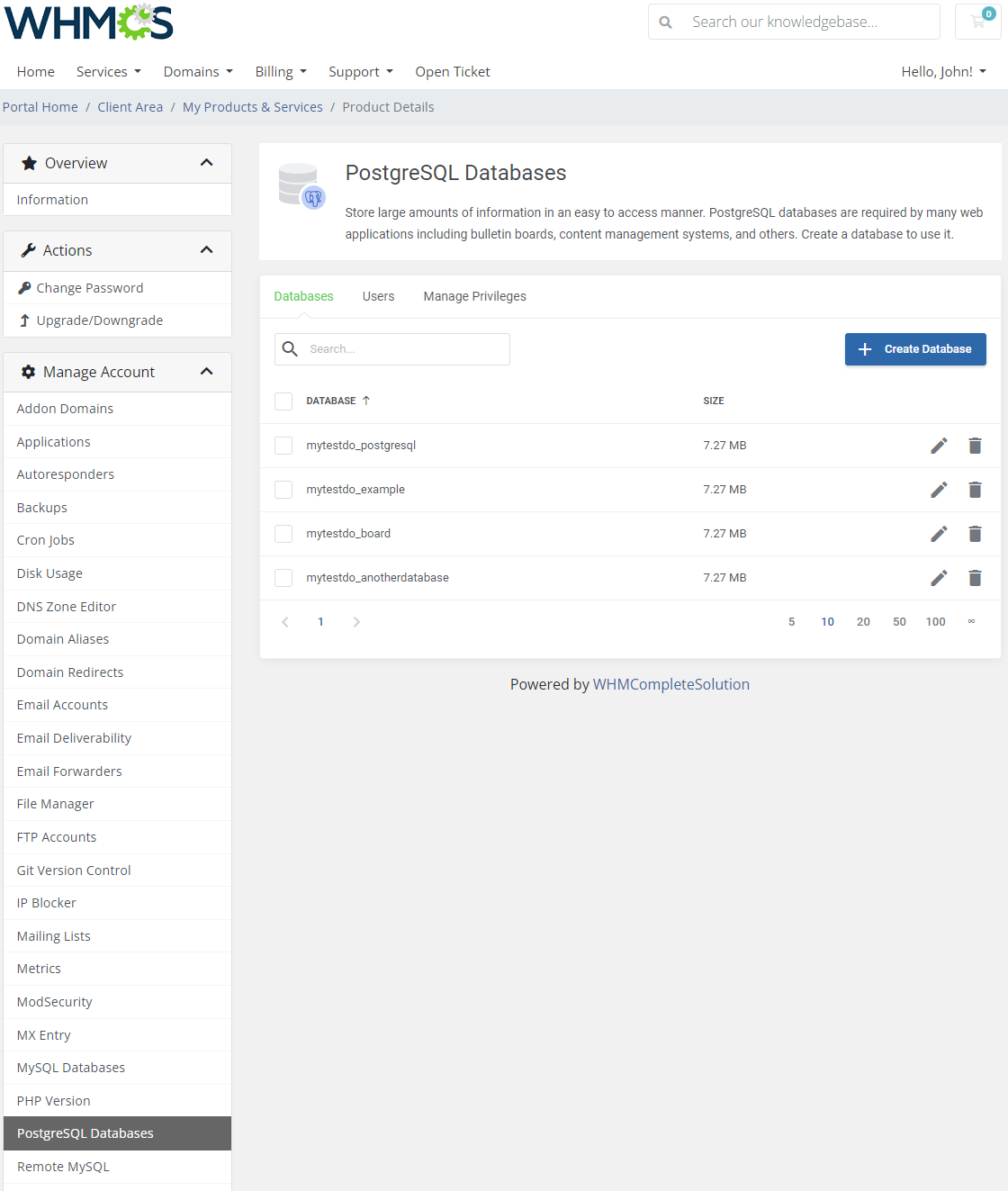
|
| When you create a new user, please be aware that currently there is NO possibility to remove such a user due to cPanel API limitations. |
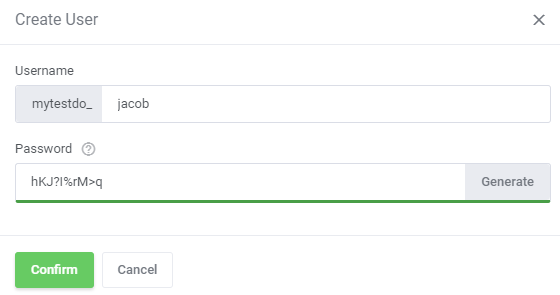
|
| Add the user to the database, the same moment all the privileges will be granted. You can revoke the privileges by removing the user from the database. |
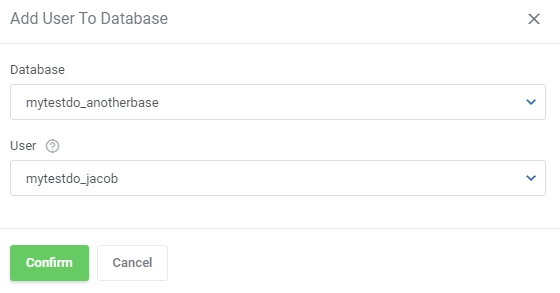
|
Subdomains
| Create subdomains for different parts of your website by pressing the 'Create Subdomain' button. |
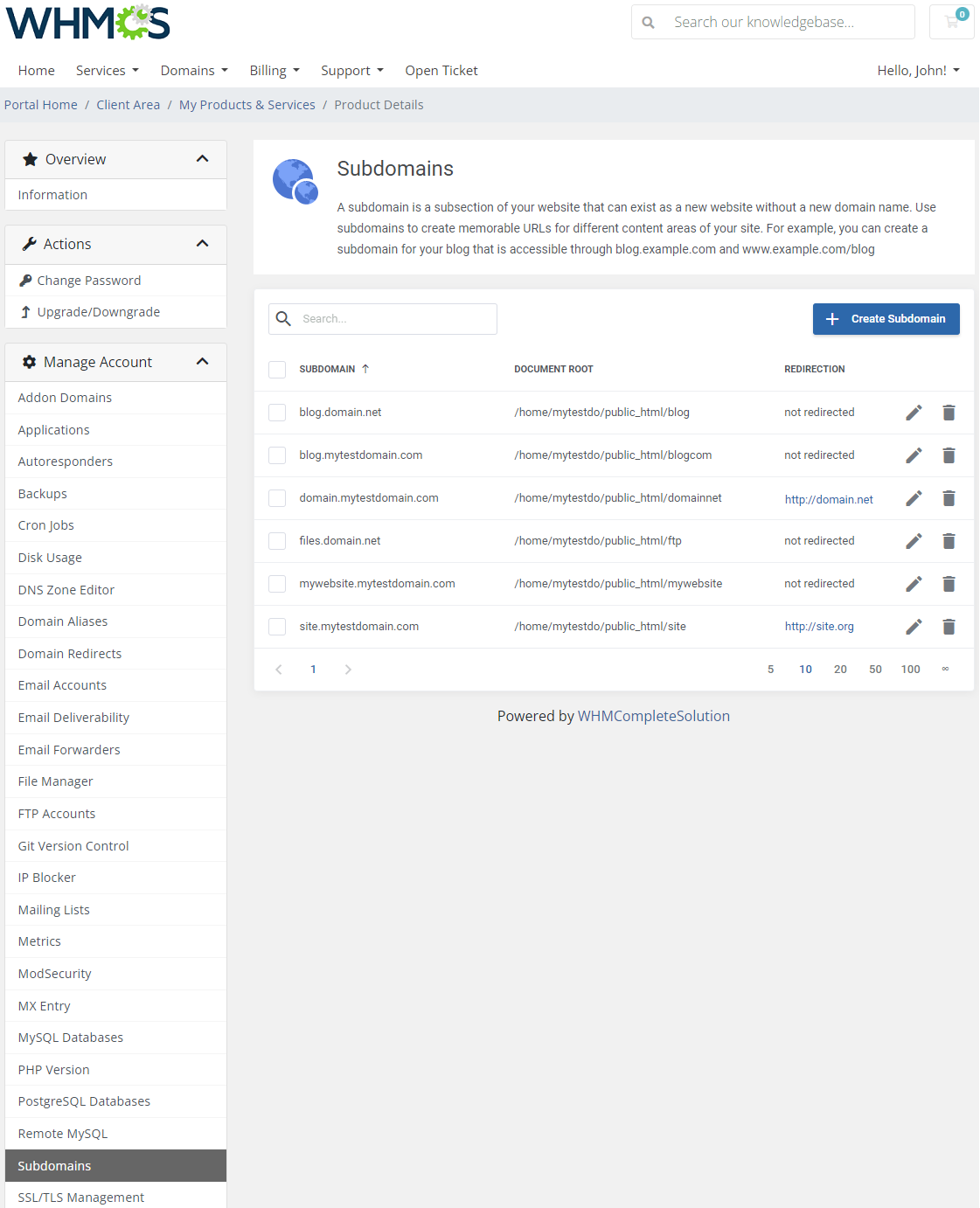
|
| Choose the domain for your available subdomain from the list and provide document root. |
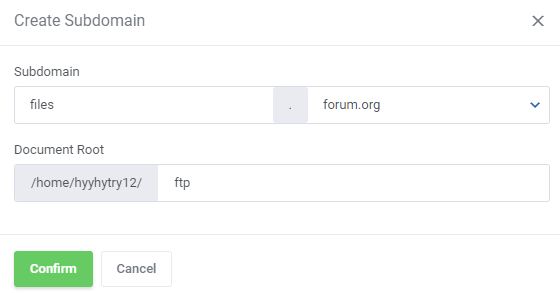
|
| You can redirect or delete the once created subdomains if you wish so. |
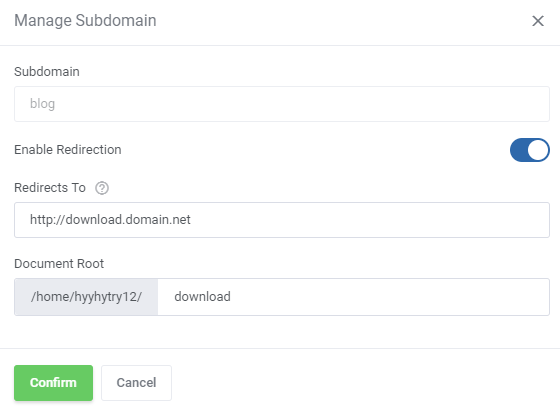
|
SSL/TLS Management
| This feature moves the management of your Private Keys, CSR Keys and SSL Certificates into your WHMCS client area. Generate, upload and install certificates and keys without the necessity of logging in to your cPanel. |
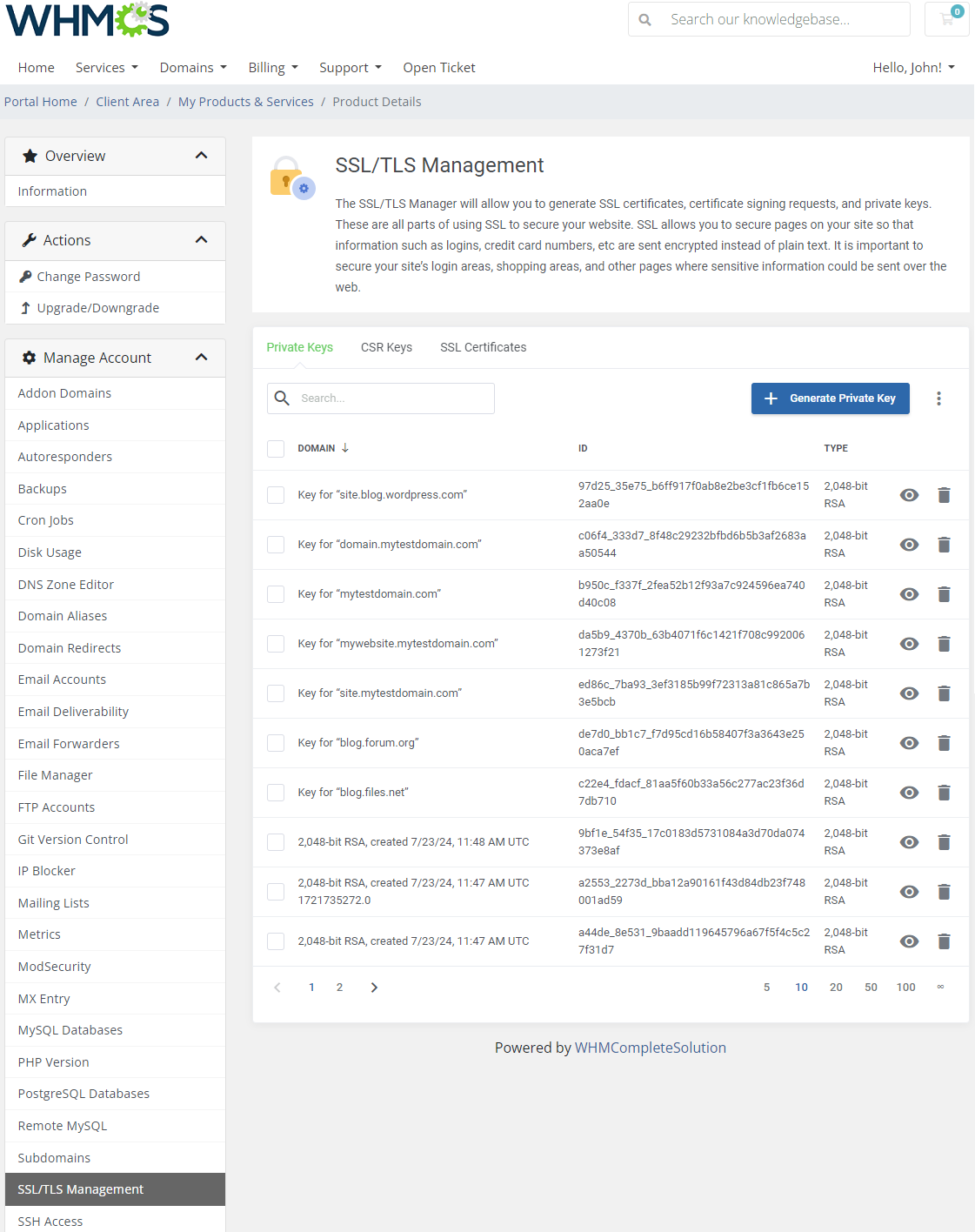
|
SSH Access
| Configure your SSH keys. Create new keys or import your existing keys. Available actions: view, authorize, download or delete key. |
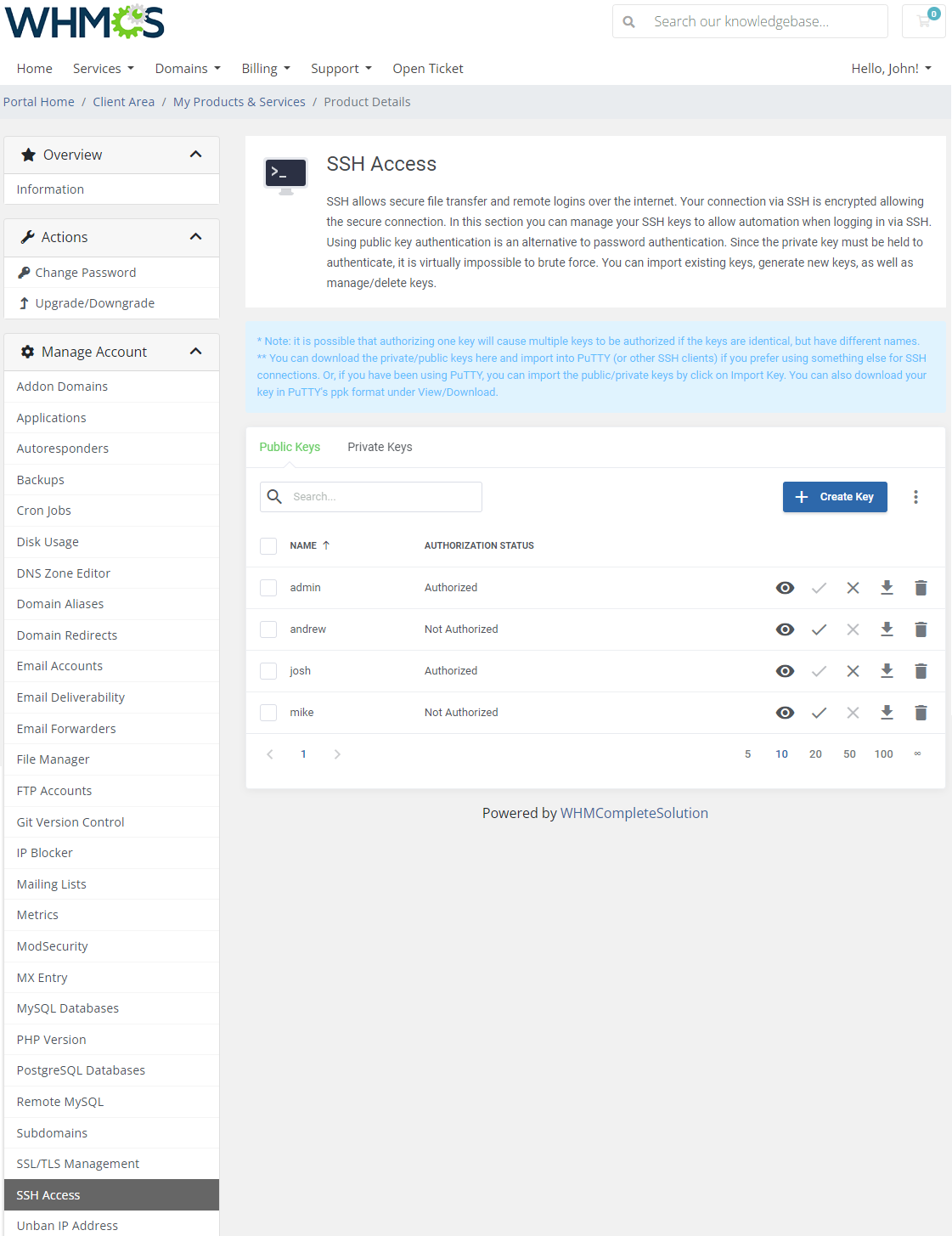
|
Unban IP Address
| Unban IP addresses banned by the system. Your IP is automatically provided in the field and ready to unban. |
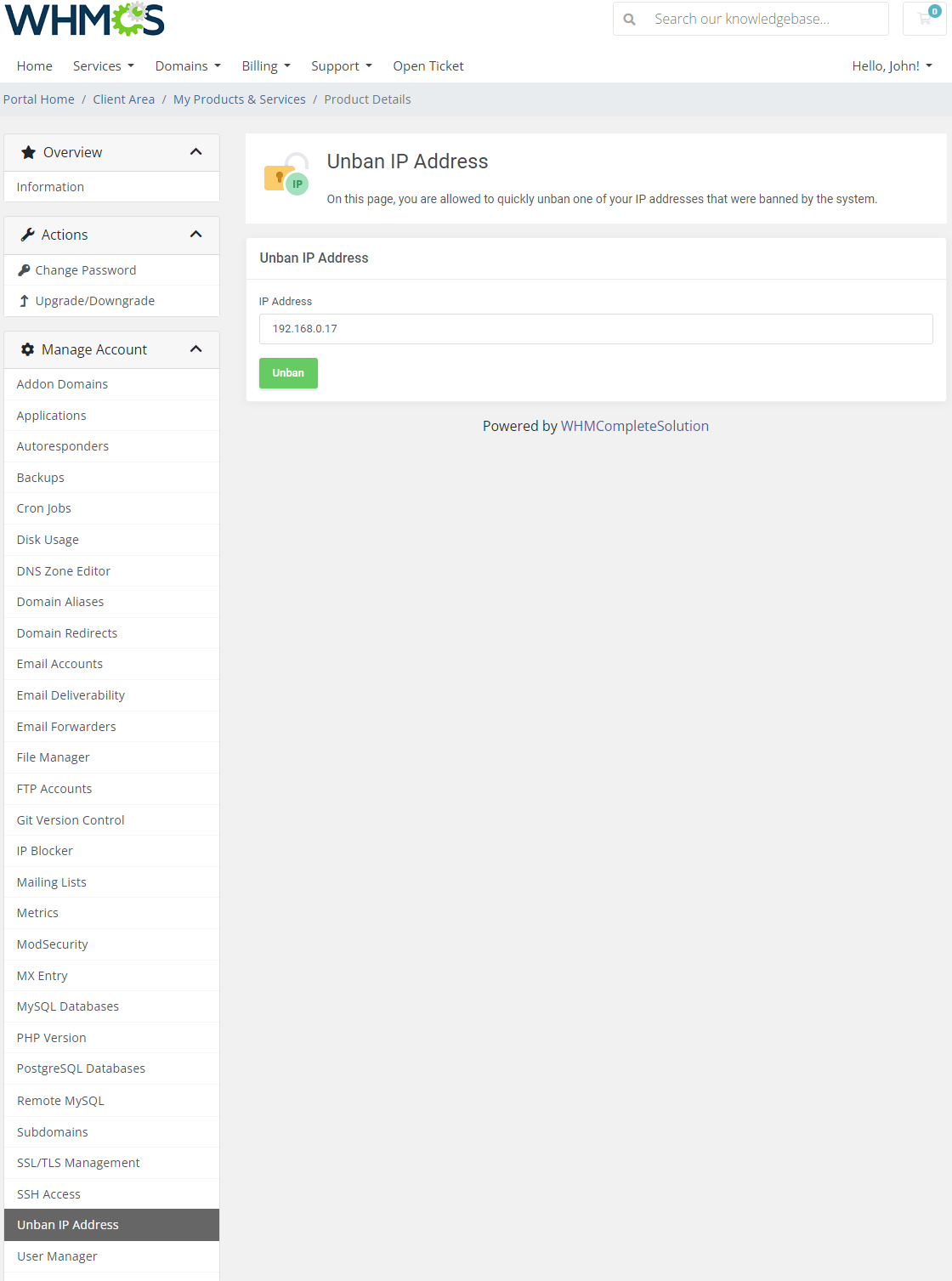
|
WordPress Manager
| If you have WordPress Manager For WHMCS module installed, your customers will fully benefit from its seamless integration with the cPanel Extended For WHMCS module. Important: cPanel Extended For WHMCS is fully integrated with WordPress Manager For WHCMS up to version 1.2.1. |
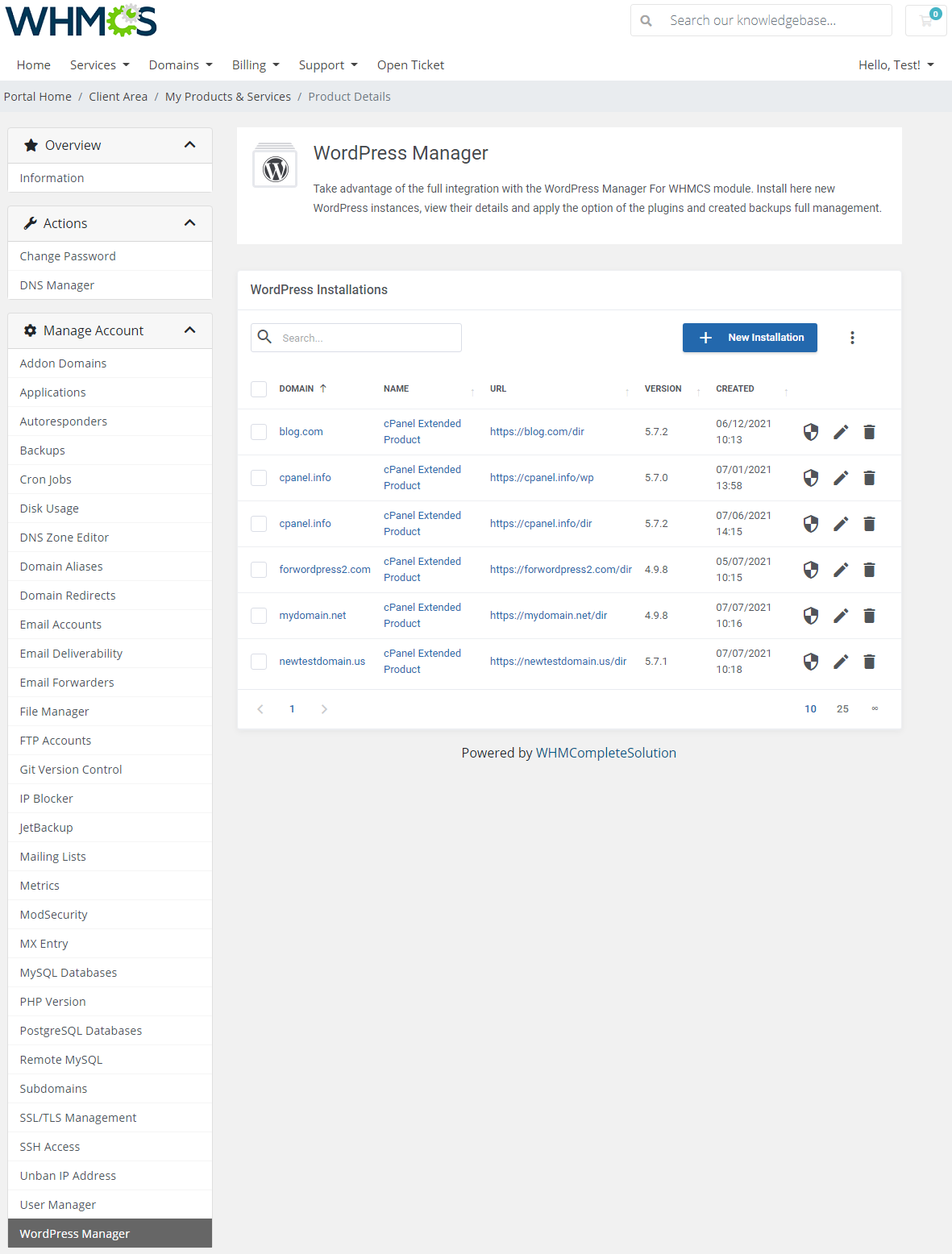
|
| Thanks to this integration, your customers will have the capability to install and manage WordPress instances in detail without the bother of leaving the cPanel Extended panel in your WHMCS client area.
You can find more information about management of 'WordPress Manager' itself here. |
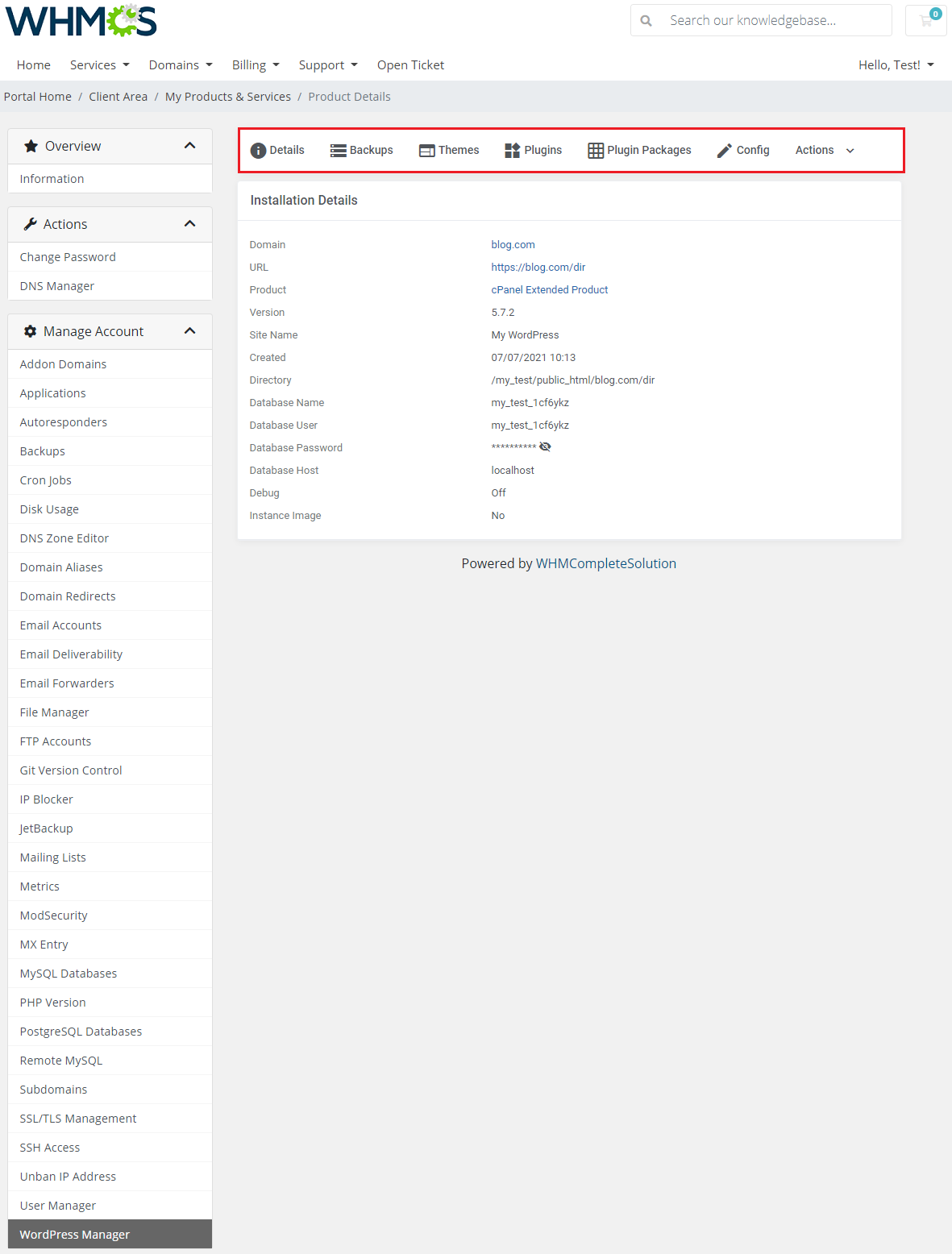
|
| Please note that this entire section can only be available if you have purchased and installed the WordPress Manager For WHMCS module. |
Log In To cPanel
| You can easily log in to your cPanel by clicking 'Log In To cPanel'. You do not even need to fill in your username and password! |
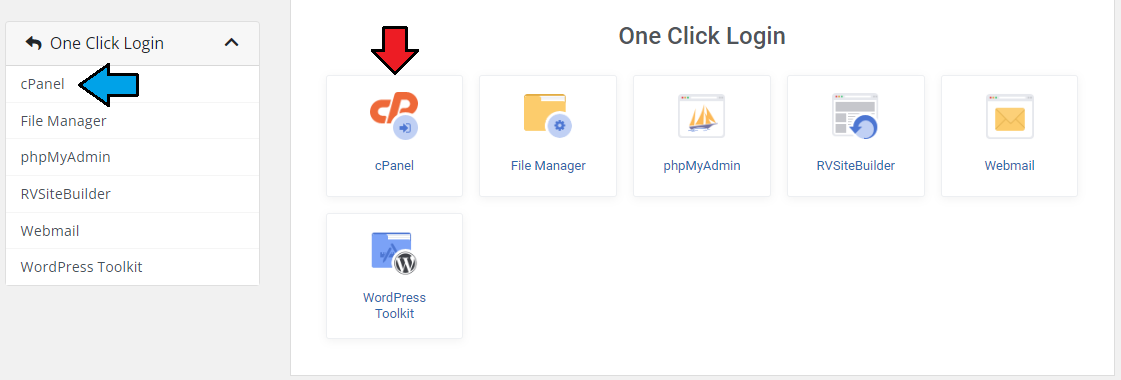
|
Log In To File Manager
| Takes you to File Manager in your cPanel account instantly. |
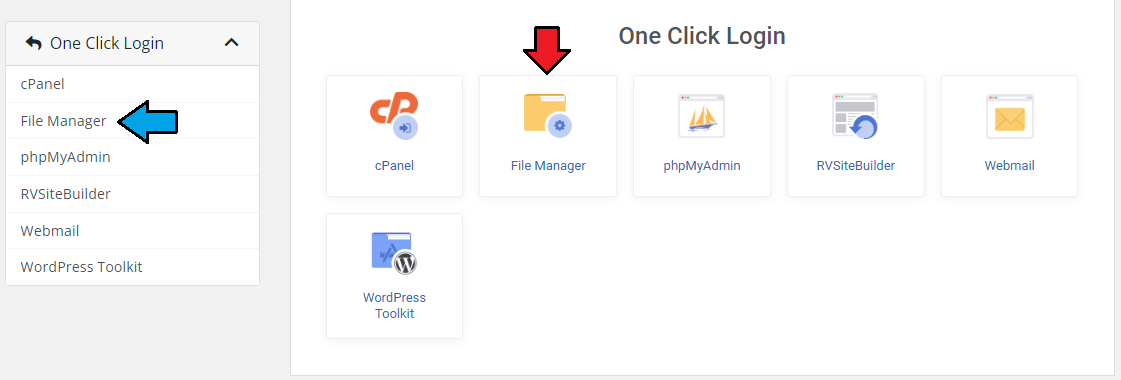
|
Log In To phpMyAdmin
| Get quick access to your phpMyAdmin with just one click. Here, similarly to cPanel login, you do not even need to enter your access details! |
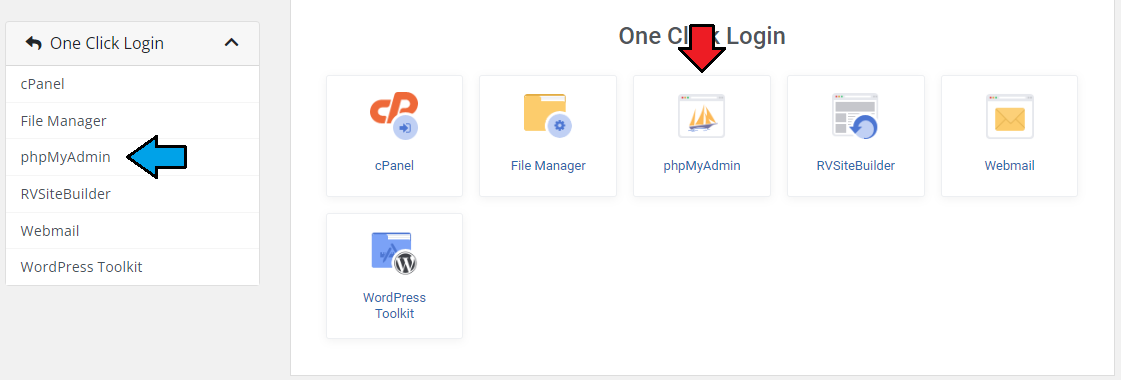
|
Log In To RVSiteBuilder
| One click of the button will also move you immediately to RVSiteBuilder. |
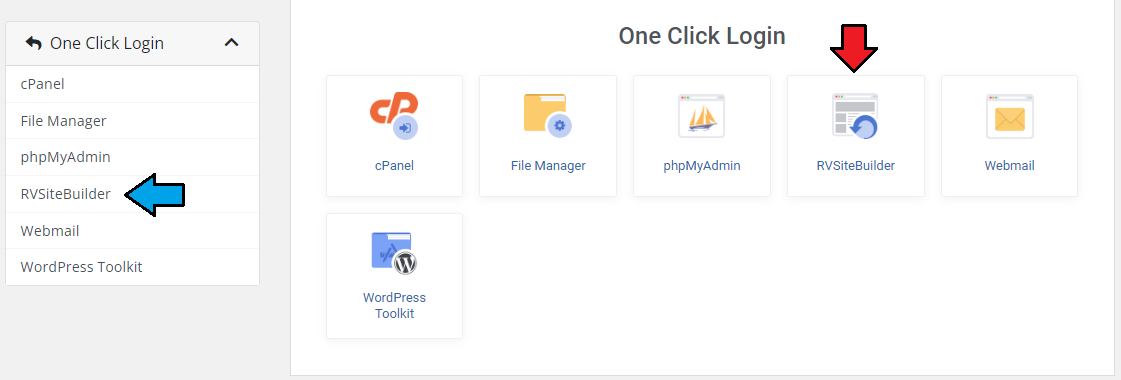
|
Log In To Webmail
| With a single click of 'Log In To Webmail' you can access your Webmail. Please note that Webmail redirection does not automatically log in to the panel. You will have to provide your credentials manually. |
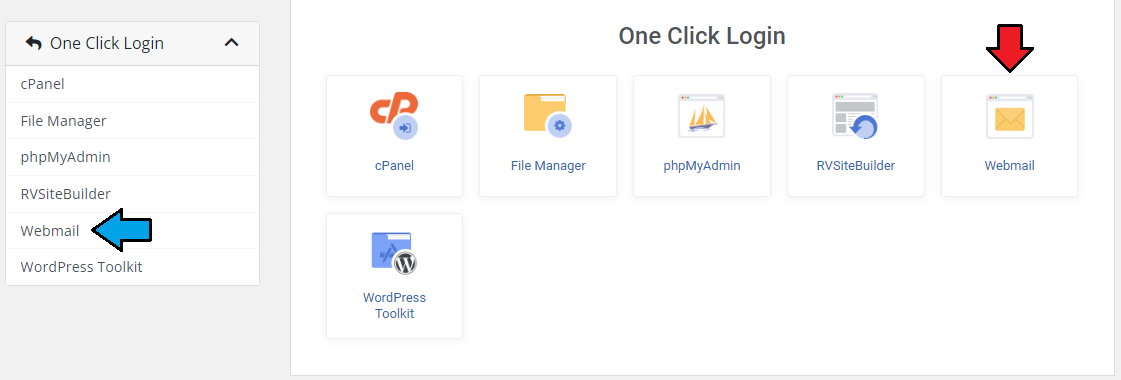
|
Change Password
| You can change the password to both your cPanel and FTP account at the same time. |
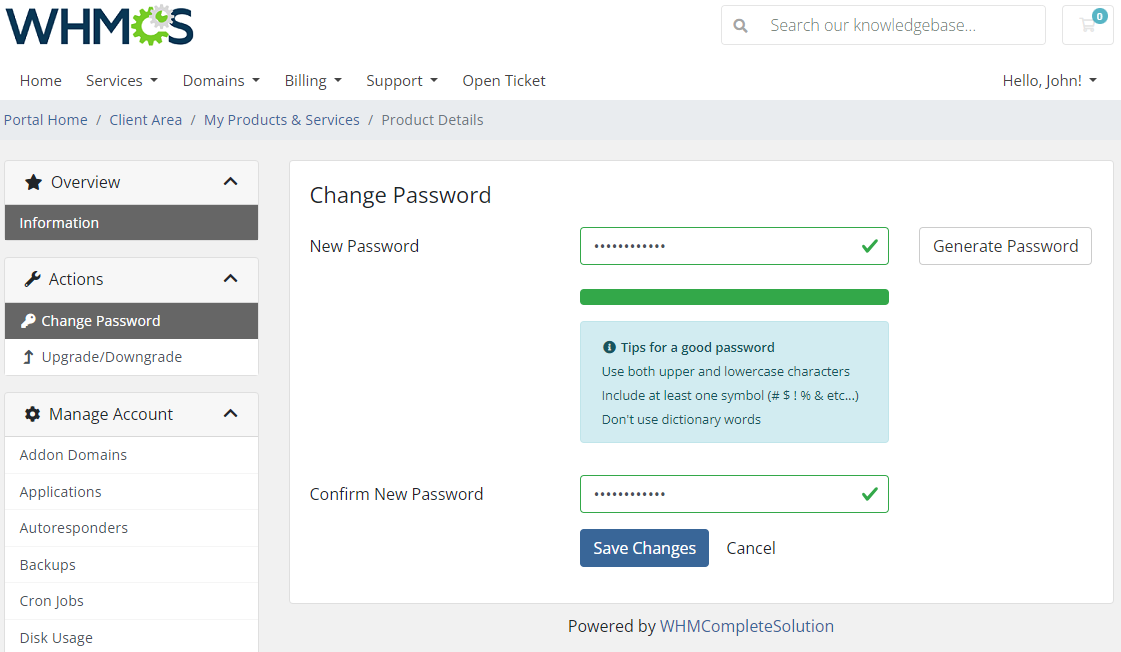
|
Management of Existing Products
| You can easily use cPanel Extended For WHMCS module with your already configured cPanel products. To do so, change the type of servers and module names of products from 'cPanel' to 'cPanelExtended' . |
Management of Billing
| When you combine cPanel Extended For WHMCS with Advanced Billing For WHMCS, you will be able to set up additional billing options. The module allows you to charge your customers basing on the based server resources. More information concerning the usage can be found in the Advanced Billing documentation. |
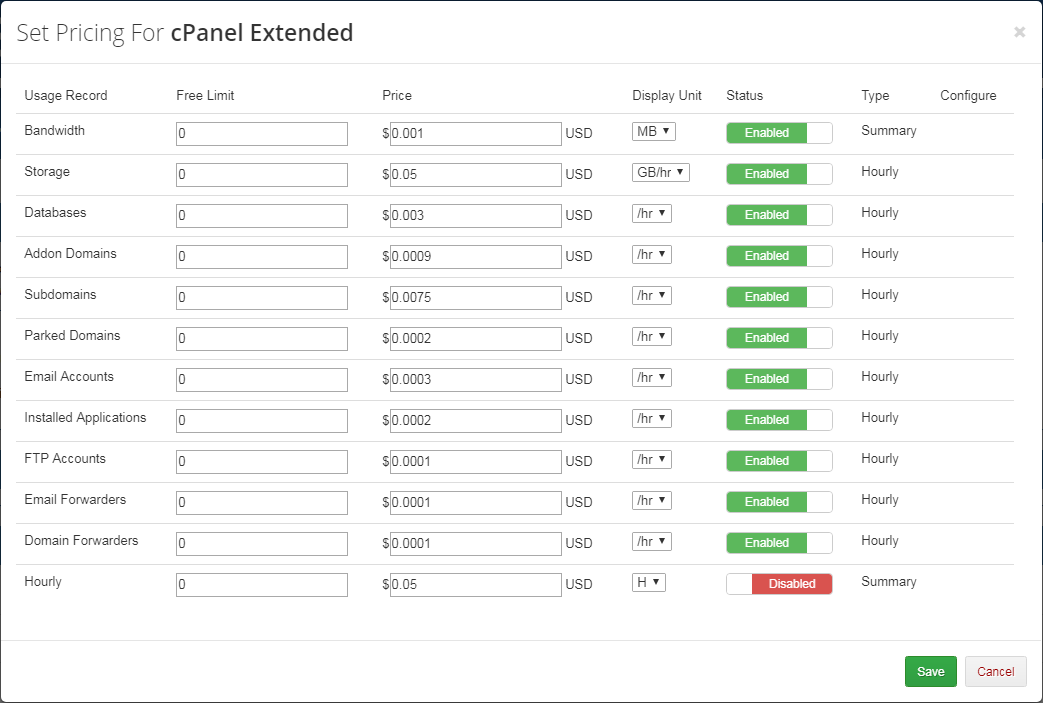
|
| With Advanced Billing module you can also display the current server resource usage, its total cost, and usage records history, as well as set resource reminders. |
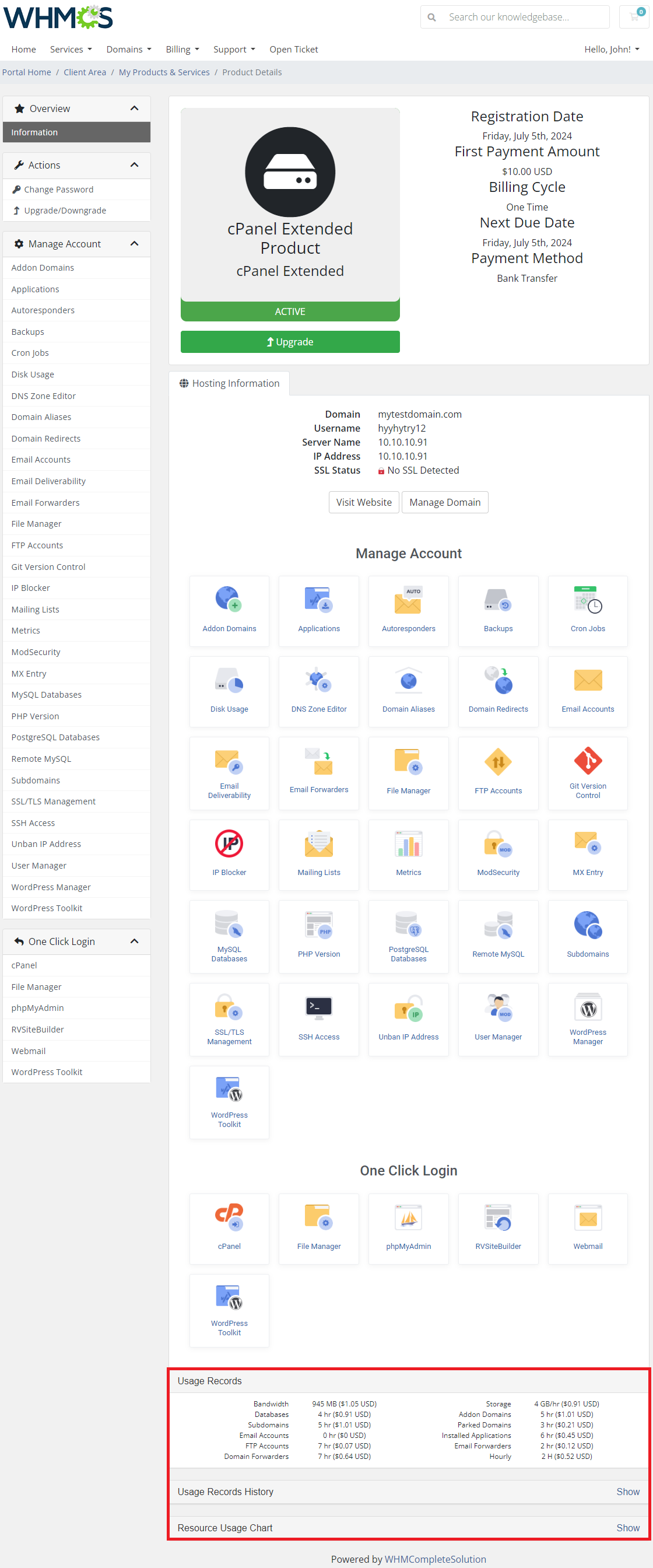
|
Tips
| 1. You can use cPanel Extended For WHMCS with reseller accounts which gives you a lot of new opportunities! To do so, simply go to your cPanel Extended product → 'Details' and choose 'Reseller Account' from a dropdown menu as shown on the following screen. |
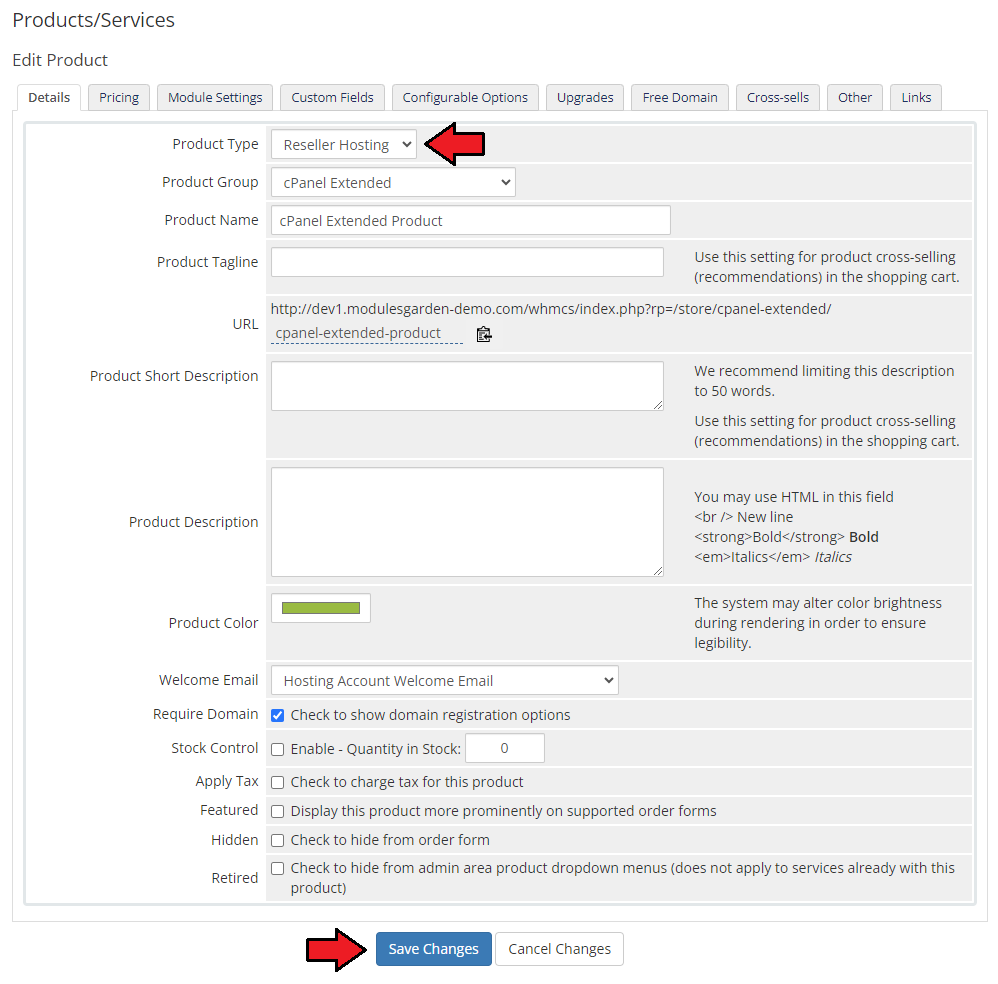
|
| 2. In order to make the reseller own their account, you need to check 'Set the reseller to own their own account' field located in 'Module Settings'. |
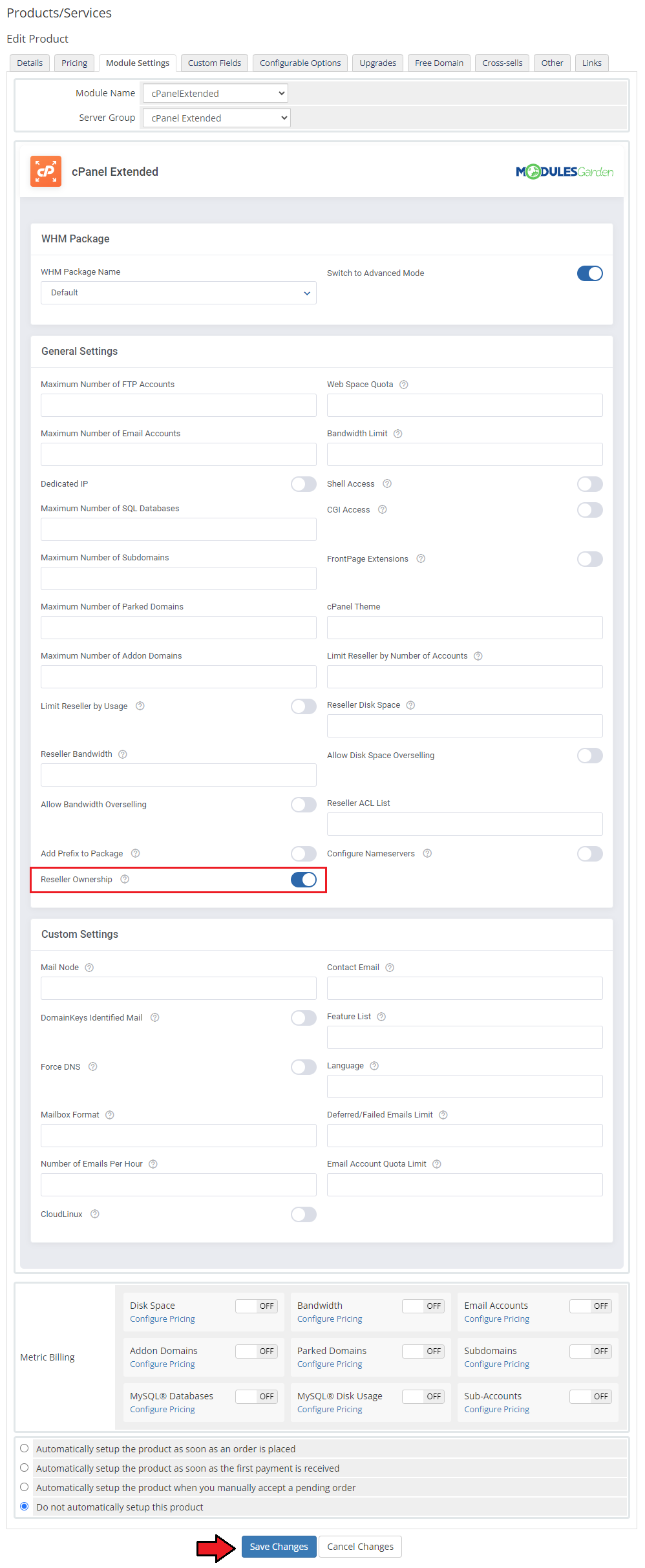
|
| 3. If you would like to use cPanel/WHM Import Utility with cPanel Extended products, you will need to switch the products type to 'cPanel'. Afterwards, you can successfully use the import script. After finishing the import, simply switch back the product type to 'cPanelExtended'. |
| 4. If your users have problems with seeing applications available for installation, you need to log in to WHM and proceed to Softaculous general settings. Choose: Top Scripts (Default) for Default page for End user Panel. |
| 5. As this module supports templates system, any changes made to the module's templates files will be saved after the upgrade process. |
Update Instructions
| Essential guidance through the process of updating the module is offered here. Important: If you are updating the module from any version prior to 3.2.0, you have to activate a new addon and then deactivate the old one.
|
Common Problems
| 1. When you have problems with connection, check whether your SELinux or firewall does not block ports. |
| 2. If you get an ionCube encoder problem (wrong version) after installation, please open a support ticket. We will provide you with a different version of the module encrypted with the older version of ionCube. |
| 3. SQL Issue: When you move your WHMCS system to another domain and you import your SQL database, you may get an error with missing tables or fields. An example of such an error can be: "Unknown column 's.change_password' in 'field list' ". |
| 4. If you have problems with connection, make sure that both ports 2082 and 2083 are open. |
| 5. After you change the language of the module, your Ajax notifications may work incorrectly. Encode language file in UTF-8 (without BOM) to solve this issue. |
| 6. No results to display: Connection problem: This problem occurs when connection to the cPanel server is not configured properly. |
| Reason: Values inside the field/s 'Hostname' , 'IP Address' , 'Username' , 'Password' , 'Type' and/or 'Access Hash' is/are incorrect. Solution: Verify provided details and test connection through pressing the 'WHM' button. |
| 7. No results to display: Wrong hostname or IP value: This problem occurs when connection to the cPanel server is not configured properly. |
| Reason: Values inside the field/s 'Hostname' or 'IP Address' is/are are in the wrong format. Solution: Verify provided details and test connection through pressing the 'WHM' button. |
| 8. No results to display: User or domain not found. |
| Reason: Account with the specified domain name does not exist on the server. Solution: Make sure that customer's details in your WHMCS system contain specified domain name or create a new account. |
| 9. No results to display: Wrong username value |
| Reason: Account with the specified username does not exist on the server. Solution: Make sure that customer's details in your WHMCS system contain specified username or create a new account. |
| 10. No results to display: Access denied |
| Reason: Account already exists on the server but access to the server has been lost due to changed server group, changed server details or is blocked by e.g firewall. Solution 1: Make sure that connection to your server is working properly and it is not being blocked. Additionally, make sure that your server group is set up correctly. |
| 11. User parameter is invalid or was not supplied |
| Reason: Account exists on the server but the username is incorrect. Solution: Make sure that customer's account username is the same in both your WHMCS system and your WHM. |
| 12. When you get 'cURL Error : Maximum (20) redirects followed' while trying to install a new application, this indicates the problem with your cPanel theme. To solve the problem, log in to your WHMCS, go to 'Module Settings' of your product, find the 'cPanel Theme' field and make sure that the entered name is correct. |
| 13. Blank page while logging into phpMyAdmin or any functionality in 'Stats' page. |
| Reason: Logging in requires SSL connection. Solution: Check 'Secure' in your server settings for cPanel (step 11th of Installation and Configuration). |
| 14. Running 'Create' on cPanel Extended product does not create application ordered along with product. Reason: Some applications require additional fields during installation (other than those available in the product custom fields). |
| 15. In case you encounter a problem with notification: 'Something goes wrong, check logs, contact admin.' please clear your cache first before taking any other steps as it might solve the problem. |
| 16. cPanel Extended For WHMCS does not support Application Links. |
| 17. If you see any missing language entries e.g. for applications installer, you can add them manually in the language file. Simply open the '{yourWHMCS}/modules/servers/cpanelExtended/lang/english.php' file, insert the missing entry to it and add your own translation, following the example of the other records. |
| 18. 'Domain is invalid' - displayed while trying to create a new addon domain. |
| Reason: Used TLD is not supported. Solution: Please check whether the used TLD is present on the list of supported TLDs in the file: '/modules/servers/cpanelExtended/core/Config/tldList/tld.list' |
| 19. 'Unexpected Module Error(Token 'f80e57b1be9752d7d4344672d55aafa2'). Please Contact Administrator.' - error displayed in the client area. |
| Solution: Reissue your license in our client area, if that does not help, please contact our support department. |